Australian
and international
exploratory
performance and
media arts
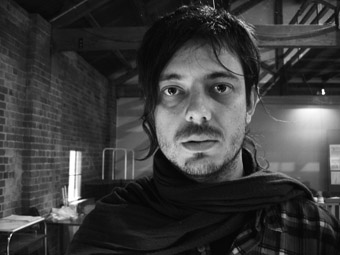
Benedict Andrews
photo Pia Johnson
Benedict Andrews
Benedict Andrews has proven himself to be the most consistently interesting and challenging theatre director in Australia. His totality of vision creates immersive theatrical worlds that seamlessly merge passion, intelligence and a heightened visual sensibility.
Most satisfying is the rigour with which Andrews and his collaborators generate design, media and character motifs which evolve and mutate with a frightening logic (the drinking in Who’s Afraid of Virginia Woolf? becomes a flood of ice and spilled liquids underlining emotional abjection; the glass wall between performers and audience in Eldorado fluctuates between windows on the home and a world at war—one nightmarishly unspecified).
Marked physicality—whether realised as utter stillness (Cate Blanchett as Richard II in The War of the Roses) or panicky desperation (everyone in Moving Target)—is characteristic of the director’s work, again with a strong pictorial, even choreographic awareness.
A sense of immediate contemporaneity is also evident, not least in plays chosen from the past. In Andrews’ production of The Season at Sarsaparilla 1960s Australia is meticulously evoked but as if seen through the eyes of Reality TV’s Big Brother, with cameras installed within the set to provide close-ups both amusing and chilling. The director’s account of Shakespeare’s Measure for Measure for Company B takes this surveillance motif even further. The sense of a shared present is also evident in Andrews’ engagement with violence—whether in his realisations of the psychotically closed worlds of Mr Kolpert or Fireface or the unidentified wars offstage in Eldorado or The City or the explicit ones in The War of the Roses.
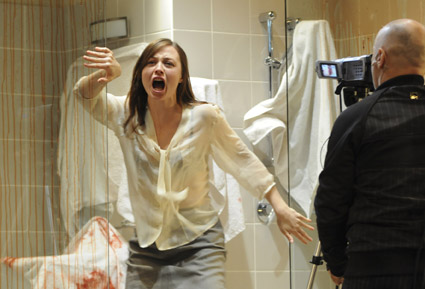
Robin McLeavy, Arky Michael, Measure for Measure, directed by Benedict Andrews
photo Heidrun Löhr
Robin McLeavy, Arky Michael, Measure for Measure, directed by Benedict Andrews
Facilely criticised in some quarters for being party to a ‘director’s theatre’, in “Directors + playwrights: the living & the dead,” Andrews took exception to an attack on young directors by playwright Louis Nowra: “I work with living writers and dead ones. I do not breathe some sigh of relief as Louis Nowra might imagine when working on a classical text as if I were suddenly free to dance on the playwright’s grave. Each project is demanding and all consuming and I enter it with questions and fantasies I want to explore with the community of people I work with and the audience who will watch our work.”
Benedict Andrews was born in Adelaide in 1972, graduated with First Class Honours in Bachelor of Arts from Flinders University Drama Centre, directed locally, including a stint as artistic director of Magpie2 for the State Theatre Company of South Australia. Magpie, formerly a Theatre in Education company, was now boldly targetting the 18-25 year-old demographic but Andrews had barely made his nonetheless palpable mark before Australia Council funding was withdrawn (Murray Bramwell, “A future or a blown youth?,” RT 23, p9, not yet available online).
In 1996 Andrews wrote for RealTime (RT 16, p6, not available online) about the experience of seeing works by Robert Wilson, Pina Bausch, Peter Stein and Robert Lepage, as well as Polish and Japanese performance, at the Edinburgh Festival and Fringe. In 1998 he was awarded the Gloria Payten & Gloria Dawn Fellowship which he used to travel to Europe as well as New York. His New York report for RealTime (“Looking for Elsewhere,” RT 30, p34) included a vivid account of the hard-edged performance style of the work of Richard Maxwell—perhaps an influence. What Andrews’ writing revealed was a young Australian theatre director’s welcome and rare openness to new forms and diverse performance languages.
Andrews went on at various times to work as assistant director to Neil Armfield, Michael Gow and Jim Sharman and was appointed resident director of the Sydney Theatre Company 2000-2003. Since then he has created productions for Malthouse, Sydney Theatre Company and Company B. He directs annually in Australia and at Berlin’s Schaubuhne am Lehniner Platz (see reviews of his Berlin productions of Sarah Kane’s Cleansed and David Harrowers’ Blackbird) and presently lives in Reykjavik, Iceland.
Andrews will direct King Lear at the National Theatre of Iceland in Reykjavik in December this year and the Monteverdi opera The Return of Ulysses for the Young Vic and English National Opera in London in 2011. His production of Mozart’s The Marriage of Figaro for Opera Australia is now scheduled for 2012. According to an article in the Sydney Morning Herald, Andrews also has film projects in mind and is to have his poems published in Blast magazine.
In the same interview, Andrews said of Measure for Measure, “I want to stage it like a psycho-sexual thriller, like a David Lynch film…the play is very much concerned with desire and law and strange doubled realities, with another reality seeping through another reality” (June 2, www.smh.com.au/entertainment). Our review of Measure for Measure will appear in the July 12 RealTime online edition and in the RT 98 print edition.
A substantial list of reviews of Andrews’ productions appears below along with an interview and two examples of the director’s writing. One of these is an introduction to the work of Christoph Marthaler, a European opera and theatre director greatly admired by Andrews and written in anticipation of the staging of Marthaler’s Seemannslieder for the 2007 Sydney Festival.
Benedict Andrews has created many memorable works, not all of them perfect but sharing a boldness of vision and a recognisable evolving personality. His productions of Marivaux’s La Dispute (in Timberlake Wertenbaker’s far from funny version of the comedy), Mr Kolpert, Fireface, Who’s Afraid of Virginia Woolf? and Caryl Churchill’s Far Away seem as vivid in my recollections as when I saw them. But it’s The Wars of the Roses and, above all, The Season at Sarsaparilla that have made the deepest mark, for the scale and fidelity of their vision. The hugely popular production of the Patrick White play and its critical success laid to rest the “directors’ theatre” debate. As James Waites has argued (see full article) it revealed the work to a be a classic of Australian playwrighting and the production worthy of an international audience.
There’s much more that could be said of Benedict Andrews—about the influence of contemporary performance, of media culture, of German theatre (via English engagement with German plays but also directly and in collaboration with German artists) and the evolution of a very particular design sensibility (working with a small, recurrent group of designers), at first glance very European, but as in The Season at Sarsaparilla, totally and radically responsive to our sense of the past as viewed through the present.
Keith Gallasch
artist website
www.benedictandrews.com
reviews
degrees of pathos
keith gallasch: marius von mayenburg’s fireface, 2001
the arts of ageing, the limits of vision
keith gallasch: beatrix christian’s old masters, 2001
tough nights at home
keith gallasch: david gieselmann’s mr kolpert, 2002
benedict andrews: self, style &vision
keith gallasch: calderon’s life is a dream, 2002
beckett-land: spirit and letter, stage and screen
keith gallasch: beckett’s endgame, 2003
once upon the here and now
keith gallasch, caryl churchill’s far away, 2004
sarah kane in berlin
adam jasper smith: sarah kane’s cleansed, 2004
sydney performance: killer logic
keith gallasch: julius caesar, 2005
two ways of looking at blackbird
daniel schlusser, david harrower’s blackbird, 2006
strange words, alarmingly familiar
keith gallasch: marius von mayenburg’s eldorado, 2006
shocking symmetries
keith gallasch: albee’s who’s afraid of virginia woolf?, 2007
another time now
keith gallasch: the season at sarsaparilla, 2007
adelaide festival: the games art plays
keith gallasch & virginia baxter: moving target, 2008
the war within, the war without
keith gallasch: the war of the roses, 2009
violations: sex, history, form
keith gallasch: martin crimp’s the city, 2009
interviews
the luminous nightmare of marius von mayenburg
keith gallasch: benedict andrews on el dorado, 2006
inside looking out
keith gallasch talks with marius von mayenburg, 2008
writings
directors + playwrights: the living & the dead
benedict andrews replies to louis nowra, 2001
christoph marthaler: in the meantime
benedict andrews on a great european director, 2006
related article
wunderkind mysteries
john bailey: melbourne performance, 2010
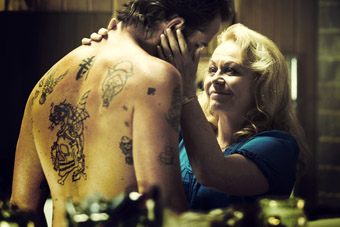
Sullivan Stapleton and Jackie Weaver, Animal Kingdom
FROM THE OPENING SCENE, ANIMAL KINGDOM GRABS YOU BY THE SCRUFF OF THE NECK AND GIVES YOU A GOOD SHAKE. UNRELENTING, IT PULLS YOU IN TO A MOTHER’S DEN OF A SUBURBAN UNDERWORLD, WHERE YOUNG CRIM BROTHERS FIGHT EACH OTHER AND A BUNCH OF RATBAG COPS TO SURVIVE.
David Michôd (formerly mild-mannered editor at IF Magazine) is a VCA graduate with connections to the Edgerton brothers, having co-written a number of shorts with Joel and Nash before directing his breakthrough Crossbow (2007), which won the Melbourne International Film Festival award for Best Short Film with screenings at Venice, Sundance and Clermont-Ferrant. The development process for Animal Kingdom was a slow boil, taking nearly 10 years to craft the screenplay (based loosely on Melbourne crime stories) and every frame settles into your psyche, with a muted violence and sense of unease; a brilliant psychological drama.
Michôd couldn’t have hoped for a better ensemble to bring his take on corruption and crime in Melbourne’s suburbs in the 80s to life. All performances are note-perfect. With its positioning of men always on the brink, coiled and ready to spring, set around a quietly manipulative mother, the film recalls Rowan Woods’ The Boys. It also acts as an antidote to the hyped up razzamatazz of Underbelly, a show that dumbed down as it left Melbourne becoming less interested in character as it wore on to its second and third series. Animal Kingdom works on another level entirely. Michôd is not so much interested in the stylistic shoot-em-up and tits’n’arse life of the petty crim as in the internal spaces negotiated in a family where criminality has become entrenched, the degree of loyalty within when things become compromised, the lull when every character has begun a moral slide.
Rather than a seedy-glam look at the crimes, we’re thrust into a world in transition where the men themselves sense a shift: Barry (Joel Edgerton), settled with wife and child, wants to escape the game altogether while Craig (Sullivan Stapleton) is too caught up in the paranoia of his speed-haze to be able to read situations readily. And no-one does menace like Ben Mendelsohn. As ‘Pope’, he’s mesmerising, and every time his blue-grey Hawaiian shirt comes into frame (and it’s often what you see before his face), the tension both on screen and off escalates and the audience squirms. His ability to intimidate is not about large outbursts of violence but quiet moments of stalking. Using cat-and-mouse tactics, he tries to goad the truth out of others (accusing Luke Ford’s Darren of being gay because of the type of drink he pours), in a tone that belies his desperation to be the head of the family, the one to turn to as confidante: “Any time you want to talk to someone,” he intones smoothly, as they move past him and head out the door.
Newcomer James Frecheville as 17-year-old Cody, thrown into the family after his mother OD’s, is large and immobile, his face registering not much—an asset, he soon discovers. He looks older than his years but his sensitivity is revealed in the way he treats his girlfriend Nicky (another impressive debut performance from Laura Wheelwright) and longs to be a part of her family.
Reigning over these tall and physically imposing men is the diminutive ‘Smurf’ (Jacki Weaver), her cute nickname covering for a woman who will do anything to protect her brood. There’s a faint whiff of fear in the air as she manipulates her men with cuddles and long, lingering kisses on the mouth, positioning her body in a way that suggests she still sees them as small boys (and their behaviour can be reduced at times to that too). As ‘J’ says in voiceover, his uncles are men who—at the heart of it—are afraid, but too scared to show it. In a nice twist, only the cop, Detective Leckie (Guy Pearce), does not live in a world ruled by fear (although his colleagues, on the take, clearly do).
Animal Kingdom is a brilliant and exciting feature debut for David Michôd. The film’s title cleverly reminds you that, stripped of their clothes, their bravado, their posturing, these men are like lost creatures, products of their environment; it’s do or die. The complexities of character, the evocation of an era, the subtle acting, the deliberate camera, the sense of a community dying out—these all signal a director of great natural skill with an intimate knowledge of filmmaking (and the ability to relay this to his cast and crew) making Animal Kingdom one of the most dynamic films of recent years, and one for repeated viewing.
Animal Kingdom won the Dramatic Jury Prize for World Cinema at the Sundance Film Festival and is currently in national release.
Animal Kingdom, writer, director David Michôd, producers Liz Watts, Bec Smith, director of photography Adam Arkapaw, editor Luke Doolan, production designer Jo Ford, composer Antony Partos, sound designer Sam Petty
This article first appeared online, June 28
RealTime issue #98 Aug-Sept 2010 pg. 29
© Kirsten Krauth; for permission to reproduce apply to realtime@realtimearts.net
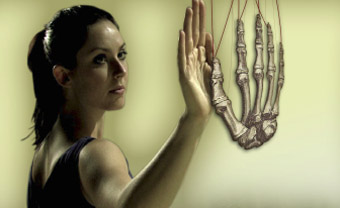
Rachelle Hickson, Reading the Body, Sue Healey & Adam Synott
SUE HEALEY AND ADAM SYNOTT’S READING THE BODY APPEARS ON A SUSPENDED SCREEN IN THE CENTRE OF THE IO MYERS STUDIO, DRAWING THE VISITOR INTO THE DARKENED SPACE. ATTENTION IS HELD BY ITS ELEGANT JUXTAPOSITION OF A MOVING FEMALE PERFORMER (RACHELLE HICKSON) OVERLAID WITH SKELETAL ANIMATIONS THAT ATTACH THEMSELVES TO THE DANCER’S BODY.
New Zealand poet Jenny Borholt’s text provides more layers: “The body as intention. It means well. Is full of good intent. Body as desire.” It’s a fittingly elusive and alluring entrée to the experience of GESTURE, part of ReelDance 2010, a screen-based exhibition running across the UNSW Kensington Campus and, according to the notes, “exploring the performance territory between dance, the everyday and dramatic body.”
Curator Erin Brannigan writes, “Choreography can play with our knowledge of gestural performance, occupying the space between walking and dancing, action and elaboration, communication and expression…These works take the choreographic manipulation of gesture further by spreading the performances across screens, dislocated spaces, manufactured locations and defamiliarised temporalities.”
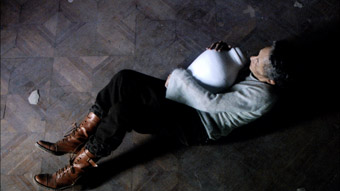
Anna Mittel, Promise of Fallen Time, Isabel Rocamora
Isabel Rocamora’s video Promise of Fallen Time beckons from a curtained corner of the studio, compelling us to follow the full 19 minutes of its sombre scenario. We are led inside a derelict building, which might be an antechamber to the underworld. A slightly built but powerfully intense performer (Anna Mittel) advances tentatively through this grey world. Her movements are minimal but precise, appearing at times almost involuntary. She encounters a man (Enric Majo) and together they navigate the surfaces of this place (a derelict palace in Barcelona as it turns out), appearing sometimes to be propelled along its walls. Where they’re heading is unclear but the sense of foreboding is palpable, enhanced by the sound of a soft gong and whirring, thrumming chords. A door opens to reveal a young boy with a large dog. The frame freezes. The world turns and we begin again with the two dancers in another place, another time. I head for the light.
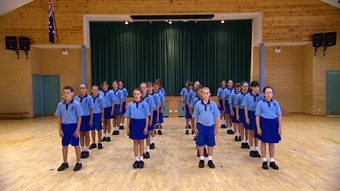
Assembly, Kate Murphy
Positioned in a triangle of monitors above head height as well as on a single monitor over the lift, Kate Murphy’s Assembly takes its place in the West Foyer of the Australian School of Business.
Twenty-four children in school uniforms stand in four rows inside a school hall. From time to time their arms move sideways or clutch at their hearts, hands inscribe crosses on their chests. The rhythms of the children’s gestures and their wobbly stillness fit neatly into the fabric, subtly shaking the bland edifice they occupy
I read in the program that these children are moving in response to “reflection exercises” being read from prayer cards that are used daily in the Australian Catholic primary school system: “Close your eyes and imagine that you are being held closely, tenderly in the arms of a most loving person…Whisper in your heart, “I am surrounded by God’s loving protection.” I shiver.
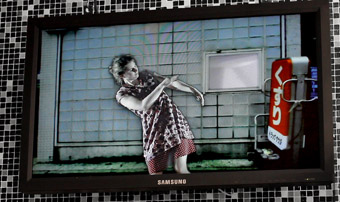
Vivaria, Sam James, installation view
Sam James’ Vivaria presumably takes its title from those places where animals or plants are kept for observation or research. Installed against a “pixellating” wall of black and white mosaic tiles, Vivaria displays the cream of Sydney’s contemporary dance species—Linda Luke, XX, Peter Fraser, Lizzie Thompson and Martin del Amo—each displaced into and onto an array of architectural spaces. The video works within its own grid, a gradually rotating cube with each facet revealing another setting, another performer. Gesturing at internal states, the dancers move as if feeling their way in the dark. Meanwhile buildings transform around them. Their setting renders tentative gestures more dramatic. An arm is caught inside or has it colonised concrete? “A co-joining of impossible spaces and bodies elicits the dancer as a hybrid creature—anthropomorphic like Descarte’s Animal Machines,” writes James. The work is richly textured, at turns elegantly pensive and playful, a meditation on the competing presence of bodies and the built environment.
To experience Vivaria in full requires standing for 26 minutes halfway up the stairs—not something that comes easily to students in the School of Busy-ness who are more likely to accumulate a vision of the work in fragments. I imagine Vivaria functions quite well in this way too. One student asked me why I’m so immersed. “Are you searching for the meaning?” he asks and I imagine one could do worse these days in the School of Business.
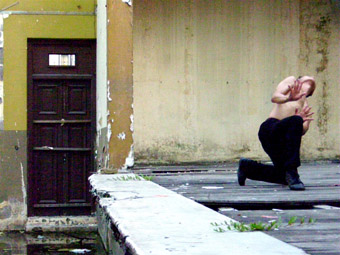
Tony Yap, Melangkoli – Sen Siao, Sean O’Brien
Sean O’Brien’s Melangkoli Sen Siao is housed on the 3rd floor of the Robert Webster Building where the two-screen work is installed in the tight reception area of the School of English, Media and Performing Arts. Earphones in place, listening to Madeleine Flynn and Tim Humphrey’s score, I sit inches away from office workers to be transported to the steamy streets of Melaki (Malaysia) and Yogjakarta (Indonesia) where dancers Tony Yap and Agung Gunawan are enacting intensely passionate rituals of grief in response to interior and exterior landscapes, sites that are “key to the performers, to their bodies, to their memories.” In this small, contained space I feel entirely displaced.
GESTURE offers many such disconcerting breaks in the continuum, a series of small shocks that open the mind to the world beyond surfaces. It’s a pertinent provocation and a gift to that increasingly fluid and fast moving entity called the student body.
–
GESTURE: Performance/Film/Dance,ReelDance Installations #04: Reading the Body, choreographer, filmmaker, editor Sue Healey, digital artist Adam Synott, music Darrin Verhagen, animation Adnan Lalani, cinematography Judd Overton, performer Rachelle Hickson, Io Myers Studio; Promise of Fallen Time, director, choreographer Isabel Rocamora, featuring Anna Mittel, Enric Majo, photography Nic Knowland, sound design, Jem Noble, Io Myers Studio; Samuel James, Vivaria, dancers Martin del Amo, Lizzie Thomson, Peter Fraser, XX, Linda Luke, sound Gail Priest, consultant Paul Gazzola; Assembly, Kate Murphy, Australian School of Business; Melangkoli—Sen Siao, writer, filmmaker, editor Sean O’Brien, choreography, dance Agung Gunawan, Tony Yap, music Madeleine Flynn, Tim Humphrey, Robert Webster Building; University of NSW, June 15-19
RealTime issue #97 June-July 2010
© Virginia Baxter; for permission to reproduce apply to realtime@realtimearts.net
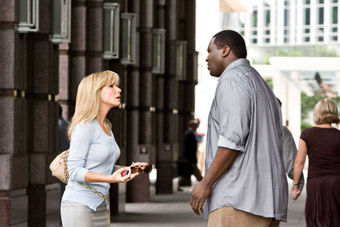
Sandra Bullock, Quinton Aaron, The Blind Side
photo courtesy Warner Home Video
Sandra Bullock, Quinton Aaron, The Blind Side
INTRIGUED BY THE PUBLICITY AROUND THE BLIND SIDE, THE AMERICAN FILM, BASED ON A TRUE STORY ABOUT A WEALTHY, SOUTHERN, WHITE, REPUBLICAN FAMILY BECOMING THE LEGAL GUARDIANS OF AN AFRICAN-AMERICAN YOUTH, BIG MIKE, FROM THE VIOLENT, DYSFUNCTIONAL PROJECTS ON THE WRONG SIDE OF MEMPHIS, I DROVE THROUGH FLOOD WATERS TO THE YARRAVILLE SUN CINEMA TO SEE WHAT HAD BEEN DONE WITH THE STORY.
I viewed it in the light of my script for the feature film, Call Me Mum (see RT74) on a similar, Australian subject—the fostering of a Torres Strait Islander by a white woman, in this case myself. The pure, naïve, ‘missionary’ story The Blind Side told was exactly what I did not, could not and would not tell in Call Me Mum. How could it be, written in the context of the Bringing Them Home report and the Stolen Generations narratives?
I found The Blind Side very problematic on a number of levels. The simple narrative and two-dimensional characters meant the meat was removed from the bone in favour of the heart-warming and feel-good; the most interesting story was that told by the actual family photos screened under the end credits. The film would have sunk without trace except for Sandra Bullock’s Oscar-winning performance as Leanne Tuohy which, to me, as a white foster mother, seemed emotionally inspired—her task-oriented attitude, her closet compassion, her moral/ethical toughness, her emotional restraint. She refused, as I know I did, to ‘enjoy’ an emotional smorgasbord at her adoptive son’s expense. What bonded Leanne Tuohy and Big Mike was not pathological maternity playing itself out through interracial adoption, it was that both exhibited a high score in ‘protective instincts.’ Anyway, The Blind Side got me thinking, again, about the way the white adoptive/foster mother is represented in the few Australian films that deal with this subject of interracial adoption/fostering.
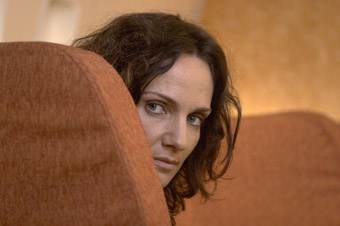
Catherine McClements as Kate, Call Me Mum
So, in the light of my construction of the white foster mother in Call Me Mum, I watched those films again—Chauvel’s iconic Jedda, Tracey Moffat’s ‘remake’ of Jedda, Night Cries—A Rural Tragedy, Anne Pratten’s short AFTRS film Terra Nullius, Andrew Bovell’s story for Anna Kokkinos’ Blessed, Baz Luhrmann’s Australia.
Sarah McMann, the white mother in Jedda—pale, scrawny, pathetic, the sickening prototype of the ‘do-gooder, mission manager,’ pathologically depressed after the death of her baby—takes the orphaned Aboriginal child Jedda as a replacement and determinedly tries to ‘tame’ her Aboriginal ways. Sarah teaches Jedda to bathe, read, play the piano, speak ‘well.’ She tries to stop her associating with the Aboriginal station workers and encourages her relationship with the ‘mission Black’ head stockman, Joe, who narrates the film. The Aboriginal child, Jedda, suffers at the hands of failed maternity.
In Night Cries Sarah McMann returns to the screen as a deathly white, geriatric, wheelchair bound invalid (played by Agnes Hardwick) being cared for, in her final days, by a frustrated, voluptuous Jedda (Marcia Langton), in a white, nurse/domestic’s uniform. Dialogue is replaced in the film by a haunting soundscape—amongst the animal cries, ‘corroboree, drum and didgeridoo’ sounds, cracking whips, laughter, the noise of a distant train are the poignant raspings of the dying Sarah and, finally, the extended, heartbreaking weeping of Jedda curled foetally beside the corpse of her dead ‘mother’ on a railway siding platform.
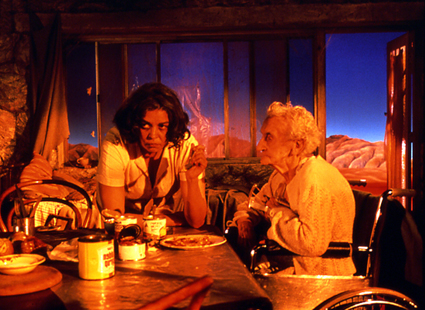
Sandra Bullock, Quinton Aaron, The Blind Side, photo Ralph Nelson, courtesy Warner Home Video; left – Marcia Langton, Agnes Hardick, Night Cries, Tracie Moffat
courtesy Ronin Films
Sandra Bullock, Quinton Aaron, The Blind Side, photo Ralph Nelson, courtesy Warner Home Video; left – Marcia Langton, Agnes Hardick, Night Cries, Tracie Moffat
The mother here is a classic study of the Kristevan abject—ghastly white and wasted, the skin of her scrawny hands and feet old and scaly, emotionally and psychologically absent yet powerfully demanding in her helplessness and finally, a corpse. The film shifts gears from ‘a rural tragedy’ into the horror genre. The abject here is complicated by race and yet Jedda’s grief is real, affective and, in some way, accomplishes a reconciliation.
But that monstrous, old Sarah McMann, she’s one of the unholy undead. She won’t bloody well stay down—because she ain’t dead by a long shot. There she is again, geriatric, demented, pitifully hungry for love—white, white, white skin, hair, nightdress—haunting the well-heeled, leafy, leafy, leafy Melbourne suburbs and the silver screen in Blessed. Abject in her pathologically starved maternity, Laurel Parker denies her adopted Aboriginal son Jimmy access to his birth mother, hiding the humble present she leaves at the door for his 13th birthday; secreting it away behind her volumes of Marx (Karl not Groucho) in her well-stocked bookcase. This time Jedda/Jimmy challenges this ‘mother,’ although it’s still not dialogue; she’s good and dead, and there’s no reconciliation. At the morgue to identify her body he denies her once, twice. “She’s not my mother,” he says to the morgue attendant. “No, this is not my mother.” She has been killed as a direct result of this thwarted craving for maternal love when, in her senile delirium, she embraces and kisses a young thief she mistakes for Jimmy. Thus Bovell proves his racial ‘goodness’ through an unproblematic demonising of the adoptive, white mother—a real soft target.
Alice, in Terra Nullius, does dialogue with her adoptive mother, again reprising the ‘taming’ versus ‘Indigenous instincts’ arguments. The construction of all these Sarah characters is pretty much covered by the discussion between Doug and Sarah McMann in Jedda: “Still trying to turn that wild little magpie into a tame canary, Sarah? Well you won’t do it by shutting her windows at night to keep out the cry of the corroboree, dance and didgeridoo and you won’t wipe out the tribal instincts and desires of a thousand years in one small life.”
Luhrmann’s Australia does, to some extent, progress the discussion in the construction of Lady Sarah Ashley. Nicole Kidman presents us with another Sarah McMann but this is a more contemporary Sarah, finally out of the 50s, and one more in keeping with the adoptive/foster mothers I know. Despite some reservations about her young Aboriginal charge Nullah going walkabout, despite wishing, vaguely, to teach him ‘manners’, despite her inability to have children herself, her adoption and maternity are not constructed as something missionary, pitiful and pathological. It has more in common with Bullock’s Leanne Tuohy in its heightened empathy and task-oriented drive. Nullah is not a blank, needy orphan to be ‘loved’ either. Sarah Ashley responds to Nullah’s agency. He says to her, any number of times, “I will sing you to me.” The two mothers, Nullah’s birth mother and Sarah Ashley, combine forces to protect him from being taken to the mission by the ‘coppers’ at the behest of his violent white father. Finally, Kidman’s Sarah understands and accepts Nullah’s need to go walkabout with his grandfather and she waves goodbye.
How are race and child protection perceived in this country? The voices of adoptive mothers of Indigenous children go unheard. We, with our experience of interracial adoption/fostering, are treated as virtually non-existent except as abusers and thieves. All the parents I know are more like Sarah Ashley and have gone to extraordinary lengths to find and link their Aboriginal or Islander child with their birth families and are acutely aware of the needs of the child to have access to, and knowledge of, their Indigenous heritage and culture. A number have adopted or fostered through Aboriginal agencies yet are still cast as Sarah McManns. (I tried to voice some of this in Call Me Mum.) Most importantly, we know first hand the effect the singular, overarching ‘stolen’ narrative can have on a teenaged child searching for an identity as all young people do. I showed this in Call Me Mum when foster son Warren is cajoled into repeating the ‘stolen’ story by a journalist.
One academic who has researched the subject is Denise Cuthbert. She found that white mothers “have been rendered not only silent but their experiences are virtually unspeakable in the present context” (“Holding the Baby: Questions Arising from Research into the Experiences of Non-Aboriginal Adoptive and Foster Mothers of Aboriginal Children,” Journal of Australian Studies, December, 1998). Proving the point, Damien Rigg, in critiquing Cuthbert’s work, decries “her failure to adequately consider the potential need for some stories to remain unspoken” (“White mothers, Indigenous families, and the politics of voice,” Australian Critical Race and Whiteness Studies Association Journal, e-journal, Vol. 4, No.1, 2008). But the constant theme in Australia, and we hear it particularly from Nullah, is that knowing and telling your ‘story’ is the most important aspect of any culture.
To tell these stories we need to find ways to live in the complexities of the ethical paradox, cultivate a political sophistication, not reinscribe some Australian Good, not fall into the blind spot of assumption as Andrew Bovell does. Our cultural products, such as film, need to speak “against the grain of the good and its incumbent fantasies” (Jennifer Rutherford, The Gauche Intruder: Freud, Lacan and the White Australian Fantasy, 2000). They must acknowledge, explore and articulate the blind spot. Listen to all the stories, not just the socially and politically sanctioned ones.
This article first appeared online June 28
RealTime issue #98 Aug-Sept 2010 pg. 28
© Kathleen Mary Fallon; for permission to reproduce apply to realtime@realtimearts.net
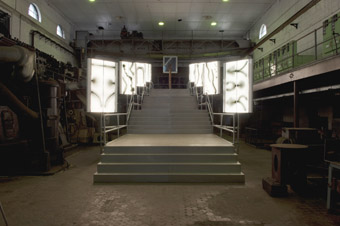
Faraday Cage, 2010 Installation view of the Biennale of Sydney 2010, Power House, Cockatoo Island, courtesy the artist and Gallery Koyanagi, Tokyo
photo Sebastian Kriete
Faraday Cage, 2010 Installation view of the Biennale of Sydney 2010, Power House, Cockatoo Island, courtesy the artist and Gallery Koyanagi, Tokyo
HIROSHI SUGIMOTO IS AN ARTIST WHO USES PHOTOGRAPHY TO EXPLORE AND REALISE CONCEPTS ARISING FROM HIS WIDE-RANGING INTERESTS SPANNING ART, SCIENCE, LANDSCAPE, MATHEMATICS, BELIEF SYSTEMS AND ARCHITECTURE
He uses large-format cameras to create portraits of ideas—often to record light events over long time spans—creating revelatory images otherwise unavailable to human perception. For example, the brief but entire life of a candle or the duration of a movie projected on a cinema screen. In sculptural and architectural forms, he uses materials such as plaster or aluminium to explore the potentialities of shadows and abstract geometries.
For the 17th Biennale of Sydney, Sugimoto devised Faraday Cage, a new site-specific work located inside the decommissioned power station at the western end of Sydney Harbour’s Cockatoo Island.
Here and now, in the early 21st century, Cockatoo Island presents a unique palimpsest of maritime industrial activity and technologies, at once embodied and entombed in a utilitarian accumulation of remnant architectures watched over by the emblematic rusting carcasses of eerily figurative monumental cranes. Across, over and through this savagely cut and gouged sandstone mound, untold kilometres of cables, pipes and conduits trace the entire trajectory of the Industrial Revolution. And all of these systems, devices and machines required power to function—provided in stages by the muscles of men and horses, the circulatory energy of steam and fantastic, mysterious, elemental electricity.
After a long wander down a bitumen road between a towering sandstone quarry cliff and a narrow deepwater dock, the approach to Faraday Cage is via a short oversized tunnel carved through the island’s sandstone body. Behind a giant’s ribcage of angular steel trusses, roughly hewn stone walls drip with seeping rainwater. Rounding a bend, a small accidental atrium space serves as outdoor ante-room to the power station proper. Massive monochrome-grey triple-height wooden doors stand closed at the entrance. Faraday Cage is inside.
Common to the industrial vernacular, a much smaller secondary door is cut near ground level into one of the two huge swing-doors. Reminiscent of the experiential commencement of chanoyu, the Japanese tea ceremony, visitors must stoop to enter the building containing the artwork. There’s a brief moment of instinctual care taken as one steps over this awkward threshold, bent toward the floor. On standing upright again, the shadowed, cavernous space of the defunct power station interior is revealed.
High up, a massive gantry crane sits motionless. Hugging one wall on a raised walkway is a procession of tall metal cabinets adorned with rows of white dials and black switches. An open stairwell of rusted steel descends to an ominous dark void. Down there, the relentless sound of a strong flow of water—an underground stream? Huge iron tubes like taut muscular arms, spherical mesh cages, Frankenstein throw-switches, precision rows of bakelite dials, warning signs—everything here is about containment and flow of enormous pressures and deadly forces. This is energy bondage fetishism born of engineering necessity. Over there, worn wooden workbenches with careless assemblages of abstract metal shapes, rusted drums, stained walls, stained puddles…it is a space filled powerfully with absence. And to this redundant post-industrial setting, Sugimoto introduces various interventions, asserting a different potential.
Of immediate visual impact, the artist has contrived a grand, temporary stairway delineated by steel-pipe bannisters to dominate the central void. Ascending dramatically away from the viewer, it is punctuated with a series of four broad metal platforms, each flanked by a pair of large vertical light-boxes displaying exquisite, luminous examples of Sugimoto’s recent experiments in producing photography with (not of) static electricity.
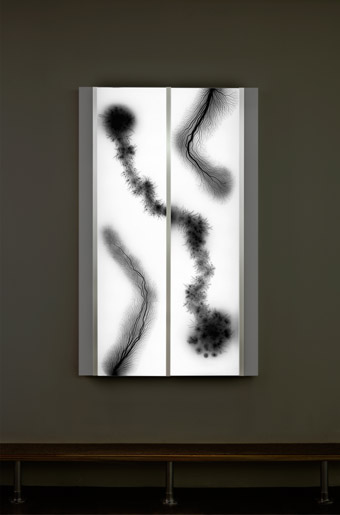
Hiroshi Sugimoto, Lightning Fields Illuminated 003 | 2008 black-and-white film with light box
courtesy the artist and Gallery Koyanagi, Tokyo
Hiroshi Sugimoto, Lightning Fields Illuminated 003 | 2008 black-and-white film with light box
These glowing dendritic monochromes serve as symbolic portraits of the friendship between two 19th century ‘natural philosophers.’ Michael Faraday and William Henry Fox Talbot. Faraday’s investigations led to the industrial development of electricity, while Fox Talbot invented calotype photography and used it as a medium for artistic expression. They were both progenitors in the maelstrom of invention that was the Industrial Revolution—within which legacy we now reside.
Atop the stairwell, which commingles industrial make-do with mnemonic tropes from grand theatre foyers, banal hotel lobbies and aristocratic homes, stands a crude wooden column. Astride this column, above the heads of visitors, is an extraordinary menacing figure—an emanation of elemental power, of lightning’s hair-raising cohort, Raijin the Japanese deity of Thunder. Leaping across time and space from 13th century Japan, this arresting polychrome wooden incarnation expresses the energy of thunder as a bulging, squat, blood-red daemon, fierce mouth agape, green-glass eyes madly staring, oversized golden loin-wrap swirling as he runs across the sky beating great invisible drums with double-headed mallets clenched in brutish fists.
This astounding sculpture—so beautifully conceived and skilfully executed—represents a deity with obscure origins in both Indian Hinduism and Chinese Taoism, adapted into Japanese animist traditions and finally into Buddhism as one of the many protectors of Kannon (Avalokitesvara), the 1,000-Armed Bodhisattva of Infinite Compassion. Long before, Raijin attempted to frighten and menace the Buddha, but after becoming a protector of the dharma, he is said to have saved the islands of Japan from invasion by Mongolian forces in 1274. He stood atop the clouds hurling spears of lightning down upon their fleet.
But 13th century Raijin is not the only deity invoked within the charged atmosphere of Faraday Cage. Sugimoto effortlessly reaches back and forth across time, bringing diverse ‘cultural warriors’ together on the stage of his contemporary art practice. If Faraday and Fox Talbot are tangentially evoked, another ‘giant’ of a different order is made unmistakably apparent.
Near the entrance is a well-known photographic portrait of Marcel Duchamp, elucidating an explicit and appropriately tongue-in-cheek reference to the readymade quality of this amazing building/space. The glass in the frame has been damaged by what appear to be a few light hammer blows, and it’s attached to an old two-wheeled hand-pushed goods trolley. Duchamp—and the weight of his conceptual baggage—has been literally wheeled out and parked in the space.
Nearby and behind, camouflaged within the tangle of decommissioned industrial debris, is a Faraday Cage apparatus, named after Michael Faraday’s invention of 1836. This esoteric example of the device incorporates a common metal bird cage, symbolically referencing the capture and taming of elemental forces for human amusement. The Faraday Cage hides there, apparently dormant but silently accumulating immense and invisible power, until periodically discharging its pent-up electrical energy with startling, noisy arcs of blue-white miniature lightning.
The overall effect is of a strange, dimly lit cathedral-like space. It is at once a homage to and mutation from its original purpose, becoming a place for the generation of speculation on art, science and technology, and for the temporary worship of harnessed elemental forces. Perhaps it includes one which is everywhere apparent in this part-industry, part-art hybrid tableau—the elemental force of the human imagination. The imagination to portray epic deities to explain the terrifying indifferent fury of natural forces. The imagination to radically investigate those same forces and derive different explanations in substitution of deities. The imagination to devise technologies to cage and tame and apply those forces. And the imagination to conjure and realise utterly different forms of art—a urinal as sculpture, electricity as a photograph, decayed post-industrial hulk as contemporary art space.
Hiroshi Sugimoto’s Faraday Cage points directly to this cascade of minds falling through time, sparkling with erratic energies.
Hiroshi Sugimoto, Faraday Cage 17th Biennale of Sydney, Cockatoo Island, May 12-Aug 1
This article first appeared online, June 28, 2010
RealTime issue #98 Aug-Sept 2010 pg. 34
© Gary Warner; for permission to reproduce apply to realtime@realtimearts.net
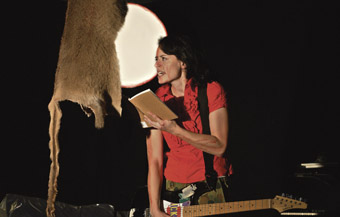
Deborah Robertson, Prompter Live Studio Development, 2010, Hydra Poesis
photo Traianos Pakioufakis
Deborah Robertson, Prompter Live Studio Development, 2010, Hydra Poesis
THE WESTERN AUSTRALIAN THEATRE DEVELOPMENT INITIATIVE (WATDI) IS NOW IN THE SECOND YEAR OF ITS PILOT PROGRAM, WITH 2010 APPLICATIONS CURRENTLY AT THE SHORTLIST STAGE AND THREE SUCCESSFUL APPLICANTS FROM 2009 WELL ADVANCED IN THEIR CREATIVE DEVELOPMENTS.
Funded by the Australia Council, WATDI’s formal structure is of particular interest for two reasons: its five-stage, consultative application process, and a seemingly unique management partnership of three key players in Perth’s contemporary performing arts scene: Perth Institute of Contemporary Arts (PICA), The Blue Room and ArtRage.
According to PICA Director Amy Barrett-Lennard, WATDI is currently the only significant provider of development funding for new theatre in WA, following the demise of the state government’s Major Production Fund. The scheme’s particular aim has been the encouragement of artists to engage in intensive research and creative development, without necessarily focusing on performance outcomes. It offers amounts of $30,000, $60,000 or $90,000 to assist successful applicants to achieve their goals.
To this end, in 2009-10 local companies Hydra Poesis, pvi collective, and a Sudanese-Australian theatre exploration, The Shrouds or the Dead, have each been fortunate to explore, research and develop work, not only free from the pressure of producing a show, but actively encouraged to ‘think big’ along the way.
Hydra Poesis received $60,000 to develop Prompter Live Studio. The work takes place in three locations simultaneously, with three completely separate audiences linked by interconnected studio installations. It follows the evolving relationship between a foreign correspondent and their local ‘fixer;’ explores a surreal prisoner-exchange; and enters the performative world of the lone video blogger.
Prompter Live Studio’s development team includes Hydra Poesis Director Sam Fox, co-writer Patrick Pittmann and sound artist David Miller, with performers Deborah Robertson, Michelle Robin Anderson and Brendan Ewing. The WATDI grant, in addition to buying development time, has enabled the team to work with mentor Dicky Eton of UK performance group Pacitti Company, live forum TV producer Richard Fabb and writer/dramaturg Stephen Sewell.
Working with these artists, says Fox, has helped the team develop a deep understanding of how Prompter Live Studio’s blend of performance material and technical approach might work with more traditional ideas of storytelling. The project, he says, has been an opportunity that other forms of funding could not have adequately supported.
“One of the things the WATDI process is trying to be true to,” he says, “is the idea of this being a predominantly research and development process, and not turning it into a creative development where we try and produce as much of the work as we can.”
He believes that without the WATDI funding, Hydra Poesis could not have undertaken the research: “We would have made an attempt at the work but…it’s a really ambitious project, and thematically and conceptually it requires a lot of development.” He also feels that the standard “bums on seats” requirement would have precluded it from other current funding options.
WATDI’s five-stage application process begins with a one-page proposal. Shortlisted applicants are interviewed by panellists from the three partner organisations, and a further shortlist is invited to develop proposals further, and provided with $3000 to do so. In-depth discussion then takes place with the panel, this time including an additional, ‘external’ member. Stage five is the funding announcement and from here on, the degree of communication is largely up to the grant recipients.
All the partner organisations see this process as a chance for artists to discuss and develop their proposals in a supportive environment. Fox agrees that rigorous discussion of the proposal at interviews helped Hydra Poesis to refine and develop their proposal. Both Fox and PICA’s Performance Program Manager, Vernon Guest, acknowledge the care with which the artist–funder relationship needs to be managed, however, particularly in a small arts environment where ‘everyone knows everyone.’
Guest says the structure continues to evolve in the current round, with the panel working to achieve the ideal balance between ‘arm’s length’ and ‘responsive’ approaches. The benefit of more communication with artists lies in greater sharing of expertise and advice, and a more supported structure. At the same time, a major benefit of less contact is the minimisation of administration costs. Guest cites some organisations as carrying around 15% of administration costs, partly due to the need for project officers to be constantly communicating with artists. WATDI is currently running at around five to seven percent administration costs.
Both PICA’s Amy Barrett-Lennard and The Blue Room’s Louise Coles comment that one of WATDI’s unexpected positives has been the developing relationship between the three partner organisations. The work of running WATDI is divided according to resources, for example PICA takes care of marketing and communications, as it is well set up to do this.This ‘piggy-backing’ of WATDI requirements onto existing infrastructure is also significant in keeping costs down.
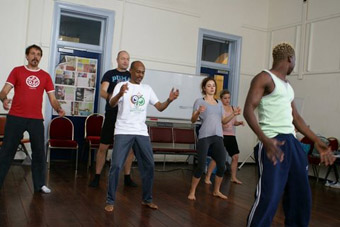
Workshop, The Shrouds or the Dead
Hydra Poesis is nearing the end of its WATDI development, and plans to produce a ‘test’ version of Prompter Live Studio in 2011. Other recipients in 2009, pvi collective, used their WATDI funding to research and develop Transumer, an ‘augmented reality’ work using iPhones, currently running as part of 17th Biennale of Sydney. The Shrouds or the Dead, based on a play by Sudanese-Australian writer Afeif Ismail, took the form of a three-week intensive development in which performers, musicians and a translator joined Ismail in exploring the ‘transcreation’ of his work to an Australian, multicultural context, examining how Sudanese performance tradition could inform and be informed by other methods, including Butoh.
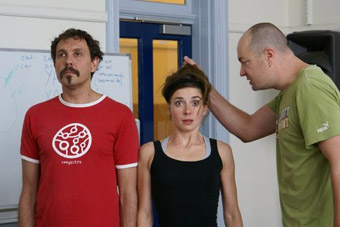
Workshop, The Shrouds or the Dead
ArtRage Festival Director, Marcus Canning, speaks positively about the applications in the current WATDI round: although they were fewer in number, he says, the quality this year was higher overall, with greater diversity and some very strong regional proposals. The point of the initiative, he reasserts, is “development unshackled from the needs of set production outcomes.”
“There is a sense in the second year that there is a growing understanding of what this can mean,” Canning says, “and more key practitioners putting forward a greater array of expansive and brave development ideas.”
It appears WATDI’s impact is threefold: strengthening the research focus of the companies involved through the critical feedback process (a process, it should be noted, that extends not only to successful applicants); providing WA’s theatre sector with an important new opportunity to develop work at a deep level; and building relationships between the organising partners. The Australia Council for the Arts will soon receive reports from WATDI on its first year of operation; then it will begin to make its own assessment of the initiative. Meanwhile, it will be interesting to see what emerges from the 2010 application round.
The Western Australian Theatre Development Initiative (WATDI) is funded by the Australia Council for the Arts and driven by partners PICA, The Blue Room and ArtRage. WADTI: www.watdi.org.au; Hydra Poesis: hydrapoesis.net; pvi collective: www.pvi.com; The Shrouds or the Dead: http://shroudsorthedead.wordpress.com/about/
RealTime issue #97 June-July 2010 pg. 30
© Urszula Dawkins; for permission to reproduce apply to realtime@realtimearts.net
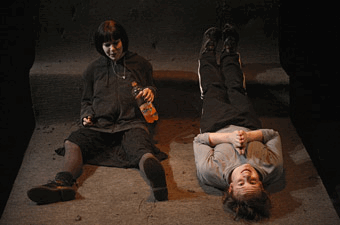
Sarah Ogden, Dylan Young, Moth, Malthouse Theatre and Arena Theatre Company
photo Jeff Busby
Sarah Ogden, Dylan Young, Moth, Malthouse Theatre and Arena Theatre Company
AT THE TIME OF WRITING, THREE PUBLIC DEBATES ARE RICOCHETING AROUND MELBOURNE: THE ALLEGED INVASION OF PRIVACY ENACTED BY SOCIAL MEDIA SITE FACEBOOK; THE “DON’T ASK, DON’T TELL” COMMENTS BY AN AFL FOOTBALLER REGARDING HOMOSEXUALITY IN THE SPORT; AND THE TROUBLING NATIONAL CALL TO “BAN THE BURQA.”
Though no one has, as yet, articulated any link between these issues, it strikes me that a common thread connects them: the right to choose how much of ourselves we reveal to others, and the ways in which we do so. Is society eroding distinctions between public and private, with ‘transparency’ (that loathsome term so favoured by government and big business alike) used to justify an increasingly Foucaultian surveillance of citizens? Maybe. Thankfully I can take these thoughts to the theatre, where the politics of the gaze and the power of the audient can be explored under more controlled conditions.
malthouse & arena: moth
At the centre of Moth, the latest production between Arena Theatre and Malthouse Theatre, is a moment of violence that speaks directly to these concerns. There is an assault, but the true savagery stems less from the physical harm inflicted than the fact that it is filmed on a mobile phone and uploaded to the internet. We watch the two teenage victims reliving their pain as unwilling spectators themselves, party to the comments of schoolmates splaying out beneath the endlessly repeatable footage. It’s a peculiarly postmodern horror that is compounded by their own complicity—in assuming the position of witness to their own bullying, they soon take on the role of bully themselves and turn upon each other.
There’s far more to Moth than this—it’s an outstanding character study inspired by tragic real events, as well as a finely crafted example of collaborative theatremaking at its best. Declan Greene’s script digs deeply into the monstrous dynamics of high school life that many of us have probably repressed (for good reason); it’s almost assured that any audience member will leave with an enriched, if unsettling, understanding of the frightening world today’s teenagers inhabit. It’s also a superbly performed work, with Dylan Young especially creating a compelling and complex anti-hero.
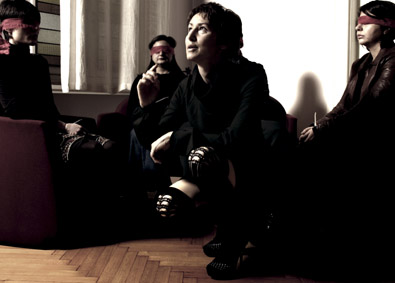
Roberta Bosetti, The Persistence of Dreams: The Sandman, IRAA Theatre
photo Umberto Costamagna
Roberta Bosetti, The Persistence of Dreams: The Sandman, IRAA Theatre
iraa: the persistence of dreams:
the sandman
The gaze is turned upon the audience in IRAA Theatre’s The Persistence of Dreams: The Sandman. A pair of strangers enter your home; after guiding them through the dwelling you are seated and a performance, of a sort, begins. Into the dialogue creep telling references to a range of intertexts that explore the breakdown of social norms and domestic security—Michael Haneke’s Funny Games, David Lynch’s Blue Velvet, Cormac McCarthy’s The Road. Soon enough you find yourself involved in just such a violation, subjected to a mild but provocative series of acts that put you in the role of object rather than voyeur. The fact that the experience is shared—you must gather between six and 12 fellow travellers—adds to this a sense of shared subjugation.
The work’s title alludes to the ETA Hoffmann short story which prompted Freud’s theories of the uncanny, and the experience itself literalises this notion as an incursion of the unfamiliar into the known. It’s not a terrifying experience, and neither is The Persistence of Dreams, but it does have a haunting effect enhanced by the manipulation of your home’s lighting and the rearrangement of the items in your living space. Most tellingly, once the strangers had departed, I found myself discussing for several hours with my fellow guests exactly what had just occurred, as if to dispel some lingering phantom and seek through words the return of the familiar.
jo lloyd’s 24 hrs, dancehouse
A recent Jo Lloyd project commissioned by Dancehouse offered a less threatening form of meditation on the way the makers of art modulate what is shown and kept hidden. 24 Hrs saw four choreographers each given a 24-hour period in which to develop a work from scratch, presenting the new performance at the conclusion of the allotted time. Much of the development was recorded on video and streamed online, where audiences could join in discussions of what they were seeing and become active commentators.
Though I could only make it to the first two presentations of 24 Hrs I found in them a marked contrast. Natalie Cursio’s work was a messy installation of recycled waste in which a series of fertile scenarios sprouted. The three dancers worked around clear moments in which power dynamics shifted or relationships reformed themselves; within this framework there was still a loose sense of play and spontaneity which tapped the tight time restrictions to produce a charming liveliness. In a post-show forum Cursio was asked whether the piece would go on to have a further life in some form, but all present seemed to agree that its transience was key to its meaning.
Shelley Lasica’s work the following week—also for three dancers—had a similar air of improvisation within boundaries, but for me didn’t raise the range of questions Cursio’s work inspired. It appeared more a formal exercise in technique, admirable in that respect, but not making the conditions in which it was produced a part of its own investigation. It was a work that could easily be seen as the starting point for a later, more developed project, but this meant that on its own it seemed too much a performance in embryonic form rather than something complete and contained in its own right.
Both pieces did allow audiences to contemplate the exposed mechanics of creation, but does viewing fragments of a work in progress and hearing the thoughts of makers on the fly add to or subtract from our experience of the final result? I don’t know the answer. It simply offers a different experience with its own rewards and disappointments. I certainly wouldn’t want the bones of every production revealed, since one of the joys of art is the possibility of encountering something magnificently realised from a position of innocent ignorance. Conversely, most forms of aesthetic production emerge from a process in which artists select those things they wish to reveal and attempt to control other functional elements. Pay no attention to the man behind the curtain.
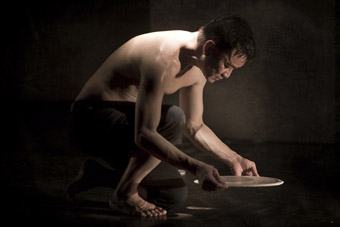
Tony Yap, Rasa Sayang
photo Jave Lee
Tony Yap, Rasa Sayang
tony yap, rasa sayang
None of this is new. The contract between a performer and their audience has always possessed its variable clauses of revelation and reticence, knowing and guessing, curiosity and blindness. There is an uncomplicated pleasure in being offered something that doesn’t claim a raw, unmediated transparency but is the result of careful crafting and modulated reticence. One such offering was Tony Yap’s Rasa Sayang, a small but exquisite solo dance accompanied by a live score by Tim Humphrey and Madeleine Flynn.
Before the performance began, Yap was among his audience, conversing with animation, but once the lights dimmed he entered a state of precisely controlled expression that channelled great emotions into tiny gestures. Much of the work seemed to work through memories of Yap’s mother and the intimacy of memory, regret and grief, but this was not an autobiographical work. That only brief, at times abstract details, of this relationship were unveiled didn’t obscure the effects of the piece but broadened them, allowing Yap’s audience space within which to introduce their own experiences and understanding of family and distance. Though not an overt subject of the work, this necessary reciprocity in any act of performance will always inform its shape and significance; when we look at another, we may also be looking at ourselves.
Arena Theatre & Malthouse Theatre, Moth, writer Declan Greene, director Chris Kohn, performers Sarah Ogden, Dylan Young, design Jonathan Oxlade, lighting Rachel Burke, composer Jethro Woodward; Tower Theatre, CUB Malthouse, May 13-30; IRAA Theatre, The Persistence of Dreams: The Sandman, created & performed by Roberta Bosetti & Renato Cuocolo; various locations, April 7-May 7; 24 Hrs, curator Jo Lloyd, choreographers Natalie Cursio, Shelley Lasica, Phillip Adams, Luke George; Dancehouse, April 30 – May 21; Tony Yap Company, Rasa Sayang, creator, performer Tony Yap, composers Tim Humphrey, Madeleine Flynn; fortyfivedownstairs, Melbourne, April 22-25
RealTime issue #97 June-July 2010 pg. 29
© John Bailey; for permission to reproduce apply to realtime@realtimearts.net
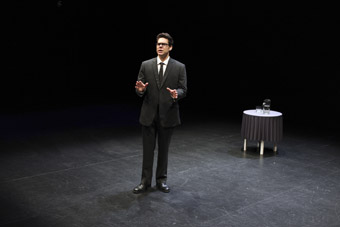
Jason Klarwein, Thom Pain (based on nothing), Queensland Theatre Company
photo Rob Maccoll
Jason Klarwein, Thom Pain (based on nothing), Queensland Theatre Company
SO FAR THIS YEAR IN BRISBANE TWO PERFORMANCES STAND OUT FOR THEIR ABILITY TO TRACK THE TWISTS AND TURNS CONTEMPORARY ANOMIE HAS TAKEN WHILE AT THE SAME TIME SHOCKING US INTO A PROFOUND REALISATION OF OUR OWN ISOLATION AS INDIVIDUALS. INSTEAD OF ASKING US TO GET INVOLVED, JOIN A RECOVERY GROUP OR ASK OUR DOCTOR FOR A PRESCRIPTION FOR PROZAC, THESE WORKS SEVERELY TESTED THE METTLE OF THEIR AUDIENCES AS THEY PRESENTED INVIGORATINGLY DIFFERENT (AND DESPAIRINGLY SIMILAR) VERSIONS OF THE GROUND ZERO OF THE HUMAN CONDITION.
The first of these was the homegrown product, Brian Lucas’ Performance Anxiety (RT96), a whirling dervish of performance cabaret which stands authoritatively alongside, and bears comparison with, American playwright Will Eno’s monologue titled Thom Pain (based on nothing), directed by John Halpin and performed by Jason Klarwein for the Queensland Theatre Company, and which has been described as “stand up existentialism.”
If both productions are dominated by the en-soi—in Sartrean existential terms the world experienced as alien and senselessly contingent dominated—they also cast a penumbral light on the dialectically opposing notion of the pour-soi, the individual self who challenges the givens of both social and personal history from a position deemed to be inalienably and ineluctably free. Both performances hinged on this quixotic quest for self-identity, so it is no wonder that a forthcoming project of Eno’s is an adaptation of the classical treatment of the subject, Ibsen’s Peer Gynt.Nor is it surprising that Lucas is currently directing Ionesco’s absurdist drama, The Chairs, for La Boite Theatre in Brisbane. In an evident revival of tradition, both seem to have learned from Beckett’s use of even the most miniscule silence to offset their words, and are well versed in Pinter’s throwaway sleight of hand.
Eno is a funny writer in the sense that Pinter wrote to The Sunday Times in 1960: “As far as I’m concerned The Caretaker is funny up to a point. Beyond that point it ceases to be funny, and it was because of that point that I wrote it.” Eno in an interview with QTC, revealing the level of his own subtle sleight of hand, writes, “The play’s title reminds me, of course, of Thomas Paine (famous for his Revolutionary War pamphlets with the words “the summer soldier and the sunshine patriot”), but it also somehow reminds me of a broken arm, both soft and hurtful, recognisable, but somehow wrong.” Behind the wounded and apparently character-armoured and conformist representation of Eno’s anti-hero, who wears a plain dark suit and tie and sports black horn-rimmed glasses, stands an authentic revolutionary hero, the existential pour-soi. If Thomas Paine the pamphleteer is feebly recapitulated in Thom Pain’s solipsistic maunderings, and Thom’s feints to rhetorically engage with the audience are succeeded by an almost instantaneous withdrawal from the fray, there is indeed a soft hurtfulness, a recognisable wrongness which is manifestly our own mirrored in his actions.
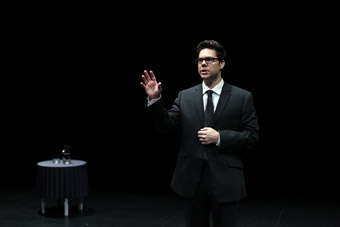
Jason Klarwein, Thom Pain (based on nothing), Queensland Theatre Company
Although he adopts the stance of being perpetually, paranoidly en garde, it seems useless to attempt to psychoanalise a character who is such a writerly, theatrical confection. Only towards the end, when the defensive precision of language breaks down into a painful, repetitively fragmented stream of consciousness does he let his guard down and invite our sympathy in the usual sense. This is the point at which he flies away, disappears back into the realm of his author’s imagination while leaving behind the concrete presence of the hapless other, his mirrored substitute—the member of the audience he has cajoled onstage to assist in an act of magic which has failed to ensue, unless by Catholic transubstantiation. His last line as he exits is the puckishly ironic: “Isn’t it great to be alive?”
The strength of the production lies in Eno’s Wildean language which incorporates such pithy observations about the end of a love affair as “I disappeared in her and she, wondering where I went, left.” Such ironic lucidity is equally applied to the nicely established loneliness of childhood (Thom doesn’t mention his parents) in an anecdote about the accidental electrocution of his pet dog. The most verbally actualised and traumatic scenario describes the boy’s misapprehension when he is attacked by bees: “Kind of beautiful, if you like that sort of thing. If you like the idea of a little boy desperately spreading stinging bees over his bleeding body. Desperately yelling, ‘Help me, bees, Help,’ and putting his little swollen hand into the hive for more.”
Thom’s recounting of his life turns on such incidents in a Yeatsian gyre rather than any straightforward narrative. A writer like Eno, as Martin Esslin said about Beckett, is essentially lyrical, concerned with such basic questions as “Who am I?” Both Eno and Lucas have returned to the problems enunciated by the great 20th-century poet Rilke in The Notes of Laurid Brigge: “And so we walk around, a mockery and a mere half: neither having achieved being, nor actors.” John Halpin and Jason Klarwein made an intelligent and sensitive team elucidating the philosophical premises, and at the same time urging each of us to become the good person whom Eno was trying to be when he wrote the piece.
Queensland Theatre Company, Thom Pain (based on nothing), writer Will Eno, director Jon Halpin, performer Jason Klarwein, composer Phil Slade, lighting designer Jason Glenwright, design consultant Josh McIntosh; Billie Brown Studio, Brisbane, March 15-April 10
RealTime issue #97 June-July 2010 pg. 32
© Douglas Leonard; for permission to reproduce apply to realtime@realtimearts.net
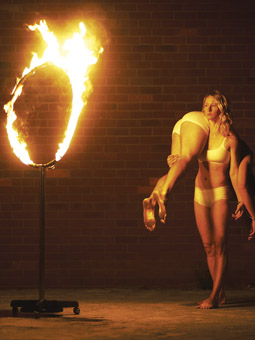
Rachael Ogle, Sam Fox, Hydra Poesis
Hydra Poesis’ new work Personal Political Physical Challenge premieres in July at PICA. It’s described as “a provocative, exciting and adult interpretation of the childhood game “truth, dare or physical challenge?”
Hydra Poesis is run by Sam Fox who has been artistic director of STEPS Youth Dance Company, created in community cultural development and festival programs and is working on a Masters degree on community collaborative production models at Murdoch University. You can read about his Western Australian Theatre Development Initiative (WATDI) project Prompter Live Studio.
Fox’s motivation for the show is clearly evident, “From B-grade romance to high drama, protagonists are so often concerned with the internal intricacies of their relationships with each other with no regard to their shared connection to the rest of the world. In this show we set those plot indulgences on fire!” Yes, fire is one of the components of the show, along with dance and ‘surreal’ theatrics.
Fox is directing and co-choreographing with collaborators Rachel Ogle and Martin Hansen while the show’s visual world is being realised by Thea Costantino and its music by Stina Thomas. RT
Hydra Poesis, Personal Political Physical Challenge Perth Institute of Contemporary Arts, July 16–20; http://hydrapoesis.net
RealTime issue #97 June-July 2010 pg. 32
© RealTime ; for permission to reproduce apply to realtime@realtimearts.net
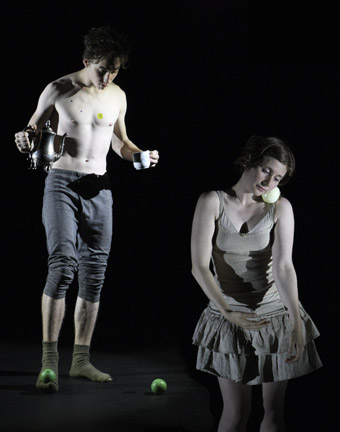
Silvertree & Gellman, Scattered Tacks
photo Alicia Ardern
Silvertree & Gellman, Scattered Tacks
THE NEXT DECADE IN THEATRE AND CONTEMPORARY PERFORMANCE WILL BE A DECADE OF PHENOMENA, NOT OF SIGNS, OF EXPERIENCING RATHER THAN READING PERFORMANCE. THE FIRST ‘SEMESTER’ OF THE ARTS HOUSE 2010 PROGRAM COULD BE NEATLY DIVIDED IN TWO PARTS: AUSTRALIAN CONTEMPORARY CIRCUS AND UK-BASED RELATIONAL PERFORMANCE. THE LATTER (WHERE THE AUDIENCE BECOME PERFORMERS AND CO-CREATORS) IS A BACKLASH AGAINST 20 YEARS OF MEDIATISED POSTMODERN THEATRE.
These new works are theatre minus stage, performance minus performers and spectacle minus the spectacular. The audience experience is the event itself: tactile, immediate, immersive, anti-ironic. The semiotic component is minimal, sometimes altogether absent, as the performance exists mainly in the mind of the spectator. It appears, perhaps, as our era abandons questions of meaning and engages with amplified possibilities of doing. It’s almost like a direct answer to Deleuze’s dream of the new non-representational theatre, in which “we experience pure forces, dynamic lines in space which act without intermediary upon the spirit.” And although tested by performance-makers both here (bettybooke, Panther) and elsewhere (Rimini Protokoll), the UK, building on its rich variety of live art, is something of a leader.
This form is too young to have encountered much meaningful criticism in Australia, but every form quickly accumulates knowledge. While I don’t think everything we have seen at Arts House could be called successful, the failures are just as interesting, like the results of an experiment.
Take Rotozaza. Their two shows, Etiquette and Wondermart, promised a new form of expression, ‘autoteatro,’ but delivered a half-hearted combination of pomo referentiality and demanding, mediatised interactivity. Both are no more than voices inside a headset, giving instructions to a single audience member. Wondermart is a walk through a(ny) supermarket. Etiquette is 30 minutes in a café, in which you and another audience member perform an encounter, a conversation from Jean Luc Godard’s Vivre Sa Vie, the final scene from Ibsen’s A Doll’s House, and much else—sometimes by talking to each other, sometimes moving figurines on the chess board in front of you.

Wondermart, Rotozaza
photo Ant Hampton
Wondermart, Rotozaza
While very engaging in those few moments when the narration matches what’s happening in space (such as when theories of shopper behaviour are confirmed by innocent bystanders in the supermarket), most of both shows consisted of a series of mundane and tiring little tasks. Despite the interactive pretences, they were not so much an experience for one audience member as a performance by one audience member, with the concomitant stage anxiety—even if nobody was watching. The problem was not just that many aspects of the situation cannot be sufficiently controlled by the audience-performer (my noisy supermarket trolley forbade me from following shoppers as instructed; or the concentration required to both quickly deliver lines and hear your partner-in-dialogue). Rotozaza underestimate our anxiety not to let the performance down: a compulsive need to please the dictatorial voice inside the headphones by performing everything right.
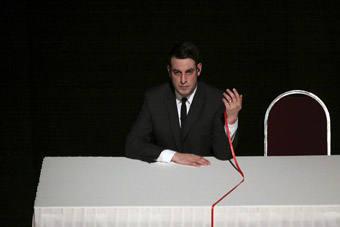
Mem Morrison, Ringside
photo National Museum of Singapore/Chris P
Mem Morrison, Ringside
If Rotozaza forgot how unpleasant structured events can be, Mem Morrison went all the way and staged the worst aspects of a wedding ceremony in Ringside. Its entire conceptual spine is the sense of alienation, monotony, meaninglessness and loneliness one feels at a collective ritual. The performance starts before it starts—audience groups are arranged into family photos, well-dressed and carnation-studded as per instructions—and seated around one long table. An infinite number of black-clad women, both attendants, family and brides-to-be, deliver food and crockery. Amidst the flurry Morrison is the only male, unhappy, confused, 12 years old, jokingly told it’s his turn next, sometimes playing with a Superman toy and sometimes MC-ing with his shoe instead of a microphone.
Ringside’s aspirations are sky-high, but the performance never manages to reveal much of its topical menagerie: ethnicity, gender, tradition, multiculturalism are signposted rather than explored or experienced. Morrison’s entire text is delivered through headphones, creating a mediatised distance that in 2010, after 20 years of screens onstage, is as déjà-vu as it is genuinely disengaging. There is a paradox within Ringside: it purports to bring forth an aspect of Turkish culture, but the distanciation intrinsic to the method condemns it as facile. The experience is ultimately of witnessing a whining 12-year-old, loudly airing his discontent at being dragged to a family event.
Helen Cole’s Collecting Fireworks, on the other hand, a performance archive and an archive-performance, is as simple as it is brilliant. A genuine one-on-one performance (a dark room, a single armchair, recorded voices describing their favourite performance works, followed by recording one’s own contribution), it exemplifies the opening possibilities of this new form: no stage, no performers, but a deeply meaningful experience. I suspect the end result will be a genuinely valuable archive of performance projects, as we are encouraged to remember not only the details of these works, but also the effect they had on us.
The reasons the two local circus performances were on the whole much more successful are complex: Australia’s long tradition of contemporary circus and Melbourne’s close acquaintance with both the form and the artists are not the least important. If with relational performance, imported from an emerging artistic ecology overseas, we occasionally felt both short-changed and ignorant, with circus we could comfortably feel at the world’s cutting edge.
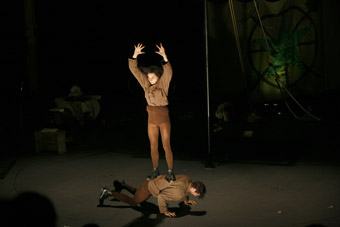
Propaganda, acrobat
photo Ponch Hawkes
Propaganda, acrobat
Acrobat’s long-awaited new work, Propaganda, points to the long tradition of circus used as Soviet agitprop, educational art dreamt up by Lenin in 1919 as “the true art of the people.” The company’s take is both ironic and deeply earnest, and it takes weeks of confusion before concluding that, yes, their open endorsement of cycling, eating veggies and gardening nude was serious. The tongue is in cheek, yes, when spouses Jo Lancaster and Simon Yates heroically kiss in the grand finale, centrally framed to the tune of Advance Australia Fair like the ideal Man and Woman in social-realist art. But it is a very slight joke indeed.
The specificity of circus could be defined as the pendular motion between crude and dangerous reality and the illusion of spectacle: relying on physical strength more than on representational techniques (it is impossible to just ‘act’ a trapeze trick), it can never completely remove the real from the stage. Acrobat’s previous (and better) work—titled smaller, poorer, cheaper—created tension by opening up the spectacle to reveal the hidden extent of the real: social stereotypes and obligations, physical strain, illness. Propaganda foregrounds circus as this family’s life: from the two children pottering around to the unmistakable tenderness between Lancaster and Yates and the heart-on-sleeve honesty of the beliefs they propagate. The dramaturgical incongruence between the ironic self-consciousness of the Soviet theme, with its inevitably negative undercurrent, and the performers’ trademark lack of pretence, remained the least fortunate aspect of the work. From the message to the magnificent skills on display, everything else was flawless.
Scattered Tacks, by Skye and Aelx Gellman and Terri Cat Silvertree (see article), stripped away spectacle to reveal the essence of circus: awe. Circus is a naturally postdramatic form: its narrative arc fragmented, aware of its own performativity (what Muller called “the potentially dying body onstage”) and constantly anxious about the irruption of reality on stage. Scattered Tacks is raw circus, naked: at times it felt like an austere essay in thrill. It revealed that the rhythm of audience suspense and relief hinges less on the grand drama of leaps and tricks and more on visceral awareness of the subtle dangers and pain involved. Eating an onion, climbing barefoot on rough-edged metal cylinders, overworking an already fatigued body—these were the acts that left the audience breathless. Yet they also achieve poignant beauty. The Gellmans and Silvertree bring Australian circus, traditionally rough and bawdy, closer to its conceptual and elegant French sibling, but in a way that is absolutely authentic.
Australia offers a good vantage point from which to observe the human being. Visiting Europe recently, it struck me how dense the semantics of the European theatre are in comparison. Performing bodies there are acculturated and heavy under the many layers of interpretation, history, meaning. The body here, on the other hand, easily overpowers the thin semiotics of Australian culture, emerging strong, bold and without adjectives, without intermediary. Body as phenomenon, not as signifier. It will be interesting to observe how the emerging interest in theatre as presence, rather than representation of meaning, unravels—and how much this country will participate in this trend. In this season it’s circus, one of the oldest forms of performance, that emerges as the more successful. The relational performance works only rarely overcame the trap of referentiality.
Arts House: Rotozaza, Etiquette, Wondermart, co-directors Silvia Mercuriali and Ant Hampton, Arts House and around Melbourne; Mar 16–April 3; Mem Morrison Company, Ringside, writer, director, concept, performance Mem Morrison, sound & music composition Andy Pink, design Stefi Orazi, North Melbourne Town Hall, March 17-21; Helen Cole, Collecting Fireworks, director Helen Cole, technical consultant Alex Bradley, North Melbourne Town Hall, March 17-19; Acrobat, Propaganda, conceived and performed by Simon Yates and Jo Lancaster, also featuring Grover or Fidel Lancaster-Cole, Meat Market, March 27-April 3; Silvertree and Gellman, Scattered Tacks, created and performed by Terri Cat Silvertree, Alex Gellmann, Skye Gellmann, Arts House, Meat Market, Melbourne, March 16-21
RealTime issue #97 June-July 2010 pg. 33
© Jana Perkovic; for permission to reproduce apply to realtime@realtimearts.net
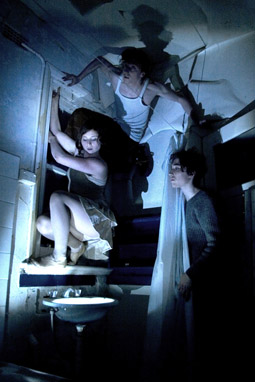
Silvertree & Gellman, Scattered Tacks
photo Alicia Ardern
Silvertree & Gellman, Scattered Tacks
The creators of Scattered Tacks, Skye Gellmann, Terri Cat Silvertree and Aelx Gellmann are fast building a reputation as physical theatre innovators with a performance language all of their own. In this edition Jana Perkovic reviews the recent Art House showing of Scattered Tacks.
The trio variously trained in circus and physical theatre as children working with Cirkidz, Kneehigh Puppeteers and then Urban Myth Theatre of Youth in Adelaide and in later years in corporeal mime and traditional and contemporary Japanese theatre forms.
Aelx Gellman describes himself as “a creative masochist, unusualist and escape artist, specialising in random feats of dexterity and prestidigitation.” To this we might add the human spelling error! The Gellmanns studied at NICA and all were involved in co-founding companies (Rambutan, Shuttlecock) along the way. The three went on to gather a string of Best Emerging and Most Promising awards including for Skye Gellman in 2007 Most Promising Male Actor at Melbourne’s Short and Sweet festival.
In 2008 their signature work, Scattered Tacks won the Melbourne Fringe Award for Most Outstanding Production and in 2009 was programmed by Yaron Lifschitz at CIRCA for their showcase of new works at Brisbane Powerhouse. This is where our reviewer Douglas Leonard was taken by the work: “No extraneous effects. Fragments of a life obscurely shared were dimly recreated. The light distorted, flattened and sculpted identifiable shapes into pure, foreboding forms.” (See full review.) Lifschitz described Scattered Tacks as “one of the most challenging and significant pieces of New Circus to emerge in years.” In the same year, the work toured to Noorderzon Performing Arts Festival in the Netherlands.
Skye Gellmann is currently developing a solo performance for the 2010 Sydney Fringe Festival called Eyes Fight, Projector Light, “a minimalist circus experiment involving an acrobatic body and the cutting light of a slide projector.” It will be is directed by Terri Cat Silvertree who is also developing her own solo performance. RT
www.scatteredtacks.skyebalance.com
RealTime issue #97 June-July 2010 pg. 34
© RealTime ; for permission to reproduce apply to realtime@realtimearts.net
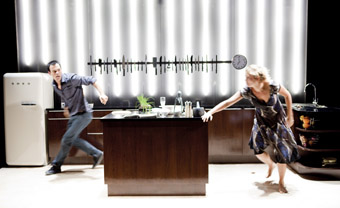
Socratis Otto, Leeanna Walsman, Stockholm, Sydney Theatre Company
photo Brett Boardman
Socratis Otto, Leeanna Walsman, Stockholm, Sydney Theatre Company
UK PHYSICAL THEATRE GROUP FRANTIC ASSEMBLY EXPLAIN IN THE PROGRAM NOTES TO THEIR AUSTRALIAN RECONSTRUCTION OF STOCKHOLM, THAT ‘STOCKHOLM SYNDROME’ OCCURS WHEN A “HOSTAGE SHOWS SIGNS OF LOYALTY TO THE HOSTAGE-TAKER.” A TEXT-BASED WORK WITH DANCE AND MOVEMENT INTERJECTIONS, STOCKHOLM HAS BEEN REMOUNTED BY DIRECTOR-CHOREOGRAPHERS SCOTT GRAHAM AND STEVEN HOGGETT WITH AN AUSTRALIAN CAST TO FIT A PRE-EXISTING CHOREOGRAPHIC SCORE. THE PRETEXT FOR THE PLAY IS “DIFFICULT AND DESTRUCTIVE” LOVE.
Playwright Bryony Lavery was commissioned by the company to interweave words with movement around themes of control, desire and manipulation. Employed as a recurring motif, the word “Stockholm” comes to work as an awkwardly literal reference to the demise of a sparring couple’s relationship. It is both the actual ‘elsewhere’ of a holiday in the making and the figural ‘reality’ of a relationship-in-crisis.
The main misuse of the term is in its application to the the young couple, Kali and Todd (Leeanna Walsman and Socratis Otto), Lavery envisaging their world in terms of “retro-jealousies” over past lovers, overblown romantic ideals and sickly sweet histories. On the celebration of Todd’s birthday, they dance around their SMEG/smug kitchen meting out reminiscences and arguments over a recipe for dinner. Stockholm, the literal city, sits in the distance as the promise of holiday escape from a relationship that appears more like something from a real estate advertisement than anything real. Stockholm Syndrome—the metaphorical premise of passive submission to a controlling power—never materialises as we slowly realise that Kali’s manipulations (taunts, violence, spying on Todd’s text messages) are the product of something infinitely more despairing than dynamics of master and slave. It seems that Kali is deeply psychologically unwell—a thematic with which Stockholm unfortunately never risks engaging.
Kali and Todd’s pas-de-deux is played out through a combination of text and physicality, where the literal again looms large in movement pieces that could have more abstractly conveyed the difficult machinations of mental illness and its impacts on loved ones. Instead, the choreographers plot the lovers stacking the grocery shopping in the kitchen cupboards, for example, with gestures that resemble musical, more than physical, theatre. They do make suspenseful use of tight kitchen spaces and knives, but when movement is pre-empted by the text, the problems are exacerbated. Kali’s calls for “birthday dance time” and “this last dance, it’s a slow one” uncomfortably reveal that text and movement, caught in a kind of self-conscious narration of their dramaturgical coexistence, aren’t speaking to each other at all. In this respect, this work loses its relevance to a field of progressively innovative physical or movement-based theatre work which also happens to be locally driven and conceived (think Force Majeure or Branch Nebula).
The action takes place in a set that also over-performs: we move between a tight kitchen space, an outdoor stairwell, an upstairs attic bedroom and a balcony water pool. The mechanised apparatus intrudes into the fictional world in a way that might be better left unelaborated. Moments of scenic abstraction could be promising (a strange devil-like voice appears both at the staircase and in the water pool) but seem more drawn towards underscoring scenographic technicalities rather than developing any stronger thematic sense of actual psychological disorder. A bedtime scenario towards the close of the piece does attempt to place physical tension in relation to narrative tension (the performers are suspended by arm straps on a high leaning platform whilst taking us to a quasi dreamstate in which they pre-empt the future birth, and then grisly murder, of their own children), and yet this too is undercut by their concurrent baring of sexy chests and skin.
If Stockholm Syndrome registers a scenario of unwitting surrender to a hostage-taker, then Stockholm left me feeling disengaged. When issues of mental illness are conveyed as simplistically violent and manipulative, when relationships resemble the stylistic tropes of The Sydney Magazine, and when theatre then moves in its bag of tricks to try to take us all hostage, I’m tempted to have a similar response to Todd, whose final challenge to Kali is calmly to the point: “I’m too intelligent for this.”
Frantic Assembly, Sydney Theatre Company, Stockholm, writer Bryony Lavery, direction & choreography Scott Graham, Steven Hoggett, performers Socratis Otto, Leeanna Walsman, design Laura Hopkins, costumes Jennifer Irwin, lighting Andy Purves, sound design Adrienne Quartly, assistant to the choreographers Dean Walsh; STC, Wharf 1, March 17-April 24
RealTime issue #97 June-July 2010 pg. 34
© Bryoni Trezise; for permission to reproduce apply to realtime@realtimearts.net
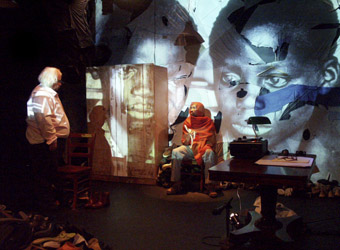
l-r David Moody, Martin Mhando, Witness, Blue Room
photo Serge Tampalini
l-r David Moody, Martin Mhando, Witness, Blue Room
ON A SMALL STAGE CLUTTERED WITH COUNTLESS PAIRS OF OLD SHOES—THE SHOES OF THE DEAD—BETWEEN A COUPLE OF RICKETY WOODEN CHAIRS AND AN IMPOSING, OFFICIAL-LOOKING DESK, TWO MEN PLAY A GAME. ONE, AFRICAN, WIRY AND ENERGETIC, SPINS OR FLIPS A COIN—IT DOESN’T MATTER WHICH—THE RESULT IS ALWAYS HEADS. THE OTHER, WHITE, MASSIVE AND MANIACALLY CONVIVIAL, SEEMS TO BE HIS FRIEND. THE TWO PLAY THE GAME LIKE SPARRING KIDS, LIKE GROWN-UP BROTHERS, LAUGHING TOGETHER MORE INSISTENTLY EVERY TIME THE PREDICTABLE RESULT COMES UP AGAIN—YES, HEADS.
Witness, co-written by award-winning Tanzanian-Australian filmmaker Martin Mhando and WA actor and writer David Moody, explores the law of probability as it plays out in bitter human conflicts, retelling stories of torture and atrocities from Chile to Cambodia in a constantly morphing, fractured form. As the play progresses, the men perform a collage of vignettes in which the roles of white, black, male, female, jailer, prisoner, aggressor and victim are endlessly exchanged. At one point Moody dons a curly black wig to play a comical Colonel Gaddafi; elsewhere both men perform a disturbing Auschwitz cabaret scene as “Hymie and Abe,” complete with Marx Brothers nose-and-glasses.
Produced by newly formed company, Ujamaa—Swahili for ‘collective brotherhood’—Witness is directed and designed by Serge Tampalini, whose shoe-strewn stage is backed by a makeshift projection screen of t-shirt fragments, stretched like overlapping skins. The co-writer-performers and Tampalini are all lecturers at Murdoch University’s School of Social Sciences and Humanities, with lighting and stage management provided by Murdoch students.
Mhando and Moody are joined on stage by actor Lesley-Anne Philps, who as a pointedly well-groomed translator, transcriber and witness observes horrors such as white man Moody repeatedly dunking black man Mhando’s head into a bucket of water, as Mhando attempts to recount the death of a daughter in Rwanda; or the two men telling and retelling their tortures to one another from inside black plastic garbage bags shoved against the piles of rotting shoes. Moody becomes a prisoner, capturing a small bird in his cell—signified by a tiny red satin slipper that he holds delicately with genuinely bruised and welted arms. He delivers a soliloquy that ends with the assertion that “As long as Mandela lives…” But Mandela is dead! laughs Mhando, while the impeccably dressed Philps at her desk smirks at Moody’s wasted passion.
Witness is scripted from several sources including the writings of Tom Stoppard, Athol Fugard, John Kani and Winston Ntshona, and Philip Gourevitch. The bending, morphing and reshaping of narratives produces a sense of anxiety—it’s sometimes hard to follow, but tellingly construes the two men as interchangeable, even placing them at times ‘on the same side.’
The pace and tone of the production are relentless, a barrage of action that might benefit from further development; though, at the same time, audience discomfort serves to highlight the pain of testimony and the legacy of terrors that lies behind the notion of ‘reconciliation.’ At the centre of the work is a scene in which Mhando plays a veiled Antigone, defending her burial of her brother Polynices. Her words seamlessly shift and we realise she’s reciting a section of Noel Pearson’s 2001 address at the Charles Perkins Oration: “On the Human Right to Misery, Mass Incarceration and Early Death.”
The brotherly camaraderie of Mhando and Moody as the play’s alternate antagonists and allies is one of the great strengths of Witness. The opening scene of seeming intimacy and mateship lays a foundation of uncertainty that echoes throughout the ensuing episodes, forcing a constant reassessment of relations between the two.
At times the play’s ever-mounting layers of testament and reframe risk turning to melodrama, as with the scene where Philps holds the collapsed Mhando in her arms, pieta-like, and speaks of “a great Katrina of grief.” The scene is undeniably tender, though, and it is this ability to constantly evince conflicting emotions that seems to propel the play to its ultimate unfolding.
Witness does unfold and seems to end, but takes one last shift to a strikingly coherent scene in which Philps becomes director and Moody and Mhando actors dissecting their own performance with a mix of passion, fire and self-disgust. “Six million people died and we’re doing La Cage aux Folles?,” shouts Moody. “Guilty white liberal and sad black man” confront one another in ‘real life’, until Philps interjects: “He’s the black one, Okay? So he should know!” White man storms off stage. Is he coming back? Black man fishes out his coin and tosses it. “Tails!”, he laughs as he triumphantly exits.
Witness, script, from various sources, by performers Martin Mhando, David Moody, performer Lesley-Anne Philps, director, designer Serge Tampalini, Ujammaa Productions; The Blue Room Theatre, Perth, May 4-22; www.blueroom.org.au
RealTime issue #97 June-July 2010 pg. 35
© Urszula Dawkins; for permission to reproduce apply to realtime@realtimearts.net
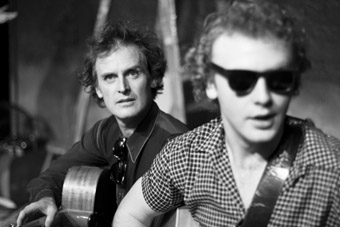
Andrew Henry (Johnny Cash), Matt Ralph (Bob Dylan), Chronic Ills of Robert Zimmerman, Tamarama Rock Surfers
photo Declan Kuch
Andrew Henry (Johnny Cash), Matt Ralph (Bob Dylan), Chronic Ills of Robert Zimmerman, Tamarama Rock Surfers
FOR ANYONE WITH EVEN A PASSING ACQUAINTANCE WITH TODD HAYNES’ I’M NOT THERE (2007), IT WAS IMPOSSIBLE TO SIT THROUGH BENITO DI FONZO’S EPICALLY-TITLED PLAY THE CHRONIC ILLS OF ROBERT ZIMMERMAN: AKA BOB DYLAN (A LIE)—A THEATRICAL TALKING BLUES AND GLISSENDORF, WITHOUT BEING REMINDED OF CATE BLANCHETT’S JUDE QUINN: “I’M JUST A STORYTELLER, MAN. IT’S ALL I AM.”
For one thing, the resemblance of The Chronic Ills’ Matt Ralph to Blanchett’s Quinn is uncanny, as is their resemblance to Bob Dylan, the man on whom their characters are based. For another, the segment of Haynes’ film that Di Fonzo’s play most resembles is the one in which Quinn appears. (Jude is one of six Dylan doppelgängers in the picture, each of whom occupies a stand-alone storyline rendered in a distinct cinematic style.) Both the play and the Quinn segment share a classic pop art sensibility, all appropriation, allusion and madcap namedropping (The Beatles and Allen Ginsberg show up in the film; Joan Baez, John Lennon, Yoko Ono and more in the play). While Haynes’ reference points are predominantly cinematic—Fellini’s 8 ½ and Pennebaker’s Don’t Look Back are the most obvious in the Quinn segment, though Richard Lester’s Hard Day’s Night gets a look-in, too, and Jean-Luc Godard’s Masculin Féminin is referenced throughout all six of the characters’ segments—Di Fonzo turns to Dylan’s music. Mimicking the formal operations of the songs, if not necessarily echoing their content, the play careens along as though it were a lost verse of Subterranean Homesick Blues, relying less on narrative cohesion or biographical accuracy than on free association and impressionistic causal logic.
For some people’s money, this is the production’s greatest shortcoming (as indeed, for more of their money, is true of the film). On the night I saw The Chronic Ills, one person even remarked to me that it felt as though Di Fonzo had written the play in front of the Wikipedia entry on Dylan, resorting to superficial pop culture references and betraying an unfamiliarity with the work. This criticism misses the point, and twice. In fact, The Chronic Ills’ impressionistic streak is evidence of an intense familiarity with Dylan’s work and its internal operations: episodic, fast-paced and surreal, the result is a text constructed entirely out of what Ginsberg, describing the songwriter’s lyrics, once called “chains of flashing images.”
The more serious point missed by this criticism is the fact that the play isn’t really about Dylan at all and therefore needn’t hew too closely to the recorded facts of the troubadour’s life. Rather, the real subjects of the play are storytelling, mythmaking and the formation of identity.
Dylan is the perfect subject for such a project for the simple reason that he has been an active participant in his own mythologising for so long, albeit in a paradoxical, often contradictory manner. He has been lying to and glissendorfing journalists—using language to intentionally mess with them—since his emergence in the sixties (“Mr Quinn, Mr Quinn! Do you have a word for your fans?” “Astronaut.”) and has experimented with the conventions of self-representation and self-mythologising in films such as 1978’s Renaldo and Clara, which he directed, and 2003’s Masked and Anonymous, which he wrote. At the same time, he has bristled at any attempts by others to mythologise him without his consent. His refusal to play any of the roles the culture has prescribed for him, paired with the near-constant reinventions that have allowed him to avoid such prescriptions, gives him a mercurial quality that seems to make mythologisation impossible even as it invites further attempts. I’m Not There is particularly interested in the ramifications of this latter contradiction, and indeed is a product of it. Inspired, according to the opening credits, by Dylan’s music and “many lives,” it offers its complex, fragmented narrative as a metaphor for the various selves we carry inside of us and the unknowability of any whole of which they may ostensibly be a part. (Todd Solondz’s Palindromes did something similar three years earlier.)
The Chronic Ills comes at things from a different angle, suggesting that even in the face of this essential unknowability we might still be able to glissendorf some idea of ourselves into being. Where I’m Not There is about self-effacement—or at least attempts to navigate the terrain of the self-effaced—The Chronic Ills is about storytelling as an act of self-creation. Robert Zimmerman talked Bob Dylan into existence, and that lie, as the titular parenthetical calls him, has been talking himself further into it ever since. What Di Fonzo captures so well with his wordplay monologues and his indifference to the historical record is the idea that a life is as much a work of art as any song or film or play. This is true of any life, of course, but of the artist in question it’s particularly so. Dylan’s life has been a performance fashioned almost entirely out of poetry and lies, which is really just another way of saying out of stories.
Tamarama Rock Surfers, The Chronic Ills of Robert Zimmerman: AKA Bob Dylan (A Lie), A Theatrical Talking Blues and Glissendorf , writer Benito Di Fonzo, director Lucinda Gleeson, performers Andrew Henry, Lenore Munro, Matt Ralph and Simon Rippingale, designer Eliza McLean, lighting design Richard Whitehouse, producers Jennifer Hamilton, Sophie Alize Finnane; Old Fitzroy, Sydney, April 6-24
RealTime issue #97 June-July 2010 pg. 36
© Matthew Clayfield; for permission to reproduce apply to realtime@realtimearts.net
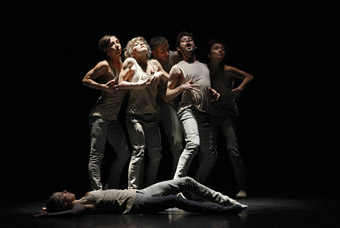
Are We That We Are, Sydney Dance Company
photo Jeff Busby
Are We That We Are, Sydney Dance Company
HERE’S A COLLECTION OF REVIEWS OF QUITE DIVERSE WORKS SEEN OVER RECENT MONTHS WHICH I ADMIRED OR QUERIED, SOMETIMES BOTH, OVER MATTERS OF FORM AND HYBRIDITY. ALL HAD SOMETHING SPECIAL TO OFFER.
adam linder: are we that we are
In a RealTime interview (RT95), young Berlin-based Australian choreographer Adam Linder said of his new work for Sydney Dance Company, Are We That We Are, “I’m personally very interested in altered states, in what is fundamental to the right side of our brain—the sensory, the visionary, the experiential.” The outcome is unlike anything we’ve seen from the company, a series of strange images heightened by idiosyncratic choreography and lighting that dances. As if to suggest that the work takes place in one man’s mind, Linder enters the stage from the auditorium and sits at a desk from which he views a woman with a long rope controlling a horse-man, prancing hypnotically in a wide circle, trotting, falling. Figures unfurl from Linder’s desk. A voice-over speaks of being “reborn to the possibility of rapture.” An elaborate tangling of bodies entwines one woman (Natalie Allen) in particular, light states changing rapidly with each shift in the engagement, her body maximally expressive within the tightest of limits, the apparent indifference of her oppressors. A huge column of light descends like the rolling monolith from 2001: A Space Odyssey (a favourite of ecstasy seekers) but emitting rich, fluid colour states against epic neo-60s guitar as Linder and Charmene Yap, in the demanding centrepiece of the work lock into a sensual knot, a two-headed creature, Kama Sutra-ish. They work close to the floor, driven, disorienting in their relationship to the illuminating, alien surveillor hanging above.
In a big mood swing, a chorus line, arms linked, prance in like a row of Norman Lindsay fauns—soon Linder will ride them like a king on a chariot. In the final scene, as a disturbing bass line distorts, the dancers emerge upstage holding balloons, moving forward, glowing, Linder amongst them, but eventually reversing as if he’s in this, but not of it, echoing the work’s opening. The dramas of control and release, the sci-fi-ish and sexual evocations, group fantasies and the final smiling love-in (a relatively unremarkable scene) are what we expect of altered states but are here imbued with a disturbing otherness and enriched by imaginative choreography and committed dancing, not least from Linder himself, and superb lighting by Nick Schlieper. Are We That We Are was on a double bill with Rafael Bonachela’s 6 Breaths.
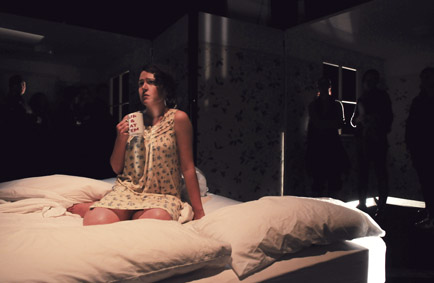
Clare Britton, Hole in the Wall, Performance Space
photo Heidrun Löhr
Clare Britton, Hole in the Wall, Performance Space
hole in the wall
Matt Prest and Clare Britton’s Hole in the Wall is above all a uniquely engaging sensory experience. In four groups of 10 we are ushered into small wall-papered, low-ceilinged rooms in the performance space. The door slams shut behind us, the windows are closed. The room moves. We move to keep up (the rooms are on wheels, we are walking on the performance space floor). We have no idea where we are. The room stops and we are plunged into darkness from which emanates an anxious male voice bewailing lost opportunities, uncertain futures and the relative pleasures of mortality. Lights up and we’re on the move again. The doors open and we face a bed and the other rooms and our fellow audience—we’ve formed a house. A woman struggles with a mattress as if being devoured by it, crying for help until interrupted by her male partner who doesn’t get this game (which is perhaps little different from the anxious musings to which we’ve just been submitted). They settle down, murmuring further anxieties in their restless sleep in an off-kilter dialogue. That’s how the show works, without giving away too much more, save that the rooms are locked in other configurations and that the couple display their anxieties in monologues, literally running arguments, a dance (part erotic, part threatening) and some nervous partying.
At the core of this couple’s anxieties are dreams of perfection pitched against the blandness of contemporary living and complicated by communication problems. Each performer evinces a comfortable physical presence, wandering among us, appearing through a window, darting through slammed doors. Vocally though they’re less comfortable, Britton too loud in what is after all an intimate space, Prest a tad over-nuanced in his delivery and both slipping into conventional acting intonation when they need to find a performative voice equal to the strange world they have created spatially. This problem is amplified by a tame script that while calculatedly deploying the cliches of domestic argument and everyday existential crises lacks the specificity and poetry with which, again, to match the distinctiveness of the rest of the artists’ creation. The ending too is sentimental: given the multiplying tensions and outpourings of angst, it’s too easily resolved. I wonder also, about our role as audience, simply occupying rooms like ghosts or unacknowledged guests (save in the party scene). For all this, Hole in the Wall remains a memorable experience, part fun disorientation, part Bachelard-on-wheels and definitely worthy of a longer and more developed life.
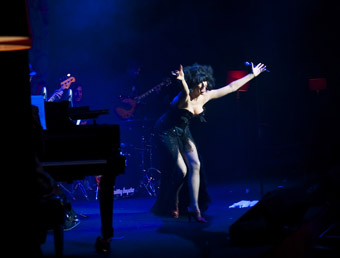
Meow Meow at Late Night Lounge, Sydney Opera House
photo Justin Malinowski
Meow Meow at Late Night Lounge, Sydney Opera House
meow meow: meow to the world
Meow Meow was in town, “back by her own demand”, with a return season of Meow to the World: Crisis is Born, a scabrous out-of-schedule Xmas celebration of the Global Financial Collapse. Compared with her other shows, where her high maintenance neediness (it’s still here) dominates, this Meow Meow is up there with Stephen Colbert of the Colbert Report, walking the satirical knife edge of simultaneously playing out and undercutting the kind of vicious selfishness that free market narcissism yields, not least during economic downturns. She provides the flowers for the audience to throw for her sumptuous, gorgeously frocked opening but then commences to savagely cost-cut, complaining (“Did anyone bring any atmos? Do I have to do everything!”; “No smoking? I might as well have brought an extra large Ventolin), stripping herself and her band of their clothes (“the Opera House cut the dry-cleaning budget”). She steals drinks and food from the audience (“Just looking for a cheese platter. The Opera House didn’t feed us”) and introduces three local youngsters (“the orphans—we ordered three”). These she then ruthlessly exploits, bullying them through “My Favorite Things” and “Silent Night” before propelling them into the audience to beg for money.
But there are more rewards than clever satire as dark songs like the Dresden Dolls’ “Missed ME” and Nick Cave’s Red Right Hand deepen the mood, while more buoyant classics, art house and popular, reflect the mood swings of our times. Meow Meow is in more than excellent voice, the band, led by New Yorker Lance Horne is top notch and I leave Meow to the World heartened that cabaret can still bite. Meow to the World: Crisis is Born premiered in New York in 2008 and won Best Cabaret in the Sydney Theatre Awards for 2009.
the folding wife
A very welcome Mobile States tour of The Folding Wife is taking this inventive and culturally idiosyncratic production to a wide audience. Jan Cornall’s review of the original production, “One woman in many: survival and resilience” (RT 79) says it all: “The audience is left with sensual impressions of lace and blood, laughter and sorrow, ‘roasted corn on Sundays, coloured parasols reflecting the white heat of the sun’ and a heritage of women, strong, beautiful and dignified, who have survived on memories of a glorious past or a projected future as they bent and folded into themselves a nation’s pain.” I recommend you read the whole review.
The particular power of The Folding Wife emanates from the construction of the work as a living installation—Valerie Berry (deftly playing the female generations of one family) is casually sculpted and adorned into shape by two on-stage artists using clothing, props and projections. It’s as if we are witnessing the forces of family, history, politics and culture (Filipino and then Australian) shaping a life which, in the end, refuses manipulation. Strong physical gestures (an Imelda Marcos shoes routine is a highlight), sensual, if sometimes alarmingly visceral screen images (we simultaneously witness their making), and lateral story-telling align with a poetic text to yield a curiously contemplative experience—of a work of art in more than a simply theatrical sense.
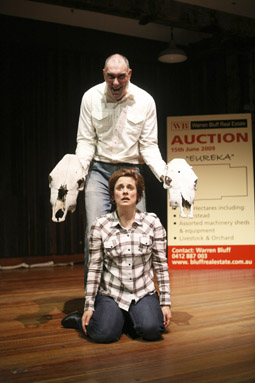
Stefo Nantsou, Lindy Sardelic, Burnt, Zeal Theatre
photo Tracey Schramm
Stefo Nantsou, Lindy Sardelic, Burnt, Zeal Theatre
burnt
To see the Zeal Theatre trio performing Burnt is to witness a company hard at work, as a very good band (whose instruments double as FX devices), amiable hosts and excellent actors, initially as a farming family rounding up sheep and then, virtuosically, adding a large number of other characters from a drought-stricken rural community. The story is sadly predictable if rooted in fact (the company had done on-the-ground research into growing poverty, probable loss of an inherited property, desperate measures, new multicultural pressures, family tensions and the potential for suicide) but is written with wicked wit and a touch of pathos and performed with remarkable precision—just the right amount of idiosyncratic personality touches and the capacity to shape the multitude of scenes like a team of adroit film editors. Other playwrights could learn much from them. This is bare bones theatre of the highest order—a few sheep and cattle skulls litter the stage with a car seat and an oil drum; the rest is embodied in these truly engaging performers.
fox
Writer Margaret Wild and illustrator Ron Brooks’ Fox is an award winning picture book for young people about a bushfire-injured magpie aided by a one-eyed dog. Their relationship is sundered when a fox promises more than the dog can offer. The book’s storytelling is very spare, while the opera version is theatrically and musically elaborate. An ever present soprano (her character otherwise undefined) is the only singer and delivers the narration (Sarah Jones has a fine voice but is at her best in lower registers where consonants remain intact) while three performers enact the animals, but in several and inevitably confusing modes—as actors, as puppeteers and in projections.
Unlike Red Leap’s adaptation of Shaun Tan’s The Arrival (RT95) which was for the most part faithful to the author’s aesthetic, this account of Fox further complicates things by gendering the scenario—the fox is a handsome, swaggering male seducer and magpie a helpless female, with their stylish costuming taking us a long way from the book’s plain, bush reality. While there are moments of evocative puppeteering, brisk action and a dash of comedy from the dog, each episode is framed by song in the operatic mode (not always immediately memorable) yielding longeurs that flatten the drama, despite director Kate Gaul’s inventiveness. There is some attractive writing from composer Daryl Wallis but it’s not integrally dramatic, dominating rather than serving the story. For bringing new opera to young audiences, Fox is to be admired, if in the process revealing the challenges of adaptation.
–
Sydney Dance Company, New Creations, Are We That We Are, choreography Adam Linder, dramaturgy Sally Schonfeldt, costumes Jordan Askill, lighting Nick Schlieper, sound Adam Synnott; Sydney Theatre, March 23-April 10; Hole in the Wall, concept, performance, design Matt Prest, Clare Britton, concept, director Hallie Shellam, text Halcyon Macleod, lighting design Mirabelle Wouters, concept, set Danny Egger, sound, animation James Brown; Performance Space, CarriageWorks, May 26-29; Meow Meow, Meow to the World: Crisis is Born, The Studio, Sydney Opera House, March 2-14; Urban Theatre Projects, The Folding Wife, performer Valerie Berry, writer Paschal Daantos Berry, director Deborah Pollard, design, multimedia Anino Shadowplay Collective, lighting Neil Simpson, Performing Lines for Mobile States; Performance Space, CarriageWorks, Sydney, May 19-22; Zeal Theatre, Burnt, writer-performers Tom Lycos, Stefo Nantsou, performer; Lindy Sardelic, director Stefo Nantsou, music Tom Lycos, Wharf 2, Sydney Theatre Company, May 25-28; Fox, Monkey Baa with Siren Theatre Co, director Kate Gaul, composer Daryl Wallis, performers David Buckley, Jay Gallagher, Sarah Jones, Jane Phegan, designer Gabriela Tylesova, lighting Designer Luiz Pampolha, Seymour Centre, Sydney, April 10-17
RealTime issue #97 June-July 2010 pg. 37
© Keith Gallasch; for permission to reproduce apply to realtime@realtimearts.net
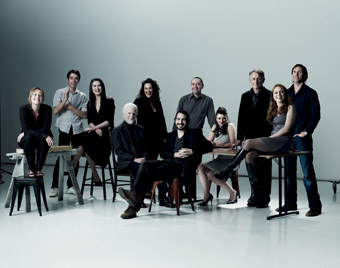
The Actors Company (2008)
photo Jason Capobianco
The Actors Company (2008)
JAMES WAITES’ PLATFORM PAPER, “WHATEVER HAPPENED TO THE STC ACTORS COMPANY?” IS A RARITY IN AUSTRALIAN WRITING ABOUT THE THEATRE. IF MORE LIKE INVESTIGATIVE JOURNALISM (WAS THE ENSEMBLE KILLED OFF?) THAN FORMAL ESSAYING (IF NOT WITHOUT CONSIDERED THESES) IT’S WRITTEN WITH A DOCUMENTARY MAKER’S ATTENTIVENESS TO HIS SUBJECTS (DRAWING ON NUMEROUS INTERVIEWS) AND A NOVELIST’S NARRATIVE DRIVE (WHO DID IT?). BUT WHAT GIVES THE PAPER ITS PECULIAR POWER IS WAITES AS WITNESS.
In a career that has included being an arts documentary script writer for ABC radio, a part-time lecturer in drama, research assistant to Rex Cramphorn, editor of Theatre Australia and, notably, reviewer for the National Times, Sydney Morning Herald and now on his own website (www,jameswaites.com), Waites has closely observed for over 30 years plays, careers and movements. In that time he has seen ensembles and other collaborative efforts (Australian Nouveau Theatre, Lighthouse, Gilgul, Keene/Taylor Project, Paris Theatre) come and go and has a clear understanding of their inherent complexities, of the differences between top-down and bottom-up models and of many a contemporary actor’s desire to be a collaborator—more than “a gun for hire.” The essay’s dynamic functions around these often binary complexities.
STC artistic director Robyn Nevin’s admirable desire was to create great acting opportunities of a kind difficult to achieve in the standard show by show theatre model. But is a large state theatre company the place to do it? Waites posits contradictions in Nevin’s handling of the ensemble, some circumstantial given the nature of the institution that housed it, others seemingly at odds with her own experience. As a young actor in the 70s Nevin had been part of the Performance Syndicate, an intensely collaborative ensemble directed by Rex Cramphorn. But, given her wider responsibilities for the STC, she could not lead the Actors Company nor act with it. Instead, after a failure to appoint a leader, three successive ‘managers’ were appointed for the ensemble. Waites writes, “This failure to find a ‘first among equals—should that read ‘to decide between democracy and autocracy?’ was to underpin many of the conflicts that lay ahead.”
A consistently top-down approach meant that seasons were programmed and plays cast without consulting actors, let alone discussions shared about direction and design. Some guest directors had never or only briefly seen the actors at work, and similar casting decisions were made from show to show. Even more critical, from the beginning there seems to have been no discussion between Nevin and the actors about precisely what their purpose was as an ensemble.
Nevin’s closest contact with the ensemble came with directing Mother Courage: “despite a major incident during rehearsals, by opening night [in May 2006]…everybody on stage looked good.” After several frustrating months the actors had arranged their own meeting and Nevin wandered into it—a tense encounter ensued: “[T]here is no avoiding the brutal fact that something terrible had happened that Easter Monday. It was not immediately apparent, but a wedge had been driven between Nevin and the actors. After so much work in getting the ensemble started, Nevin could not get over the feeling she had been profoundly betrayed. It seemed to her that she had given birth to a spider that ate its own mother.”
Waites reports that in interviews Nevin was “no less critical of herself” than he has been in his essay. Her belief that an ensemble forms and evolves through working together, not through talk, had proven problematic. Company spirits however were lifted by Barrie Kosky who, if “leading from the front”, offered “intense participation” in the creation of the epic, The Lost Echo. Waites praises Nevin: “Few in Australia had given Kosky this kind of unflinching support.”
Casting of a fixed number of players (Waites calls it the Holy 12) proved to be problematic. Kosky would have liked two senior female actors in the ensemble, Benedict Andrews a range of guest performers to keep the situation fluid. But in 2007 Andrews’ production of Patrick White’s The Season at Sarsaparilla, showed that fixed numbers and gender constraints “can occasionally produce an unexpectedly successful result.” Again the ensemble was working with an auteur, and on a complete version of the set from the first day of rehearsals. Responding to Andrews’ very precise demands, “individuals felt it safe to take risks. They would try things they would never have dared try in a one-off production.” As with The Lost Echo, the combination of auteur and ensemble appears in Waites’ essay as a fruitful model, although with provisos introduced by the company’s more complicated experience with Andrews on War of the Roses, dealt with later in the essay by Waites.
Waites’ praise for The Season at Sarsaparilla is considerable, especially if we think about it in terms of STC’s exports to New York—Hedda Gabler, A Streetcar Named Desire. “If there was ever an Australian production that deserved to be seen by the rest of the world, it was [The Season at Sarsaparilla]. For me in my 30 years of following and writing about the making of Australian theatre, this production represents, both culturally and creatively, the highest point. An onstage Everest.” This one show alone makes Waites grateful for the existence of the Actors Company.
Difficult times followed: problems with directors, serious arguments, resignations, illness. But the work kept being made and the pressures of back to back productions alleviated. Waites’ deftly sketches ensemble members: Pamela Rabe as the “nurturing ‘wolf mother’”, the experienced, inspiring older men, the ‘malcontents’ (a complex picture) and offering glimpses of other members. Rabe’s direction of Daniel Keene’s Citizens (with Tim Maddock directing Soldiers in the other half of the double bill, The Serpent’s Teeth) appears to have been a relief for the company, being directed by one of their own and in terms of their own working method.
So why didn’t the Actors Company survive beyond three of its projected five years? The new artistic directors, Andrew Upton and Cate Blanchett thought it financially unsustainable, but even if they had the money they had reservations, “we thought it was too sacred.” Like some others, Pamela Rabe, for whom working as part of the ensemble had been “the most important and electric experience of my professional life,” was left with a sense of unfinished business.
Waites ends his paper with core lessons “any state theatre company would do well to heed if it set up an ensemble within a broader company framework.” He doesn’t say they shouldn’t do it, although the essay points towards very likely intractable institutional problems.
First, he recommends stable leadership that will provide assurance and continuity. Within this framework, guest directors need to fit “the ensemble’s over-arching goals.” These, of course, are the first things that need to be established. Presumably Waites would want the role of the actors clarified—what kind of ensemble will they be getting themselves into, what precisely will be their creative contribution? Secondly, he argues for more flexible ensemble numbers—although he doesn’t address how this might affect the very sense of ensemble that comes from familiarity and continuity. Thirdly he recommends alternative activities for ensemble members—regular skills classes, small-scale experimental works: “opportunities to explore ‘simplicity’ and ‘intimacy’” as opposed to constant involvement with “juggernauts.” To do this he might have added directing opportunities given his what-if support for Rabe as potential Actors Company leader (a huge challenge, mind you, for a beginner director).
By the time of the War of the Roses, the Actors Company was far from its original self, featuring guest performers including Cate Blanchett and only small roles for some long term members, but there was just enough of a rewarding sense of continuity, not least evident in a scale of vision rarely seen in this country, expertly inhabited and realised by its actors. Perhaps what we witnessed over the years was in fact a directors theatre enabled by a variably willing ensemble. Without doubt the supreme performances of the three years were seen in the productions by Kosky and Andrews, who each, at different points in the essay, wonder about the role of the director—Kosky about an inherent Australian resistance to the strong director and Andrews about the best work coming from strong leadership. The degree of creative freedom an actor has within an ensemble led by an auteur is likely to vary as enormously as the differences between auteurs. Some are more authoritarian or democratic than others—but, essentially, the vision is the director’s. Other kinds of ensemble, not part of larger institutions, are about creative power sharing—the director’s vision is important, critical even, but subject to creative cooperation, even compromise. The Actors Company is a very particular case, whereas in Lighthouse, say, under Jim Sharman, the ensemble was the company, not one company inside another, but the lessons can still apply.
Waite’s essay is eminently readable, the writing relaxed and evocative, the tone aptly personal as he draws on his considerable experience of theatre and his judgments for the most part are fair and considered. Occasionally the writing is calculatedly dramatic, tipping into hyperbole, making the reader wary: “…the lines of communication were simply not as open and flowing as they needed to be. Sadly, it was this that triggered the descent into the maelstrom that occurred over the course of the next two productions and left the Holy 12 permanently damaged.” This kind of narrative forecasting is also not uncommon, if adding a certain novel-ish suspensefulness.
Like much else in Australian theatre history the Actors Company is unlikely to be documented anywhere else soon, so this perceptive, intimate essay is more than welcome as a critical homage, a tribute to a partly successful, sometimes highly significant venture into too rare a form in this country, the ensemble.
James Waites, Whatever Happened to the STC Actors Company?, Platform Paper No 23, Currency House, Sydney, April 2010
RealTime issue #97 June-July 2010 pg. 38
© Keith Gallasch; for permission to reproduce apply to realtime@realtimearts.net
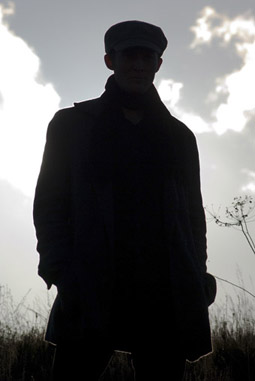
Lawrence English
photo Pawel Kulczynski
Lawrence English
WHEN I ARRIVE AT THE HOME OF LAWRENCE ENGLISH, THE PLACE IS LITERALLY PULSING WITH THE DRONE OF A FLOOR SANDER GRINDING BACK THE FRONT ROOM FLOORBOARDS. THE DEAFENING DIN MIGHT SEEM A WEIRD INTRODUCTION TO AN ARTIST KNOWN MORE FOR SUBTLE SONIC MINIMALISM, BUT FOR ME IT SERVES AS A REMINDER OF THE TIME WHEN I FIRST ENCOUNTERED ENGLISH, BACK IN THE STRANGE DARK ERA OF 1990S INDUSTRIAL MUSIC IN BRISBANE. SINCE THEN HE HAS GONE ON TO BECOME ONE OF AUSTRALIA’S KEY MEDIA ARTISTS, AND, THOUGH HIS CURATORIAL AND CREATIVE ACTIVITIES TAKE PLACE ACROSS THE GLOBE, HE CONTINUES TO MAKE BRISBANE HIS BASE.
room 40 origins
English’s sound work explores environmental and musical sources and is highly regarded for its intelligent invocation of perception, memory and space. He also curates the ROOM40 imprint, which has consistently issued an impressive array of sound-art related activities and events. ROOM40 is celebrating its 10th year, so I talked with English about the label and his thoughts about how this last momentous decade unfolded. He explained, “ROOM40 came about as a sort of umbrella organisation. I thought of it having the publishing arm, the curatorial/gallery/installation project-oriented arm and then the concert/festival part of it, with them coming together under that banner with some kind of focus. So people could have an idea of what they were going to experience or at least think, ‘I’ve gone to two other events or I’ve bought two CDs so I’ll take a risk with this one even though I don’t know who that artist is.’ In some ways it has been a process of building up that trust.”
tape trading
I ask English about his history in music distribution and he tells me about how it all started with cassette tape trading: “I got my first PO Box when I was 15, because my parents got sick of packages turning up at the house, and I was kind of paranoid about them not turning up—they were always oversized and never fit in the letterbox. In fact we only closed that PO Box this year…it felt like a real cutting off. You should have seen the lady at the post office when I went to close it, I was like, ‘I’m really sorry, I’m going to have to close this box now.’ She was really upset…Tape trading was a fundamental part of how I got into music. You’d basically send off a bunch of stuff, and cross your fingers a package was on its way to you…What’s so interesting now if you want something, even something that’s out of print, you type it into Google, or iTunes, or whatever, and it’s there, and you download it, and you’ve got it in 10 minutes. I remember, when you started reading about a band, first you had to find the person with the demo tape, trade with that person…it could be a process of like 18 months before you finally heard the band! You’d built up so much anticipation by then. But when you finally got it…you’d spent so much time invested in it, and it was so great finally getting to hear that music and say, ‘Oh these guys, they sound so amazing!’”
becoming a label
On the animating forces behind becoming a label, English nominates “the satisfaction of getting people’s work out there. Every single record we’ve put out, I can say, 100%, I have a very deep respect for. They’re essentially giving you their child, their artistic first-born, saying “Here, can you deliver this to the right ears?” English explained how he tried to express this responsibility in the creation of ROOM40’s aesthetic, which is “not necessarily a sonic aesthetic—it’s an aesthetic of the label, involving non-standardised packaging and attention to the overall presentation.” Though creating a catalogue wasn’t on his mind when he started out, “When you look at it now, 10 years later, it looks like a catalogue.”
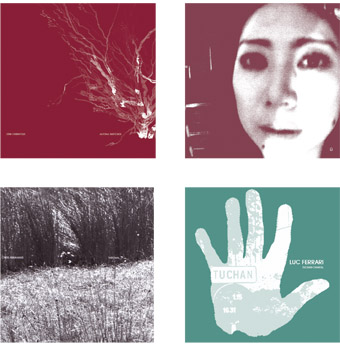
ROOM40 covers, clockwise from top left – Erik Griswold – Altona Sketches , Tujiko Noriko/Lawrence English/John Chantler – U, Luc Ferrari – Tuchan Chantal, Chris Abrahams – Thrown
archival life
The archival aspect of ROOM40 “has always been a big part of it” according to English, “because, in traditional music circles, in six months’ time an album’s irrelevant. Ideally what I wanted to do was have an album where you could come to it in five or 10 years and still have an engaging and meaningful experience.” He gives the example of Melbourne artist Rod Cooper’s 2006 Friction album: “it’s still current, it still makes sense, it’s still a total summary of part of the work he’s done.”
filling a brisbane gap
We discussed how ROOM40 differs from a traditional music label, and how it evolved organically. “Obviously, being [in Brisbane] in the 1990s, there wasn’t a whole lot going on. There was Small Black Box [an exploratory music series] and that was it. There wasn’t a lot of opportunity for international artists to come here. A lot of people skipped Brisbane. Even What is Music? didn’t come to Brisbane until like 2003…That has really only changed in probably the last 10 years. There was a big gap up here.
“So that was the motivation behind the Fabrique series at the Powerhouse (40 events over eight years), to try to build up the audience. I always felt frustrated at the way events featuring experimental music felt a bit…exclusive. I just didn’t agree with that. As far as I was concerned, you could be into pop music, and that wouldn’t matter; you’d come to one of these events and, if it was articulated to you in the right way, you’d give it a try and maybe like it, maybe not, but at least you had the experience. I was definitely not part of the scene, because I was interested in a lot of other things as well, like punk rock and hip hop. I thought “I love experimental music…if I can come to it, surely other people can. And obviously that happened, look at the way things have developed in Brisbane. Take Audiopollen (the weekly underground music club 2007-2009) for example. You can see that the audience has grown massively.”
As part of the ongoing conversation with that growing audience, this year also sees the fifth anniversary of Open Frame, ROOM40’s annual festival (Brisbane Powerhouse, Oct 6-7), which this year will also present an event in London in November. Legacy projects involve the reissuing of some of the label’s albums on vinyl, such as Ben Frost’s classic Steelwound (2003) and Chris Abrahams’ Thrown (2005). There are other interesting plans afoot.
a guide to site-listening
English explains that ROOM40 is to release its first book through the label, a site listening guide—“Rather than sight-seeing, I’m asking people to site-listen.” The book’s introduction promises not “an exhaustive list of listening locations around Brisbane,” but rather, an offer of “possible encounters, personal reflections and suggestions as to what sounds might be worth listening out for in this city.” It’s easy to see how this publication, with its “open-ended invitation to listen to the spaces you might find yourself in,” has evolved naturally out of both the artist’s creative explorations of sonic environments, along with ROOM40’s ear-opening agenda. As Lawrence English explains, “it’s about privileging the ears over the eyes.”
http://www.room40.org
RealTime issue #97 June-July 2010 pg. 39
© Danni Zuvela; for permission to reproduce apply to realtime@realtimearts.net
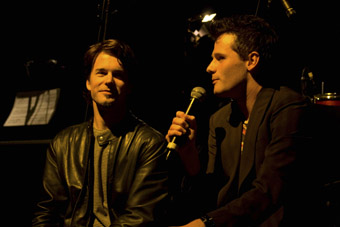
Alex Pozniak, Andrew Batt-Rawden
photo Emily Sandrussi
Alex Pozniak, Andrew Batt-Rawden
BEING MORE THAN AN EMERGING CONTEMPORARY MUSIC ENSEMBLE, CHRONOLOGY ARTS IS COMMITTED TO BUILDING NEW MODELS FOR PERFORMANCE, FUNDRAISING AND COMMISSIONING. HAVING BEEN IMPRESSED BY TWO OF THE ENSEMBLE’S ‘GENRE-BUSTING’ CONCERTS, ONE OF THEM IN THE RECENT ISCM WORLD NEW MUSIC DAYS FESTIVAL, I MET WITH DIRECTORS ALEX POZNIAK AND ANDREW BATT-RAWDEN, WHO ARE BOTH IN THEIR 20S AND BOTH COMPOSERS, TO LEARN WHAT STRATEGIES THEY WERE EMPLOYING IN MEETING THE CHALLENGES OF SUSTAINABILITY FOR ‘CONTEMPORARY CLASSICAL’ MUSIC.
The ‘genre-busting’ tag became a running gag in our meeting. Recently the pair had been advised that if they wanted arts funding, that’s what they’d have to be—genre-busting. From what I’ve experienced of their work, they already are. In Gradations of Light, large video projections synced with performances, musicians moved though the audience and three electric guitars powered Pozniak’s Illuminations (www.realtimearts.net/article/92/9553). “We’ll just have to be more genre-busting,” Pozniak says.
Chronology Arts has quickly carved out a niche. Batt-Rawden says that “since the Seymour Group died” Ensemble Offspring, with its contemporary compositions and invaluable forays back across 20th-century musical movements, have occupied centre-stage, “but we concentrate on getting the really new, new music” with which to attract audiences and donors.
While Pozniak and Batt-Rawden see arts funding as part of Chronology’s future, they’re working hard at finding alternative income sources and Batt-Rawden has already had some success. Early concerts relied on ticket sales, small payments to musicians (these have grown, they say), one-off composition grants for contemporary works from the Sydney Conservatorium of Music (“really designed for groups like us”) and, significantly, private philanthropy. Batt-Rawden says that Chronology Arts has been quite reliant on a few key donors giving from $2,000 to $5,000 each. Other strategies are event-based, like private performances or an art auction expected to raise $20,000. In June, Chronology Arts is holding a private dinner in a restaurant for its supporters at $200 head with three small installations plus selected food, wine and music—”which we’re composing right now!” The diners will be current and potential commissioners. It’s ironic, jokes Pozniak, “contemporary music is not usually seen as aiding digestion.”
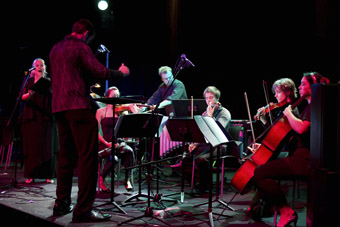
Chronology Arts, In Focus, 2009
photo Emily Sandrussi
Chronology Arts, In Focus, 2009
Batt-Rawden’s energies are currently focused, among other things, on the Commissioner’s Circle, which he describes as “a unique marketing concept to promote the concerts as well as raise funds for composers.” How does he find the potential commissioners? “Networks are very important,” he replies, “and chance—I talked to someone about the idea after a concert and they offered me a cheque.” He adds with a grin that “the real secret is home-made pasta dinners” for prospective donors. Previous fundraising experience, including with Song Company, has clearly given Batt-Rawden the confidence to push ahead in an area which might make many young artists wary. But structure helps: the group’s Commissioner’s Circle gatherings bring together composers and donors as potential partners.
I ask if people who become commissioners are likely to repeat the experience, as they do, say, in the visual arts. “It’s the whole idea,” says Batt-Rawden, “A commission is a long-standing relationship.” For that reason he wants a younger generation to take on the commissioning role and provide long-term continuity: “Perhaps we’ll have to call them non-executive producers,” he quips, alert perhaps to the need to find a seductive contemporary label.
As composers themselves and with empathy for others grounded in their own experiences, how do Pozniak and Batt-Rawden fare with commissions? “My first one was $50 a minute for a string quartet,” recalls Batt-Rawden. “I’m at the lower end, with the price gradually rising.” “It’s half paid, half unpaid,” says Pozniak, “which I don’t expect to change any time soon, especially with Chronology Arts [Laughs]. A Melbourne Symphony Orchestra development project had a fee, not a great one, but it was to write for an orchestra! If in 2012 I could make $10,000 for three works, that would be good; the equivalent of a day’s work a week. I write four or five pieces a year and, to survive, teach at Sydney University, the Conservatorium High School and McDonald College. And now I’m being paid by Chronology Arts. But Andrew does more work while I’ve been busy composing.”
Although Batt-Rawden is on a “part-time wage for 70 hours a week” with Chronology Arts, he clearly relishes his role: “I see fund-raising as just like sales with targets and deadlines and a strategic approach. We’re not begging artists.”
As for their group’s investment in their concerts, Pozniak explains that “some are more extravagant in terms of the number of performers involved and what the incidentals are in terms of lighting and cross-artform components. So if we get worried about money we’ll tone down the instrumentation.” Batt-Rawden adds that “each event costs $5,000 to $15,000, with a lot of in-kind support and not a lot of money in advance—we have to foster relationships early so come crunch time donors are already committed.”
We come back to the issue of how to seek out commissioners. Batt-Rawden emphasises that “Commissioner’s Circle is not just for Chronology Arts. We’re interested in securing commissions for, say, Song Company and very interested in ‘genre-busting’ cross-artform temporal art commissions that don’t only involve composers.” Pozniak points to a problem and its solution: “A lot of people don’t check out new classical music concerts because of the outmoded format, so we bring in other elements to make the performances more appealing, potentially securing another audience that’s supportive of other art forms.” Batt-Rawden declares, “We’re market-conscious artists!” Pozniak says, “We have to respond to tech advances or we’re not current, but there are ways of being current and genre-busting without selling out. We’re opening our minds laterally to assimilate what’s out there.”
I ask how supportive Chronology Arts finds Sydney. Pozniak thinks that “being youngish we’re a kind of link between the Con and Sydney Uni—the opportunities they offer—and the world outside. But we had to build our own support. Just because you’ve graduated, Ensemble Offspring aren’t going to commission you. We wanted to create opportunities for ourselves but also for performers and composers at the Con with a lot of potential, if they want to tap into the contemporary thing. Mostly they don’t, but it’s curious, the second-years I teach are very proactive. They look up to what we’re doing, we talk aesthetics and composition and they’re fired up and they do their own things. We’re catering for graduates. We’ll also host a concert of undergrad works in Sydney Uni’s Verge Arts Festival. It’s a kind of mentoring.” Batt-Rawden agrees, “Sydney’s great at monuments but who’s looking after the small fry and the estuaries where the arts really develop? It’ll become easier for emerging artists when we get smarter at marketing and networking and philanthropy and online delivery.”
Shortly after our meeting it was announced that Chronology Arts had been awarded a Sydney City Council partnered Arts Bunker residency at Sydney University’s Seymour Centre, a two-year program with office space and “mentoring in all areas of arts management.”
Forthcoming Chronology Arts concerts include the remarkable pianist Zubin Kanga in Piano Inside/Out Verbrugghen Hall, Sydney Conservatorium of Music, July 2, in a program including works by Liza Lim and Drew Crawford. On July 28 Kanga will join another Australian ‘international’, soprano Jane Sheldon, in Chiaroscuro featuring Apparitions by George Crumb and Sonetos del amor Oscuro by Rosalind Page. Pozniak is looking forward to a September 15 concert featuring Chronology’s core ensemble (flute, Jane Duncan; cello Eleanor Betts; saxophone Andrew Smith; clarinet Toby Armstrong; viola Luke Spicer; and piano Jacob Abela, with conductor Geoff Gartner) and compositions by Pozniak and Batt-Rawden and others, a reminder, he says, that despite the large scale of some of their concerts “we are an ensemble.” It’s an ensemble with a distinctive vision, one that can only strengthen Sydney’s fragile new music ecology.
www.chronologyarts.net
RealTime issue #97 June-July 2010 pg. 40
© Keith Gallasch; for permission to reproduce apply to realtime@realtimearts.net
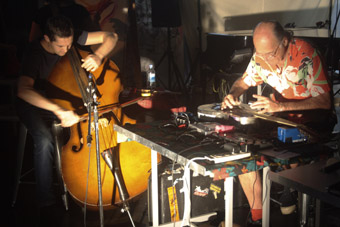
Mike Majkowski, Mike Cooper, See Hear Now
photo Glen O’Malley
Mike Majkowski, Mike Cooper, See Hear Now
WHILE IMPROVISATION IS NOT A FAVOURITE OF MINE, THERE WERE ENOUGH MOMENTS DURING THE MUSIC CENTRE NORTH QUEENSLAND’S SEE HEAR NOW MUSIC-DRIVEN, MULTI-ARTFORM FESTIVAL WHEN ARTISTS AND THEIR MEDIA ‘CLICKED’ BEAUTIFULLY AND THE JOY OF THE ARTFORM CAME ALIVE. ANY RESERVATIONS I HAD WERE MAINLY TO DO WITH THE ‘ART’ OF COLLABORATION SO ESSENTIAL IN IMPROVISATION—WOULD ARTISTS REALLY LISTEN TO EACH OTHER; USE SPACE AND SILENCE AND TIMING TO INTERPRET WHAT WAS BEING SAID; AND ADD TO THE MOMENT RATHER THAN SIMPLY CREATE PARALLEL OR EVEN UNRELATED PATHS?
My reservations however were not shared by the audience. Right from opening night there was an air of excitement and expectation at what might eventuate. Although music-driven, each concert included a component of conventional visual arts, film, photography or projection plus movement or dance or theatre. Performers flown in for the weekend were all involved in music technology in some way: Mike Cooper, slide guitar; Grayson Cooke, live audio-visuals; Rod Cooper, original instruments; Mike Majkowski, bass; and Erik Griswold, prepared piano.
The most satisfying collaborations were those involving Gold Coast-based performance poet Jayne F Keane. Her theatrical skills supported entertaining narratives, at times pithy or poignant. When her collaborators entered her space, the improvisations came alive.
Keane and technologist/composer Steven Campbell presented the most polished improvisation of the festival, They Say Drowning Is Like a Dream. The result of an ongoing collaboration, it is perhaps unfair to single out this work given the scaffolding that time and familiarity brings. They Say Drowning…was well paced and the media (poetry and sound bytes) worked well together, creating a whole that was more powerful for its pace, cohesion and sense of purpose.
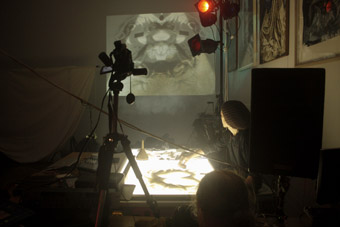
Tom Jefferson, See Hear Now
photo Glen O’Malley
Tom Jefferson, See Hear Now
Visual artists at the festival seemed largely impervious to what was going on around them, and even some musicians and dancers whose art forms are rooted in sound, space and silence appeared to lack the ability to work with co-performers. An interesting performance where more space would have enhanced the work involved a mandala created by emerging artist Tom Jefferson, drawing in sand on a light box. The patterns were projected on a wall, and then processed through an effects box by lighting expert Mark Bancroft. Initially the kaleidoscope-like shifts lifted the action, giving it another dimension. However, too many changes and gradually too many effects weakened the impact, leaving no space to savour or even retain a connection with the physical performers. The projections became a distraction rather than a complement to the whole.
Where there was a discernible connection between performers, the results were exciting. Percussionist Ian Brunskill played with exceptional intelligence in the work Frock, using a huge array of percussion sparingly and to good effect. At the climax of this seven-part improvisation, built around Keane’s poetry and readings from 18th-century newspapers, Brunskill smashed sheets of glass and china plates. Keane followed up with a constrained poem where she lined up beer bottles as a sign of aging and loss. Theatre practitioner Mark Reed was outstanding as a sinister figure while Mike Cooper joined in with an inspired musical commentary on both Reed’s characterisation and Keane’s poetry, again with intelligence and insight, slipping layers of slide guitar riffs and motifs into the improvisation space.
The festival’s visual arts curators, Sue Tilley and Selena Smith, engaged imaginatively in many of the collaborations, notably in the opening piece, The Chance in Bowing, with Griswold, Majkowski and Cooper. They occupied the space almost as fully as the dancers (Manu Reynaud and Rebecca Forde), splashing paint across, under and around a veil of fabric stretching from one end to the other. In Frock, Tilley, Smith and Alison McDonald created an ‘haute couture’ outfit on a live model using sheet music.
Festival director Michael Whiticker’s City Debris opened powerfully with Griswold’s performance on prepared piano both arresting and inviting. Whiticker played with samples and live percussion while Cooper coaxed some wonderful sounds from a hurdy-gurdy-like banjo invention which had two necks and various protruding pieces which he bowed, plucked, hit or scraped. Artists Therese Duff, Alison McDonald and Michele Deveze painted “an abstract of light and shade” using crayon and black paint on a long length of off-white cloth wound around movement artists Thalia Klonis and Caitlin Whiticker. Again this was an intelligent improvisation, the movement artists measured and understated and—unlike some others—not preoccupied with being centrestage or dance-like. The relationship between sound and movement was discernible but it was not until the daubing of the visual artists on the cloth became part of the movement that the whole work gelled, ebbing and flowing organically.
A breathtaking bass solo by Mike Majkowski, originally a jazz player, was the result of his teaming up with Grayson Cooke who used “an audio-reactive patch to create live, abstract ‘visual music’ triggered entirely by Majkowski’s bass playing” (program notes). The visual content for this performance played second fiddle to the bassist’s virtuosity which held everyone rapt. Majkowski bowed, plucked, struck and scratched all over the instrument, using tools such as wooden chopsticks, pegs and other implements to explore sound and silence. It was a very impressive performance, deserving of the long appreciative silence from the audience before they applauded.
In Trystero System (explained on the web as a loose grouping of musicians dedicated to free improvisation over dance beats of some kind), Grayson Cooke teamed with Mike Cooper to present an improvisation of processed slide guitar sounds and “deconstructed jungle beats.” Cooke’s work appeared to be political: his images, projected through a matrox box across multiple screens, featured Japanese anime dolls in skimpy outfits with fly-eye sunglasses and botoxed lips —a comment perhaps on the cruelty of popular culture and stereotype distortions, with Cooper’s Hawaiian guitar reinforcing the allusion. To the side of the performance area fibre artist Michelle Hall quietly created an incongruous ‘soft sculpture’ accompaniment, unravelling spools of thread of different colours and weights which fell like lace on the ground. She then wound the threads ever more tightly around screen legs and other bits of furniture and would have continued, in her own world, except that everyone else had finished. Trystero System’s symbolism proved thoroughly provocative and intriguing.
Unrecognised and unrewarded by funding bodies, Music Centre North Queensland is struggling to survive on ever-diminishing operational finances, so this exceptional festival could well prove the bitter maxim that art still flourishes under adversity. It is a tribute to the passion of the two part-time staff who run the centre and organised the festival, that such a host of interesting and challenging artistic events were gathered under one banner. If and when funding dries up, regional Queensland and avant garde art practitioners will possibly lose a very rich and significant cultural resource.
Music Centre North Queensland, See Hear Now; School of Creative Arts, James Cook University, Townsville, April 16-18
RealTime issue #97 June-July 2010 pg. 42
© Justine Wilkinson; for permission to reproduce apply to realtime@realtimearts.net
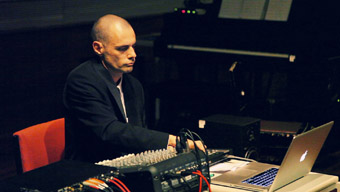
Malcolm Riddoch, Decibel, Still and Moving Lines
photo Gemma Pike
Malcolm Riddoch, Decibel, Still and Moving Lines
PERTH AUDIENCES LIKE TO THINK OF THEMSELVES AS UNBEARABLY ISOLATED, SO WHEN LOCAL ENSEMBLE DECIBEL DECIDED TO PERFORM THE COMPOSITIONS OF ONE OF THE CANONICAL FIGURES OF EXPERIMENTAL MUSIC, ALVIN LUCIER, THEY ATTRACTED A GOOD CROWD. LUCIER WAS A GOOD CHOICE FOR THE FIRST OF DECIBEL’S COMPOSER SERIES IN THIS REMOTE CAPITAL, BECAUSE HIS WORK LENDS ITSELF TO THINKING ABOUT WHERE YOU ARE IN BOTH SPACE AND TIME.
After the lateral philosophies of the late New York school, Lucier deconstructs the usual arrangement of composers, performers, listeners and sounds. It is as if his pieces are more realised than interpreted, demonstrated than performed, as sine wave oscillators collide with clarinets, voices echo into nothingness and a Beatles melody is played through a teapot.
Nothing illustrates Lucier’s special place in the history of the acoustic arts more than the first piece performed here, Shelter (1967). Malcom Riddoch manipulated the difference between sounds that could be heard through the venue’s walls and their amplification inside, picked up by contact microphones placed around the building. As one sound mirrored another, the walls seem to dissolve in the mix. What Lucier has designed here, through the slight phase change between outside and inside, is a way for an audience to become aware of how our ears construct the spaces around us, and Riddoch’s achievement is to orchestrate the resonance of these spaces. Lucier’s pieces realise the simplicity of sound’s presence, beyond the range of the home stereo, bringing to his work a quality as timeless as the idea of the room itself.
So in the classic I am Sitting in a Room (1970), the sound of a recorded voice is played back and recorded again and again, until the recording is muffled by its own resonating, spatial echoes. Here the former West Australian newsreader Peter Holland came out of his ABC studio to bring the piece a particular resonance for its local audience, his familiar voice becoming unfamiliar as it diffracted into space. In these early pieces the room itself is an instrument, while later Lucier works turn to the sine wave oscillator as an instrument, combining it with the clarinet, flute, saxophone and piano to investigate tonal relationships. Decibel’s program was largely made up of these later works, in which the appearance of classical instruments alongside the purity of an electronically generated pitch rendered them grotesque, the human breath a distorted and messy medium with which to investigate the greater goals of Lucier’s spatial sounds.
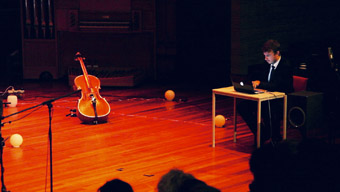
Tristan Parr, Decibel, Still and Moving Lines
photo Gemma Pike
Tristan Parr, Decibel, Still and Moving Lines
In Memoriam Stuart Marshall (1993) sets a clarinet against an oscillator, and demands that the instrument match its pitch. Here clarinet player Lindsay Vickery struggled for some minutes to engage with the precise sound of the oscillator before meeting it with his own. As if in a colossal battle between human and machine, Vickery’s breath came to create a series of sound effects that produced negative images in the oscillations, outlining resonant frequencies that sought out an exact spatial collusion. The performance became nothing short of sensational, as the ear attended to magical shifts of pitch, tone and even rhythm that appeared as pulsing shapes shifting from one side of the room to the other. Vickery’s triumph came at a price, however, as his sweating brow revealed the frailty of the human instrument system of sound production against the cleaner, digital sound source. Lucier’s simplicity, his attendance to singular effects, appeared to edge this archaic instrument into obsolescence.
Lucier’s pieces may be better conceived as scientific experiments or works of conceptual art than as music in a compositional sense. So his commissioned Beatles cover, Nothing is Real (Strawberry Fields Forever; 1990), is here performed on piano by Stuart James and played back through a teapot, its lid lifted and replaced, as per Lucier’s instructions, by Decibel’s director Cat Hope. We are no longer listening to the famous melody, but instead to its duration and spatial presence: in Directions of Sound from the Bridge (1978), James altered an electronic tone played from a cello’s bridge to show how the shape of the instrument changes the way this tone is distributed around the space. Lights placed around the room brightened and dimmed according to the changing pitch and the cello’s sound shadow. Thus Perth was treated to a lesson in acoustic phenomena, an interrogation of the conservatism of the concert format, and an ecstatic experience of sound at its most sparse.
Decibel, Still and Moving Lines: The Music of Alvin Lucier; Western Australian Academy of Performing Arts, Perth, May 13; http://decibel.waapamusic.com
RealTime issue #97 June-July 2010 pg. 43
© Darren Jorgensen; for permission to reproduce apply to realtime@realtimearts.net
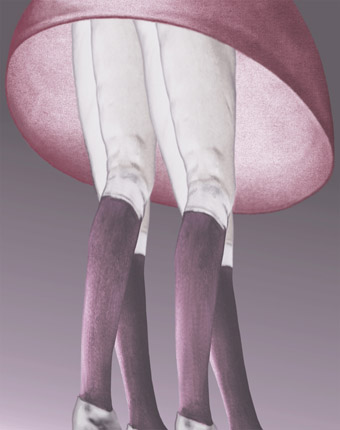
Pat Brassington, Twins, 2001, series Gentle, Fotofreo
courtesy the artist and Stills Gallery
Pat Brassington, Twins, 2001, series Gentle, Fotofreo
PHOTOGRAPHY IS ABLE TO EMBRACE A VARIETY OF GENRES AND PRACTICES. FROM JOURNALISM AND DOCUMENTARY TO THE CONCEPTUAL AND PERFORMING ARTS, FROM THE SENTIMENT OF PRIVATE PHOTOGRAPHS TO THE MASS SPECTACLES OF MEDIA AND MARKETING, IT TRAVERSES VERY DIFFERENT MEANINGS. SHOWING SOME OF THESE MEANINGS HAS BEEN THE MISSION OF THE BIENNIAL FOTOFREO FESTIVAL, FOREGROUNDING BOTH THE DIVERSITY AND UNITY OF THE MEDIUM.
The effect of its many shows in many venues is to confuse the easy categories with which we are used to classifying photographic images, so that the conceptual begins to look like documentary and vice versa. Two black-and-white exhibitions on this year’s program highlight this category confusion. One is from Tasmanian photographer Ricky Maynard and the other shows John Joseph Dwyer’s meticulous images of Kalgoorlie from the beginning of the 20th century.
At first glance, there is nothing much to see in Maynard’s show, touring from the Museum of Contemporary Art in Sydney. Portraits of Tasmanian Aboriginal people sit alongside various landscapes of the region. What brings the show to life is the information that accompanies the photographs. An image of a tree and surrounding bush is called Traitor (2007), and Maynard tells us that it marks the spot where Tasmanian chief Manalargenna made an agreement for his people to stay on the islands of Bass Strait. They were to die there, never to return to their homelands. The photograph now bears the weight of a violent history, and one’s attention is drawn to its meticulous framing and careful exposure, to the grain of the tree and tone of the shadows. In Healing Garden (2005), an image of a fenced-in garden of trees sits on a flat empty plain. Maynard writes that this surreal site is where a massacre took place. The haunting of Tasmania appears to bleed through the image, as Maynard brings his documentary mode of photography to life with conceptual information.
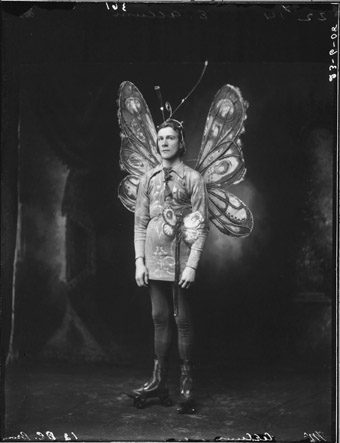
John Joseph Dwyer, Untitled (Mr Allum), 23 June 1908
image courtesy Western Australian Museum
John Joseph Dwyer, Untitled (Mr Allum), 23 June 1908
Different sorts of revelations take place in Dwyer’s images of the mining town of Kalgoorlie during its boom years early in the 20th century. They show some of the quaint customs of its residents, pictured in fancy dress, as well as the architecture of the city and mines that surround it. Dwyer’s work is of retrospective interest not so much for its subjects but for its photographic style. While we are accustomed to thinking of the documentary image as something of an objective record, here the perspective of Dwyer’s images anticipate the American and British periods of social realist photography in the 1920s and 30s. They are framed to give their subjects, whether people, buildings or mines, a sense of grandeur. Time allows us to see Dwyer as an artist rather than as a simple chronicler of his times.
Conceptual photographers are very aware of these kinds of paradoxes, in which the angle of the lens is warped by one’s own historical gaze. We live in an era that is overheated by imagery, in which we tend to look through photographs rather than at them. Narelle Autio brings the invisible to the fore as she packs the walls of the Fremantle Maritime Museum with photographs of flotsam and jetsam recovered from her local, South Australian beach. Collections of crab claws and coral remains are arranged in great optical patterns from floor to ceiling and photographed against a uniform white background. Lonely shoes and gloves clogged by oceanic detritus and sand appear like stains on the purity of this colour. Images of old lighters, fireworks, matches, dolls, underwear, bottles, coconuts, goggles, glasses, knives, starfish, stingrays, birds and seaweed speak of a collector who can’t leave anything out. The obsessive quality of the show contains both an intimacy and a careful objectivity, Autio handling her throwaway materials with care.
In the last FotoFreo in 2008 there was a serious absence of female photographers in the major exhibitions, but this time the gender numbers are near even. Pat Brassington’s moody composite photographs could have been taken straight from a French surrealism magazine. Her renderings of torsos, tongues and limbs in pink, brown and orange exposures have the mark of a suburban imagination gone strange. Legs suspended between floral pillows and blind mermaids sit alongside one another in an assemblage of dreamy softness. Two series of photographs, one from the 1980s and another more contemporary, share a series of motifs. The corners of rooms, blinds and curtains turn conventional spaces and objects into the haunting material of dreams.
It is difficult not to compare 2010’s FotoFreo with its blockbuster precedent in 2008. There are fewer featured shows this time, and fewer international and national names. In 2008 Edward Burtynsky’s commission to take large scale photographs of West Australian mines provoked much local discussion, as did a series of standout international shows by Roger Ballen, Chen Nong, Adam Broomberg and Oliver Chardin. It also gave locals a chance to see interstate photographers Brook Andrew, Marian Drew, Polixeni Papapetrou and Darren Siwes for themselves. FotoFreo plays an important educational function for isolated Perth audiences. The non-appearance of Jeff Wall, rumoured to be among the guests, was disappointing given the high expectations that FotoFreo has set up.
Yet the excitement of FotoFreo lies as much in the festive atmosphere created by shows organised independently around town as it does in the main galleries. During March and April it was near impossible to walk into a Fremantle cafe, restaurant or venue without encountering a series of photographs neatly placed on the wall. The flexibility and honesty of photography makes the festival a friendly one, accessible to practitioners and viewers alike. So it is that FotoFreo brings people’s eyes to a medium that is all around us and is yet rendered invisible by the same saturation, as we take for granted the most encompassing media of our age.
FotoFreo 2010, venues around Fremantle and Perth, March 20-April 18
RealTime issue #97 June-July 2010 pg. 44
© Darren Jorgensen; for permission to reproduce apply to realtime@realtimearts.net
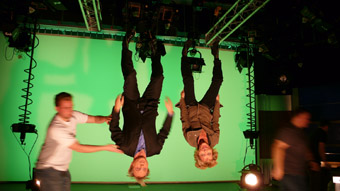
Aspekte (included in Tableau Vivant TV), Christian Jankowski, 17th Biennale of Sydney
courtesy Klosterfelde, Berlin and Lisson Gallery, London
Aspekte (included in Tableau Vivant TV), Christian Jankowski, 17th Biennale of Sydney
DAVID ELLIOT’S TITLE FOR THE 2010 BIENNALE OF SYDNEY, THE BEAUTY OF DISTANCE: SONGS OF SURVIVAL IN A PRECARIOUS AGE, OFFERS MULTIPLE THEMATIC ENTRY AND EXIT POINTS AS DISCUSSED BY JACQUELINE MILLNER IN HER PREVIEW (RT96, P10). FORTUNATELY, THE EVENT RISES TO THE CHALLENGE OF THIS EPIC NOMENCLATURE WITH A MULTIFARIOUS ARRAY OF WORKS FROM 166 ARTISTS SPREAD ACROSS SEVERAL VENUES —THE FANTASTICALLY ATMOSPHERIC COCKATOO ISLAND, PIER 2/3, THE BOTANIC GARDENS, MCA AND EVEN A CLUB SPACE, SUPERDELUXE, INSTALLED IN ARTSPACE.
I sought out the video pieces (which alone are numerous) to explore Elliot’s curatorial vision. Perhaps not surprisingly, many of the time-based pieces work with the idea of song. To some extent, this makes several seem quite similar since they employ the methodology of setting found text or incongruous content to music. Some are more successful than others in pushing beyond mere juxtaposition to resonate more deeply.
Gamu Mambu (Blood Song, 2010) by Christian Thompson (Australia) gives us a Dutch Baroque opera singer performing in Thompson’s heritage language, Bidjara. The subtitling in English allows a glimpse of the culture’s colloquialisms, while the sung Bidjara phrases—complex multi-syllabic words—let us sense the strangeness of these sounds in the mouth of the singer whose European technique prefers vowels to consonants. Thompson’s superimposition of cultures succinctly raises the issues of language and cultural identity, an interesting foil to Susan Hiller’s The Last Silent Movie (2007, USA) in which audio recordings of endangered languages highlight the precariousness of ancient cultures in the 21st century.
A three-screen work created specifically for the biennale by Mieskuoro Huutajat (Shouting Men’s Choir, Finland) takes Kevin Rudd’s 2008 apology to the Indigenous people of Australia as its source material. The screens show headshots of the somewhat unkempt men from the choir alternately speaking and shouting the text. Sometimes a speaker in full shout is stripped of sound. The gently accented phrases, shouted words and silenced cries unite and overlap to create a moving statement on both the power and yet inadequacy of words alone to effect reconciliation.
Perestroika Songspiel by Chto Delat (2008, Russia) offers a performance for video drawn from documentation revealing what local people thought in the early days of Perestroika. Perspectives on the complex issues involved are presented in speeches and dialogues elaborated further by a vocal quintet. The form is clearly performance, yet it occurred to me that such a blatantly agitprop text (lacking even a Brechtian twist) would never actually be performed theatrically—contemporary theatre and performance generally strive for greater complexity in form and content. I had similar thoughts about Lament of the Argentine Military by Tarryn Gill and Pilar Mata Dupont (2010, Australia). The piece is a visually beautiful and well-produced faux-Broadway musical (also accompanied by two large format prints), presenting the atrocities of the Argentinean dictatorship. But does the performative style offer anything more than parody?
In fact a number of the works make me wonder about the relationship of performance to video art. Presented as live performance would these works satisfy conceptually? Why, when a video camera is involved, does the performance language so often seem too simple? Or is the manipulation of a popular form via video into ‘high art’ enough in itself as it allows the works greater accessibility?
Fortunately the creations of Marcus Coates and Christian Jankowski demonstrate that there is scope for much more complexity even while utilising parody. At first glance Marcus Coates is taking the piss in his work A Ritual for Elephant and Castle (2010, UK). Coates calls himself a contemporary shaman. In a silver-grey suit and accompanied by a stuffed buzzard on the end of a stick, he wanders around the London suburb of Elephant and Castle discussing the proposed redevelopment of the area in order to create a performance ritual. What complicates this apparent parody is that Coates seems utterly sincere. He is the perfect ‘change counselor’ as he leads the local development committee through a creative visualisation to assist him in finding material for his coming performance project. Local residents open up to him, offering critical responses to his ideas. Most revealing of all is his meeting with the local property developer, whom Coates gets to help him “find the physical form” of his performance. The developer engages thoroughly in the activity, drawing on the ‘energy principle of Tai Chi’ to explain the “movement with intention” that he feels the area needs. Through his bizarre posturings, Coates actually gets the community to seriously engage in discussion about the issues of change and progress.
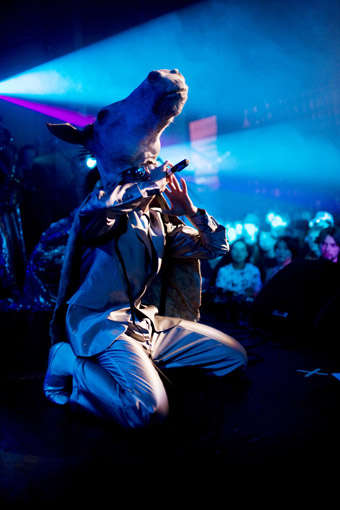
Vision Quest with Chrome Hoof, A Ritual for Elephant and Castle, 2010, Marcus Coates
photo Nick David, produced by NOMAD, courtesy the artist, Kate MacGarry, London and Workplace Gallery Gateshead;
Vision Quest with Chrome Hoof, A Ritual for Elephant and Castle, 2010, Marcus Coates
These encounters are shown on three monitors while the final ritual is projected large—a kind of post-punk-glam rock extravaganza, in which Coates appears, still in silver suit but with a stuffed horse head atop his own, and accompanied by a silver lycra-ed band, Chrome Hoof. Perhaps here I doubt the sincerity—maybe he is in reality a postmodern parodic performer—and I wonder if any of the people he has consulted actually attended this event. Perhaps most interesting is the final meeting with the council where he talks them through the visions he saw during his performance, including swallows nesting in his armpits—he interprets this as a development approach involving small scale sustainable projects. It’s a message which the council hears without the trace of a smirk, and might just heed. A Ritual for Elephant and Castle works as a community-cum-live art project, as documentary and video art.
Similarly, Christian Jankowski’s work could be misunderstood as mere prank, or too self-reflective, yet as it develops the conceptual material complicates and deepens. Jankowski has been actively utilising broadcast television as his subject and medium for some time now (including convincing German TV hosts to present an entire show while hanging upside down). For this biennale he has made Tableau Vivant TV (2010, Germany) in collaboration with Andrew Frost from The Art Life and the College of Fine Art. Utilising the ABC TV’s Art Nation program along with other local and international broadcasters (or so it seems), Jankowski frames his piece as a documentary on the making of his biennale commission. However Jankowski himself never speaks, rather he is a static figure in the background, often with other frozen ‘characters’ at moments in the taping: in the bathtub at the moment of inspiration; a party on a Sydney balcony where Frost and Jankowski first meet; a meal in a swanky restaurant in which Jankowski tries to sell his idea to Biennale director David Elliot; a moment of creative self-reflection and doubt on Bondi Beach. His thoughts are voiced by a variety of television journalists in Germany, England and Australia, including ‘celebrity’ journalists such as Anne Fulwood and Angela Bishop. As the ideas behind the making of the work unfold, Jankowski deftly unpacks a range of complex issues about the relationship of television to video art, art to television, celebrity, the nature of biennales, curatorship and the creative process. While occasionally labouring the point (Kylie Kwong’s valiant effort to elaborate on the relationship between cooking and video editing begins to show the strain), Tableau Vivant TV is smart artmaking in which form and content are inextricably linked and which is both challenging and entertaining.
Beyond these explorations of performance, David Elliot has curated works from some of the blockbuster names of video art. Isaac Julien’s Ten Thousand Waves (2010, UK) is a stunning installation across nine screens. Based on the tragedy of drowned cockle harvesters in Moorecomb Bay, UK in 2004, Julien has collaborated with renowned Chinese artists such as poet Wang Ping, calligrapher Gong Fagen and actress Maggie Cheung to create a multi-faceted reflection on homeland and migration—part documentary, part fantasy, part memorial. Forget 3D, Julien’s stunning imagery, intelligently presented in split narratives across the multiscreens, is a far more immersive, and rewarding cinematic experience.
Interestingly, Julien also collaborated with artist Yang Fudong, who presents his own work in this biennale, East of Que Village (2007, China)—a bleak exploration of life in northern China. Fudong projects black and white images across six screens, his quiet, non-invasive style juxtaposing scenes of a pack of dogs who are literally dying of starvation in front of the camera (even feeding off other dogs) with quotidian human activities in an inhospitable landscape. As westerners it’s easy for our sympathies to go to the dogs, yet the lives of the people here are perilously close to the same level of hardship. East of Que Village is a confronting and conflicting experience.
Similarly, Steve McQueen’s Gravesend looks at the hardship of miners in the Congo, who scratch from the earth by hand an unspecified but valuable commodity. I find McQueen’s work to be essentially visual-audio: the potency of each image drawn out by the heightening of diegetic sound, such as the amazing timbres of splintering rock or compressed air machines. Structured by poetic association—the glow of the molten substance in a crucible is paralleled by the orb of the sun setting behind the factory; the labour of the men is contrasted with the clinical atmosphere of the roboticised factory—McQueen’s work is evocative without being definitive.
Of the many video works in the 17th Biennale of Sydney I found myself drawn to the ones discussed here not only because of a personal preoccupation with performance and video, on the one hand, and the interplay of audio and the visual on the other, but because all of these works exemplified David Elliot’s thematic provocation. While this tight curatorial vision sometimes runs the risk of inflicting homogeneity, it also offers boldness—a willingness to say something, at a time when it is all too easy to stifle conscience and be satisfied with distractions.
17th Biennale of Sydney, The Beauty of Distance: Songs of Survival in a Precarious Age, curator David Elliot; Cockatoo Island, MCA, Wharf 2/3, AGNSW Forecourt, Sydney Opera House, The Botanic Gardens, Artspace; May 12-Aug 1
RealTime issue #97 June-July 2010 pg. 46
© Gail Priest; for permission to reproduce apply to realtime@realtimearts.net
WE ALL KNOW THAT CINEMA, LIKE MOST THINGS IN CHINA, IS EXPANDING RAPIDLY AND THAT THIS EXPANSION IS NOT AN EASY THING. FILM IS AN ARENA IN WHICH GOVERNMENT REGULATION, MARKET ECONOMICS AND CREATIVE EXPRESSION FREQUENTLY COME INTO VOLATILE CONTACT.
A broad division has recently emerged between the medieval epics beloved of commercial filmmaking (think Zhang Yimou’s films) and low budget, socially oppositional films (like Jia Zhangke films). While the latter form has been vitally important, lately it has seemed to congeal into a formula in which sleazy, chain-smoking slackers in dingy urban backwaters encapsulate filmmakers’ critique of the spiritual void of the market economy. This year’s Hong Kong Film Festival provided rich material for a contemplation of the ways in which Chinese cinema is struggling to refresh this critique.
sun spots
Sun Spots by Yang Heng is another of the long take, distant framing tableau films which follow in the footsteps of Hou Hsaio-hsien and Jia Zhangke (Jia’s cinematographer Yu Likwai is listed as associate producer). The intriguing thing about the film is its wilful incommunicativeness. It doesn’t tell a story so much as establish figures expressive of their surroundings. In the opening shot, a man lies on the road after a motorcycle accident in front of a bulldozer: a stricken figure in a stricken landscape. Another tableau indicates that the chain-smoking in these films simply reflects the surroundings where chimneys constantly spew out smoke.
Not only are scenes mostly wordless, but the characters are often framed with their backs to the camera. At key moments, such as the final shot, they simply disappear into the depths of the frame. These tactics are not new; in fact you associate them with Mizoguchi in the 1930s. In those films they were employed as distancing devices that functioned to push you back out of the melodrama, but here they are part of a larger indifference or refusal. Just as the characters drift along in a world lacking purpose, this film offers us nothing more than two hours of repeated action which points to no deep interior psychologies on the part of the characters. The point is that there’s no point—that’s all there is. In America this might turn into Easy Rider, but here it just wallows in its own sense of social torpor.
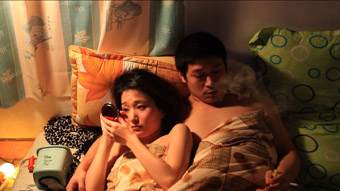
The High Life
the high life
Sun Spots and Zhao Dayong’s The High Life shared the main prizes at the HK festival. The High Life similarly starts out from the standard Jia Zhangke story. The familiar cast of characters is present: the small-time lowlife, the slutty girlfriend, the neighbourhood boss. However, the opening scene gives us an indication that things might not be so simple: a group of women in a prison work at sweatshop labour while one of them recites an increasingly bizarre and incendiary poem.
It’s another hour before we return to this location and these characters but the scene is emblematic of the film’s strategies. Characters enter and then leave the narrative, frustrating our attempt to approach contemporary China in exclusively personal terms. It is worth comparing this to the structure of Zhao’s previous documentary Ghost Town (see Dan Edwards’ account, RT94, p22) which is divided into three parts, each focusing on a different character.
There is also an insistence in the opening scene that despite the culturally debased conditions of everyday life in China, art is the repressed which somehow finds a way to return. The small-time swindler retreats to his rooftop each evening to practice opera performance styles and the superintendent of a prison insists that prisoners recite his subversive poetry.
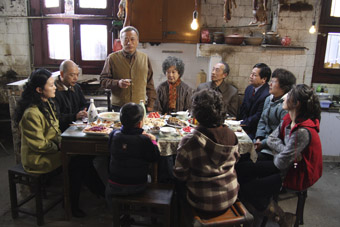
Apart Together
apart together
The most impressive fiction film from China (see the articles on page 16 and RT96, p15 on the documentaries which are rapidly emerging as a key component of Chinese cinema) was Wang Quanan’s Apart Together which derives from the unfashionable humanist middle-ground of Chinese cinema. It is not a star-driven genre film, and neither is it the kind of grungy miserabilist film beloved of international festivals.
Set against the backdrop of the tentative reconciliation of Taiwan and the People’s Republic of China, this is the story of a Kuomintang soldier who returns to Shanghai, to the sweetheart he abandoned 60 years ago, now living with her new husband and family. Thankfully what follows can’t be reduced to allegory. Instead we see how personal stories carry the weight of a wider politics. It is a funny, deeply observant and beautifully acted study of how history has made strangers of people who need to rediscover their cultural commonalities.
Chinese people talk to each other through and over food, and so the film concentrates mainly on a number of set pieces around dinner tables. Alcohol, popular song and sentimentality are the pillars on which the drama is elaborated in simply observed, long takes which allow for some ferociously good ensemble performances. History is a large and complicated business. Life is uncertain but so long as there is food on the table and people around it, that is all you can ask for, and that is enough.
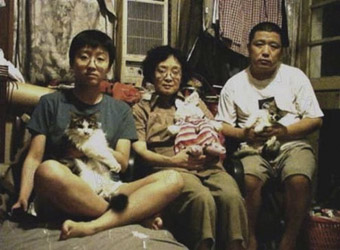
Liu Jiayin, Oxhide 2
oxhide 2
Food is never far from the foreground of Chinese films and Liu Jiayin’s Oxhide 2 (Sandy Cameron wrote an appreciation of the first in 2005; RT67, p22) centres on the making and consumption of a meal of dumplings. This is a reworking of the earlier film to see if its restrictions can be pushed even further. Oxhide contained 23 shots but this time Liu Jiayin gets it down to nine with each shot averaging 15 minutes. These are all taken in a single room of a cramped apartment with a static, locked-off camera—Liu appears in front of the camera while shooting it. The use of a widescreen aspect ratio extends the restrictiveness of the formal strategies by excluding characters’ heads for long chunks of time.
In some ways this is the ultimate work of everyday realism—until you realise that the action is carefully composed and staged. As with her previous film, Liu’s performers are her parents and herself, and the film shows them talking, squabbling and cooking together in real time and in their own home. As with any good work of minimalism, you pare down the elements so that small things assume larger impact. When the mother appears in the deep background of the first shot, it is quite thrilling to see that a door is suddenly revealed. When the father’s head lurches unexpectedly into the foreground of the frame, I recoiled more strongly than at any point in Mr Cameron’s turgid 3D nonsense.
one night in the supermarket
Finally, what’s the news from China’s commercial cinema? Yang Qing’s One Night in the Supermarket is an attempt to find, and cash in on, viable contemporary genres. Screwball comedy has worked well for South Korea—this reworks Attack the Gas Station—and it’s a big improvement over the medieval hack and slash epics which have carved an increasingly leaden path through Chinese cinema.
The model for imitation here is Ning Hao’s Crazy Racer from last year. We have bumbling crooks, larger than life characterisations in which eyeballs are constantly bugging out of heads, flashy transitions and intrusive camera and editing effects. One of the lead actors is even imported from Crazy Racer to get the narrative moving. A couple of disgruntled guys hold up an all-night convenience store and, predictably, things go wrong and draw in an increasing number of eccentric locals. This is painless enough but it’s nowhere near as funny as it ought to be. The performers’ heavy handed mugging will give you even greater appreciation for Ning Hao’s style of comedy.
Why care about it? As our media pound us with the one-dimensional picture of China as a grey, totalitarian place, it seems more important to get an insight into what makes the Chinese laugh. Creating comedy appears to be a more urgent task than adding yet another critique of an aimless and souless modern China.
RealTime issue #97 June-July 2010 pg. 15
© Mike Walsh; for permission to reproduce apply to realtime@realtimearts.net
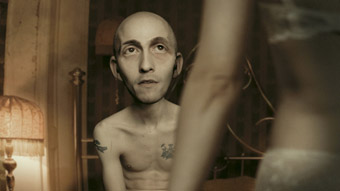
Metropia
JACK SARGEANT IS THE AUTHOR OF A NUMBER OF KEY BOOKS ON ‘OTHER’ CINEMAS. THERE’S DEATHTRIPPING: THE EXTREME UNDERGROUND AND THE SEMINAL BEAT WORK NAKED LENS: BEAT CINEMA, BOTH OF WHICH HAVE BEEN REPRINTED THREE TIMES IN ENGLISH, WHILE NAKED LENS HAS BEEN TRANSLATED INTO RUSSIAN AND JAPANESE. SARGEANT HAS ALSO EDITED BOOKS ON ROAD MOVIES AND PUNK ON FILM, AND WRITTEN ESSAYS ON ANDY WARHOL, DRUGS ON FILM, THE TRANSGRESSIVE PERFORMANCE ART GROUP COUM TRANSMISSIONS ON FILM, 9/11 DOCUMENTARIES AND MUCH MORE.
I first met Sargeant in 2000 when he brought the Beat film retrospective to the Brisbane International Film Festival (BIFF), one of the festival’s many incredible programs over the last decade. He met Richard Sowada, who “was instrumental in bringing me to Australia.” Sowada, now Head of Film programs at the Australian Centre for the Moving Image (ACMI), had been the founder of the REV fest, now the Revelation Film Festival, one of Australia’s most important screen cultural events. Sargeant spoke to me about life in his third year at the festival.
A festival programmer today has to juggle a lot of different things—what’s the most interesting thing about working on REV for you?
It’s interesting, because it has to embrace different, simultaneous discourses. There’s the ‘underground’ thing, but that is more of a minority interest. You also have to make sure people come and you screen larger films. I’ve always got to be programming for that combination. For example, this year we’re showing Mike Kuchar’s film, Sins of the Fleshapoids, a work which will be unknown to many people, and is pure 60s underground cinema. On the other hand we’re showing a documentary about The Doors called When You’re Strange. It’s different because it doesn’t have Ray Manzarek talking on about the past. Instead it’s got hitherto unseen footage and music all the way through. That’s a lot more of an accessible film, a more recognisable festival title, and I imagine other festivals will pick it up too. For me all kinds of films are important in the mix.
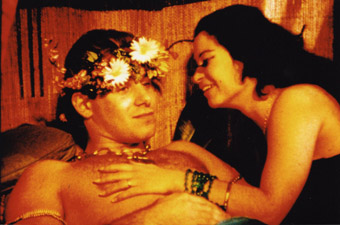
Sins of the Fleshapoids
Because REV was started without much money and with passion rather than commercialism or other agendas at its heart, it’s always had its own identity. I realise it’s a very privileged position in which I am working. It’s a great film festival: it has a high degree of mutability. We’re not really mainstream, not really indie, not really underground, but we enter all of these areas. The festival is a form of hybrid work. It’s an advantageous position to be in. We have a great audience who come and enjoy the festival, people who are open to film and every year there are new people coming, which is great. It has a presence in Perth as part of the culture there.
Tell me about your work on the Magickal Songs, Mythical Histories and Fictitious Truths program for the 2010 Biennale of Sydney?
I found out there was a meta-thematic running through the Biennale based on Harry Smith, who I’ve written about. Fairly early on I discussed a list of films that would go hand in hand with these themes drawn from Harry’s work, which, if you are familiar with it, offers a perfect starting-point for so many different cultural possibilities. It’s been a great experience, to devise a screenings program around Smith and exciting to extend it to include experimental performers such as Lawrence English and Noko, as well as films like the Ira Cohen documentary Kings With Straw Mats, the doco In The Realms of the Unreal about Henry Darger and Craig Baldwin’s Mock Up On Mu. And there’s the Nick Zedd film, War is Menstrual Envy—I’m pretty sure it’s never been screened in Australia before. It’s a psychedelic punk avant-garde film, pure mayhem and a beautiful piece of art cinema. I just thought it’s about time that film got seen and framed in a different context.
When I first met you at BIFF, film festivals were seriously carnivalesque affairs where a lot of fun and discussion was had, inside and outside the cinema. How have festivals changed? What’s the role of fun in all this?
A festival exists to show film and get people to think and share their experiences about cinema. As soon as people move away from that, I think there are problems. When I write about films or program them I try to frame them the way I see them. I don’t think film should be framed the way the marketing people of a film company want us to see them or the way certain theorists or historians have framed them. Of course, I don’t necessarily want people to agree with me. I want them to know why I think a film is interesting and go from there. It’s important as a curator to put one’s imprint on things. That said, I argue with the people involved in REV. It’s not like they all bow to my taste. Obviously people have different tastes. Part of the process of curating is negotiating, defending, justifying decisions, sometimes even with myself. If I am passionate I will argue down to the last minute about why I think that a film is good. It’s not that other people’s opinions aren’t valid. It’s that, I think, as a curator or as a writer on culture, that’s what you have to do, you have to stand up for things you like.
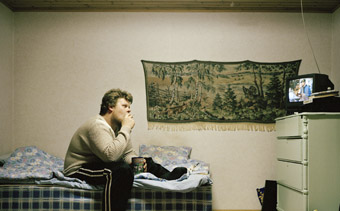
The Living Room of the Nation
It seems one of the things you stand up for is diversity—your programming has always tended to combine lots of different genres and approaches. Why’s that important?
I think it’s important to have a range of genres and styles and themes going on, it’s important to get that scope, not just be doing the same thing, or variations of the same thing. The ideal is to have diversity, not predictability. To be moving in all directions at once. What was the term Trans Media Exploration used? Quaquaversal. Trans Media were a 60s commune and art group; Genesis P-Orridge, later of Throbbing Gristle and Psychic TV was involved with them for a while. I like the idea of embracing the ‘quaquaversal.’ Or ideas like becoming. Those concepts of how to be fluid and flexible and move through an infinite number of possibilities.
Is that close to a philosophy of programming?
Philosophy is a bit of a problem for me, because if you seriously have a philosophy then I believe that you’ve got to destroy it. As soon as you have just one way of doing something you become conservative. And you have to avoid conservatism, and avoid your own conservative tendencies that allow you to fall back on the familiar or the safe. I think people become too cynical. It’s important to retain that freshness, that excitement and interest about things, to keep coming to them anew.
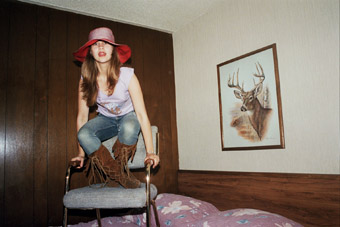
Joanna Newsom, The Family Jams
When was the last time you found something interesting that you never thought you’d be into before?
All the time. Because I’m always looking to find new things, new areas of interest. I’m always looking for new kicks, you know? I get bored easily and always want to find new stuff to amuse myself. I’m always finding things I like because I’m always looking for things.
I think one needs to approach one’s work with a kind of fury. By which I mean an intensity. It’s important to avoid being lazy and not engaging. It’s also essential to realise that just because you can see one minute of something on YouTube doesn’t mean you’ve seen it, there’s so much more out there.
I’m really interested in the things that are excluded, for example recently when people were talking about Australian cinema, I was interested in what was left out of the definition. As soon as I know there’s something they’re not telling me, I always want to know what it is. (See Sargeant’s “Australian Film: A Wider Screen,” RT95)
I think it’s important to remember that culture is like an iceberg: the little bit that peeks above the surface is what everyone’s talking about. But what’s interesting is what’s under the surface. Interestingly, on some icebergs there’s even more under the surface than usual; sailors call these icebergs growlers. To me that is the perfect metaphor; there’s this huge thing growling underneath and this is what I want to know about. Most people just stick with what’s above the surface. But knowing what’s out there, wondering about it all the time, makes me want to look deeper.
* * *
advance notice
Jack Sargeant tells us that his 2010 Revelation Film Festival will include Mike Kuchar’s Sins of the Fleshapoids; a Philip K Dick-style science fiction animated feature, Metropia; an Irish post-apocalyptic melodrama, One Hundred Mornings; a Russ Meyer double bill; a WA feature, The Sculptor; the hip LA coming of age film, We Are The Mods; The Family Jams, a documentary about alt.folk, Joanna Newsom et al; Living Room of the Nation, a poetic visit to six Finnish living rooms; Double Take, the much acclaimed and witty experimental examination of Alfred Hitchcock and Cold War Politics by Belgian artist Johan Grimonprez; and the documentary Reporter, about a committed US newsman in the Congo.
Revelation Film Festival, Perth, July 8-18; www.revelationfilmfest.org
RealTime issue #97 June-July 2010 pg. 21
© Danni Zuvela; for permission to reproduce apply to realtime@realtimearts.net
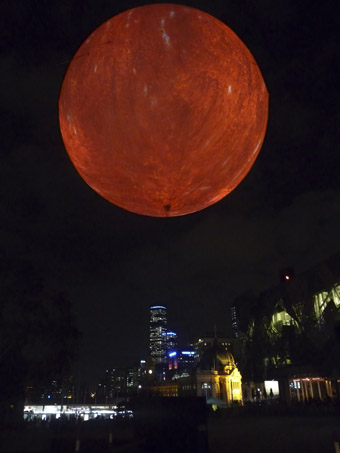
Solar Equation by Rafael Lozano-Hemmer for The Light in Winter, Federation Square
courtesy Federation Square
Solar Equation by Rafael Lozano-Hemmer for The Light in Winter, Federation Square
As we pass from Spring to Winter and the Winter Solstice approaches this is an edition inflected with change. The photograph on this page is of Rafael Lozano-Hemmer’s giant creation for Melbourne’s The Light in Winter festival, Solar Equation, a work which will hover over Federation Square for a month. The artist describes it as “a piece for the sky”, mathematically monitoring changes on the surface of the sun. You can interact with its equations (see interview). Other changes are marked by the final showing of the National Review of Live Art in Glasgow and our review of James Waites’ Whatever Happened to the STC Actors’ Company?. Pierrot Bidon, the founder of Archaos has died and we celebrate his re-making of circus. Elsewhere we congratulate Lawrence English for 10 years of ROOM40, report on changes in dance touring strategies and music commissioning tactics. Chirstinn Whyte notes radical shifts in dancefilm thinking at Moves 10 in Liverpool, Mike Walsh at the Hong Kong Film Festival sees Chinese feature films searching for new formulae and Jana Perkovic wonders if Live Art will take in Australia. Is more change on the way? Our annual arts and education edition and report from the Next Wave Festival in RealTime 98 will have something to say about that.
RealTime issue #97 June-July 2010 pg. 1
© Keith Gallasch; for permission to reproduce apply to realtime@realtimearts.net
{$slideshow} Here we offer a mini-gallery of performance strategies for dealing with that unruly entity—the audience. Takers for Rotazaza’s Wondermart look afresh at everyday places (see review). In IRAA’s The Persistence of Dreams: The Sandman, an audience of one invites a group of friends to join them at their home to be bound and blindfolded as Roberta Bosetti recounts a dark bedtime story (see review), while Hole in the Wall participants are moved about in four rooms on wheels (see review). In Oil Can, at Sydney’s 4A Centre for Contemporary Asian Art, passersby are invited to climb into one of 15 oil cans to stand motionless alongside the artist Tatsumi Orimoto, for 30 seconds, which they obligingly do. Read about Oil Can here.
RealTime issue #97 June-July 2010 pg. 2-3
© RealTime ; for permission to reproduce apply to realtime@realtimearts.net
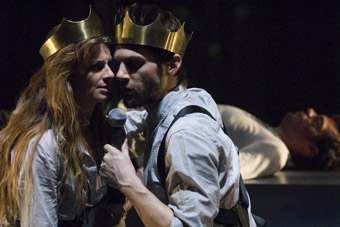
Amber McMahon, Cameron Goodall, Brett Stiller, Vs Macbeth, STC & The Border Project
photo David Wilson
Amber McMahon, Cameron Goodall, Brett Stiller, Vs Macbeth, STC & The Border Project
THIS YEAR’S ADELAIDE FESTIVAL WAS AWASH WITH DIALECTICAL ENTANGLEMENTS: CULTURES MELDING, DISCIPLINES MERGING, TEXTS COLLUDING. THE ARTIST TAKES THE GIVEN AND MAKES IT NEW OR, IN SOME CASES, NEWISH.
vs macbeth
In Vs Macbeth, the given is William Shakespeare. And the new is danger. The Sydney Theatre Company’s Residents and Adelaide’s own Border Project teamed up for this new work that sought to reimagine Macbeth through the accidents that have made it the superstition-laden “Scottish play” that it is. The conceit is honourable. After all, the dangers of theatre can be very real. Performing it and witnessing it can be like walking along a cliff top backwards. Yet, this production never raises a solitary hair.
The problem is not in conception, but in realisation. From the outset, there is an undeniable whiff of Occupational Health and Safety, from the high visibility jackets to the yellow hazard tape. Yes, they mark the space as perilous, but they are also measures designed to dampen the unexpected and to ward off danger. If anything, they mark this theatre as eminently safe and flag in fluorescent clarity the fact that we should be prepared for things to go safely awry. When paintball guns are brought out for every death scene, so too is a cumbersome protective curtain of cyclone fencing meant only to protect the front row from pink shrapnel. Suspense? No, thanks.
The lack of tension in the space is only compounded by the bathos exerted by a series of interruptions—a missed entrance, a hurt hand. The sporadic nature of the interruptions suggests an unwillingness to commit wholly to the conceit, though it must be said that some of the actors commit themselves to the text beautifully. Indeed, it is the half-heartedness of the reimagining which is most problematic. The central melody here is still Shakespeare’s voice but the counterpoint is little more than an embarrassed suggestion of revolt, leaving even the erstwhile iconoclasts in the audience yearning for tights and doublets (the lycra-hungry had to head to Back to Back’s Food Court for their fix (RT 92, p42).
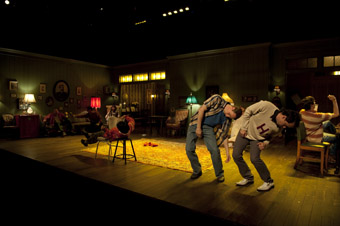
The Sound and the Fury, Elevator Repair Service
photo Matt Nettheim
The Sound and the Fury, Elevator Repair Service
the sound and the fury
Fittingly, there wasn’t an inch of spandex to be seen at Elevator Repair Service’s staging of April Seventh, 1928, the first part of William Faulkner’s novel The Sound and The Fury. The company is familiar to these shores. Last year’s six-hour Gatz [RT91, p43], saw them transpose the entirety of The Great Gatsby to the stage. In that work, the dialectical frisson between the forms of prose and theatre was a little elusive—the vastness of Fitzgerald’s text was inflected by the joy of reading it rather than the thrall of deconstructing it.
In The Sound and The Fury, a newer work, there is a sense that director John Collins and his ensemble are developing their modus operandi. Again the text is read from the novel but this time not its entirety. Again the text swirls about in a non-literal mise en scène but seeks now to represent the world of the novel rather than an anonymous backdrop. And again the narrative voice propels the text forward along with dialogue but this time it is complemented by projected surtitles that swing our attention in a different way to the written quality of the language. These changes, along with the more stylistically demanding source, serve to make this a far more complex and concentrated production than the sprawling, durational transparency of Gatz.
Remarkably, despite its complexity, the sense of theatrical storytelling and its grounding in prose is rarely lost. The disorienting carousel of actors and characters manifests the chronological jumps of Faulkner’s prose but also produces a fractured perspective, a kaleidoscopic confusion of glimpses into the Compson household that are as rowdy and shabby as the characters themselves. Amongst this kinetic frenzy of staging and the odd Woosterish dance interlude, Collins has wisely left room for moments of transcendent stasis, when the text, projected, is allowed to speak for itself. Yet these moments work not only because of the strength of Faulkner’s writing but also because of the strength of the theatrical text around it—Hegelian synthesis at its finest.
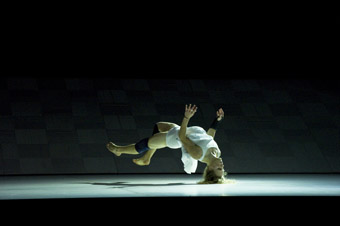
Be Your Self, ADT
photo Chris Herzfeld
Be Your Self, ADT
be your self
Across town at Her Majesty’s, Australian Dance Theatre was premiering its latest work, Be Your Self, an investigation of the body-mind compact inspired by the work of 18th-century Scottish philosopher David Hume. As director Garry Stewart notes in the program, Hume’s A Treatise on Human Nature suggests that humans are “nothing but a bundle or collection of different perceptions, which succeed each other with an inconceivable rapidity, and are in a perpetual flux and movement.” This quotation is almost a pithy précis for the show itself.
It begins with a clinically white and vast stage. As a dancer slowly and meticulously begins to ripple movement up from the floor, through the feet and into the legs, another performer speaks an impressively detailed, thorough and ceaseless description of the neurobiological processes involved in what the dancer is doing. It is an inspired overture that deftly introduces the two disciplines that inform this work: science and dance. The former is taxonomical and exhaustive, the latter expressive and essential. If we were to think of them linguistically, science is the langue and dance the parole.
Unfortunately, the promise of the beginning is not maintained throughout. The piece itself sets out to be somehow analogous to the erratic nature of our human thoughts and physicality, but it feels instead like a physical illustration of the text we heard at the beginning without further development or consideration. The rhythms are punchy, the soundtrack is banging, the lights are in full wizardry mode but the result is a continuation of the clinically detached aesthetic of the start, without any of the discoveries that merit the scientific method, making for a surprisingly joyless experience.
Nevertheless, there is consolation to be had in the uber-athletic performances of the ensemble. The ADT dancers are surely some of the most muscular in the world and their broad shoulders and tendency towards explosive piston-like movement is displayed here to great effect. The set by New York architects Diller, Scofidio + Renfro is largely circumstantial until the very end, when a wide ramp set at 45 degrees is rolled to the front of the stage. As carefully designed animations are projected onto the surface of the ramp, isolated sections of bodies emerge through its weave, swimming in a protean liquid of colours and swirls. It is an assured finish and a striking image, but it is simply the final element in a “collection of different perceptions” that, combined, paint a very cold, distant and unwelcoming sense of what it is to be human.
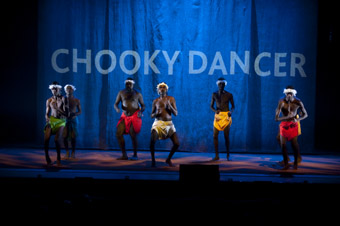
Ngurrumilmarrmeriyu (Wrong Skin), Chooky Dancers
photo Matt Nettheim
Ngurrumilmarrmeriyu (Wrong Skin), Chooky Dancers
ngurrumilmarrmiriyu (wrong skin)
A much warmer, though hardly uncomplicated vision of humanity was to be had at Her Majesty’s a fortnight later with the premiere of Ngurrumilmarrmiriyu (Wrong Skin), which teamed Elcho Islands’ Chooky Dancers with director Nigel Jamieson.
The Chooky Dancers, like Justin Bieber, Susan Boyle and the Back Dorm Boys, came to fame on YouTube. In a dark gym hall they danced to a remix of Zorba the Greek in a unique hybrid of dance vocabularies—part Yolngu, part hip hop, part disco, part Busby Berkeley. The cultural provenance of their performance is breathtakingly complicated, but unadulterated joy and immediacy are the key to its appeal. Existing in a geographically isolated community that, thanks to modern telecommunications, can consume an entire world of creative influences, the Chooky Dancers made manifest postmodern intertextuality not as an ironic exercise in form but as a fundamental expression of self.
Jamieson’s attempt to build on the Chookies’ self-expression and foster it into a piece of theatrical storytelling is an unenviably difficult but worthy undertaking. The director chooses to use the complex Yolngu moiety laws as the basis for a forbidden-love story, with overt references to West Side Story along the way. This gives him a straightforward narrative hook on which to hang various dance sequences and video montages of life on Elcho Island, but it also imposes a stifling rhythm on proceedings and creates a strange tension: are the performers co-creators or merely the subjects of the work? Occasionally, it even reveals the technical shortcomings of the dancers when they are required to step out of their own style. At other times though, the show is a brilliant populist work that sheds light on an oft-overlooked part of our country, and the charisma and pleasure of the performers is disarming and contagious. Indeed, whether it be the Zorba or a riff on a Bollywood dance scene, the most engaging moments are those in which the mechanics of the theatre step out of the way and allow the Chookies to simply do their thing.
–
2010 Adelaide Festival: Sydney Theatre Company & The Border Project, Vs Macbeth, writer William Shakespeare, director Sam Haren, designers Sam Haren, Matthew Kneale, costumes Mel Page, lighting Govin Ruben, composer David Heinrich, video Richard Back; Odeon Theatre, Feb 26-March 6; Elevator Repair Service, The Sound and The Fury (April Seventh, 1928), text William Faulkner, director John Collins, design David Zinn, lighting Mark Barton, sound Matt Tierney, costumes Colleen Werthmann, projections Eva von Schweinitz; Dunstan Playhouse, March 11-14; Australian Dance Theatre, Be Your Self, concept, direction, text Garry Stewart, choreography Garry Stewart and ADT, design Diller, Scofidio + Renfro (DS+R) Architects, lighting Damien Cooper, sound Brendan Woithe (colony nofi), video Brenton Kempster (ZuluMu Design + Post), costumes Gaelle Mellis; Her Majesty’s Theatre, Feb 20-28; Ngurrumilmarrmiriyu (Wrong Skin), writer-director-designer Nigel Jamieson, associate director, movement Gavin Robins, film & video design Scott Anderson, video producer Mic Gruchy, lighting Trudy Dalgleish, composers & sound designers Basil Hogios, David Page, performers The Chooky Dancers; Her Majesty’s Theatre, Adelaide, March 11-14
See RT 96 for reviews of Ligeti’s Le Grande Macabre and the London Sinfonietta at the Adelaide Festival
RealTime issue #97 June-July 2010 pg. 4-5
© Carl Nilsson-Polias; for permission to reproduce apply to realtime@realtimearts.net

Xiao Hei, SXSW 2010
courtesy the artist
Xiao Hei, SXSW 2010
SOUTH BY SOUTH WEST IS A WINDOW INTO WHAT’S HAPPENING NEXT, ACCORDING TO THE WHISPERS OF THE SOCIAL MEDIA HYPE MACHINE. HOPING TO GET A LOOK THROUGH THAT WINDOW, I FOLLOW THE WHISPERS TO AUSTIN, TEXAS.
First, some terminology. South By Southwest is more usually written SXSW and pronounced ‘South By.’ It’s a 23-year-old umbrella event encompassing several specialist media sub-events. It attracts, they say, 25,000 people every year. It has an enormous program, comprising exhibitions, film screenings, panels, yet-to-be-classified online happenings and a huge number of showcase concerts.
In some art forms—music, film and interactive media—the event has a serious global profile. I’m here for the latter. SXSW has become the favoured venue for turning your latest networked interaction venture into an instant fad using the power of champagne and a well-spruiked launch. It’s where you go to meet up with Big Names, to make it clear that this season’s innovations include you. It’s here the myopic vision of the American public just might snap into focus on your new idea. If you work in locative and networked worlds you might, like me, recall it as the place where Twitter debuted; where geosocial networks hold treasure hunts; a hotbed of geocaching where augmented reality-layers quilt the city. A place where cyberpunk technoaesthetic fantasies precipitate from the hyperbole-supersaturated air. An embassy of the American future towering in the present.
In Australia, where we have our own special kind of myopia, it isn’t on the map. SXSW may tower in the US, but it is invisible over the Pacific horizon. Sheer geographical accident plants me in the path of the wagon train to Texas in the lead-up to the festival. I don’t resist, head spinning with half-remembered buzz and rumour, and futuristic hype. I fire up the browser and see what’s scheduled. There are endorsements from the Cocteau Twins, Village Studios and a half-dozen Silicon Valley startups on the festival’s web-page, dammit! What could go wrong?
The first SXSW project to engage me can be found without joining the throng in Austin. London-based Reality Jockey (RJDJ) have packaged up a custom mobile app for the occasion called Hijack SXSW using your phone’s microphone input to create indecipherable algorithmic remixes of the audio content of your environment. An accompanying website helps attendees share generative remixes of the sounds of festival events. The soundscape algorithm is painstakingly produced, harmoniously incorporating every conceivable input from motion sensor to GPS. It’s beautiful, mysterious and no doubt transgresses intellectual property rights; in short, it has everything to make it a viral hit at the kind of festival that I wish I were at. It’s a promising start—and incidentally, just the latest in a long line of interactive pieces from the mobile interactive music startup, which freely distributes tools to assist reactive music composers.
Unfortunately, while RJDJ makes SXSW look good from afar, the experience of actually walking through the door is less alluring. The dizzying hype of SXSW is matched by the vertiginous expense of entry: at US$1350 for a full ticket it’s closer to the price of a high-level professional conference than an arts event. It’s either a sign of arrogance or a promise of excellence to charge as much as the Sri Lankan per-capita GDP for a week-long event. It’s also a pretty steep rate for Americans in the midst of severe recession. Coming overland to Austin, my train rolls across a landscape of alienation and poverty. Trailer parks, bail-bond loan offices and abandoned strip malls, sun-baked and silent desert prisons, public toilet queues clogged with doped-out drug users. I’m no expert in the political economy of the USA but I cannot help see the abysmal income divide here.
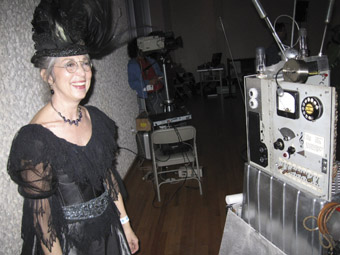
A steam punk fairy godmother at Plutopia
photo Dan MacKinlay
A steam punk fairy godmother at Plutopia
My first few physical encounters with the festival are unexciting: performances that claim to be ‘innovative’ because they play music with synthesisers as well as guitars; a ‘game art’ exhibition that is nothing but framed concept sketches for a manga-themed shoot ‘em up; and fliers telling you to sell your music in Guitar Hero. Soon enough, I gravitate to the fringes, where the interesting things are hiding—like Plutopia, a one-night anarchic, psychedelic counterculture celebration. The whole thing is cloistered away from the Convention Centre crowd at the Mexican American Cultural courtyard by the river. On one side, a local produce shop and on the other, microbreweries and distilleries. In the middle, roving troupes of steampunk designers, circus performers and dorkbot delegates showcase their wares. A bustled Victorian grandmother hawks interstellar neutrino machines made from washing machine parts. Geeks in labcoats are tending a giant glowing brain. On the main stage sits Chinese artist Xiao He in a straw hat, working up a variegated soundscape of custom digital delays and reprocessed vocals in one of my favourite performances of the whole program.
Futurist Bruce Sterling delivers a curious and rambling keynote speech for Plutopia, surveying digital fabrication, internet-facilitated regional cooperation and the potential for social media in sustainability. His opening statement crystallises the concerns that have driven me to the periphery of SXSW: “Tomorrow I’m speaking at SXSW, which is sponsored by Pepsi and Chevy. Tonight I’m speaking at Plutopia, which is sponsored by steampunk fairy godmothers who make cool stuff out of junk.”
Outside, the logos of those particular corporations are tessellated into ambient infomercial wallpaper across every surface. Branding saturates everything: presentation screens, the festival guidebook, social network sites, the pavement, passing cars, electrical outlets. It is a preview of a dystopian future of complete advertising domination, which is to say: something like living on the present-day internet. I feel like I have entered the world’s largest corporate marketing focus group. It is so suffocatingly intense that it’s hard to find space for anything not strictly commercial.
Back at the convention centre, stuff does manage to happen in the gaps between gimcrack promotions: panels featuring various Web 2.0 luminaries, trade shows, screenings. Queues for the overbooked sessions are long and entry is uncertain. When I manage to get into something it tends to be a presentation by a harried refugee from some shaky startup whose primary concern is not innovation in form or content but how to market their existing content in the middle of an economic downturn. Making your projects profitable is nothing to sneer at, of course, but as one panel after another turns into a group counselling session to allay fears of falling into the poverty chasm, I begin to wonder if there are any messages here other than boom year nostalgia.
The Austin Museum of Digital Art has at least harnessed the power of nostalgia for good. Their entry into SXSW is themed around naïve video art, 8-bit animation and digital primitivism hearkening back to the Reagan administration. A multi-headed video setup displays shifting mixes of single channel video works by Gangpol & MIT and Mato Atom. There are a number of excellent live performances, including a rhythmic aural streetscape by Pierce Warnecke. The stand-out is Austin local Party Time! Hexcellent!, who generates live visuals using custom software on an original Nintendo Entertainment system. Her minimalist algorithms and grimy television colour palette eclipse the hypersaturated phosphor colours of her peers as she patiently details her pictographic language in blocky squares and arrows. Compelling.
Eventually I wind up at a launch for the new book by Virtual Reality and reactive gaming pioneer Jaron Lanier, where the man himself eulogises the media business models of the past. Occasionally he punctuates an argument about the vacuity of modern digital arts by playing nameless woodwind instruments and challenging people to Google them. I don’t wholly agree with Lanier’s thesis—his book supposes that the digital status quo reifies and depersonalises creative labour, and that Web 2.0 practice is wiping out the potential for dignity in artistic life or individually expressive aesthetics. After five days of SXSW, however, I can’t remember why I disagree.
Lanier eloquently sums up the insecurities of his audience of digital creatives. Here we sit, self-identified digerati, at a festival made for people like us, and yet the day’s highlights comprised the chance to shove our business cards at a dwindling crop of future employers and mourn for lost security. We are here looking for the future; many of us feel we have been pivotal in building it, and yet we seem to have done ourselves out of the dividends. But if Lanier makes these regrets and fears explicit, the festival feels reactionary in many other implicit ways—the perennial dominance of good old fashioned rock music, the retro technology, the frenetic commercialism crowding out the art. This party might rock like it’s the height of the boom of half a decade ago, but its grip on that vanished past is fearfully white-knuckled.
SXSW 2010, Austin, Texas, March 12-21, http://sxsw.com
RealTime issue #97 June-July 2010 pg. 6
© Dan MacKinlay; for permission to reproduce apply to realtime@realtimearts.net
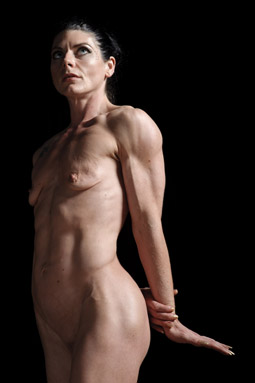
Francesca Steele, Routine
courtesy the artist
Francesca Steele, Routine
THE BELL THAT SOUNDS THE BEGINNING OF THE 30TH NATIONAL REVIEW OF LIVE ART ALSO SOUNDS THE BEGINNING OF THE END: THIS IS THE FESTIVAL’S FINAL INCARNATION IN ITS CURRENT FORM. THE BELL IS SWUNG BY JÜRGEN FRITZ, WHO, LIKE ALL THE ARTISTS IN THIS YEAR’S PROGRAM, HAS PLAYED A PART IN THE FESTIVAL’S HISTORY (HE IS ONE OF THE FOUNDING MEMBERS OF DURATIONAL PERFORMANCE GROUP BLACK MARKET INTERNATIONAL).
Fritz moves slowly at first, the bell making only dull thuds as his arm travels mere inches from his side, and it is several minutes before his swing has accelerated enough for a clear note to ring out. Gradually, carefully, the swings build in energy, until for 30 minutes or so he is swinging exuberantly, ecstatically, joyfully shaking the sweat from his forehead. As a squad of Scottish pipers join in, Fritz surrenders his whole being to the single act of ringing the bell, wildly swinging for love and country and art and folly.
It’s a perfect beginning to the festival, a gesture that both celebrates and says farewell to the NRLA. But at the same time, what is alluring is that it is only a gesture, one that Fritz repeats in different contexts and different cities (for example, in Brisbane in 2008, RT88). It is not for anything or because of anything, but simply the pure, repetitive action: it has a what and a when but no why. Over the five-day festival, densely packed with overlapping performances running from morning until late in the night, my memory accumulates many similar moments: gestures that are beautifully, powerfully meaningless. David Richmond touches his hand to his heart, extends his pinky finger, and raises it in the air. Sheila Ghelani turns to her audience, looks them in the eye, and licks her sugar-coated lips. Iona Kewney hurls and coils her body as dynamically and articulately as a pianist might move her fingers. Lee Wen, clutching a pair of pig’s feet, lowers his twisted frame to lap milk from the floor.
On this anniversary occasion, these gestures are like gifts rather than proclamations. They do not ask me to agree or disagree with them, but are invitations, offerings that I may choose to accept or refuse. Adding live video to a layering of film-within-film, Stephen Partridge’s hands dance furtively and playfully with images of themselves from the past. In the palm of my own hand, Helen Paris from Curious shows me a film in which she lies in the sea on an inflatable raft. Enclosed in a glass display case, Alastair MacLennan blows up balloons and makes gentle traces with his hands, wafting them effortlessly like a bat’s flight slowed down to a visible tremble. For hours he sits, his eyes closed, the case filling up with white balloons. The gesture of blowing up balloons is like an offering of breath, a wasting of space in honour of our being together.
Appropriately for the 30th anniversary, balloons are one of the recurring motifs of the festival. In another durational piece, Elvira Santamaría Torres methodically gathers air into white bin bags, bundling them together to float through the Arches’ vast spaces. At the end of his 30-hour occupation of one of the smaller performance spaces, Michael Mayhew leaves behind a glorious forest of multi-coloured balloons, several of which are carried out by spectators and continue to haunt the remaining events.
Alongside these intimate gestures are, of course, others on a bigger scale: more spectacular, more theatrical, more sensational. And accompanying these are some of the logistical problems that have unfortunately become familiar features of the NRLA over the years. Arriving at the box office at the advertised time to sign up for Ron Athey’s Self Obliterations, I’m told that all the slots were allocated two hours ago. As one of several hundred spectators gathered around Kira O’Reilly’s Untitled (syncope), I catch nothing but brief glimpses of her quivering and teetering body. Through a small window in the door, I peer at Yann Marussich’s Brisures and witness his slow, painstakingly beautiful emergence from a box of broken glass—but I know my experience is nothing like that of those who were at the front of the queue and who are now immersed in a carefully orchestrated world of light and throbbing sound.
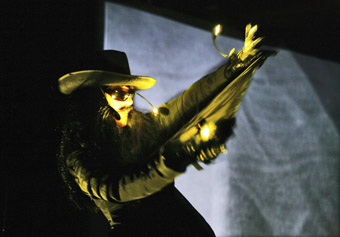
Julia Bardsley, Aftermaths
Some of the other larger-scale events at the NRLA are restagings of works presented at other festivals; for example, Julia Bardsley’s AFTERMATHS and Forced Entertainment’s Void Story both premiered at London’s SPILL 09 (RT 91). The proliferation of other platforms for this kind of work is probably one reason why the NRLA is closing down in its present form. In the early 1980s there weren’t any other opportunities for work like this to be shown in the UK, and the NRLA evolved from the artist-initiated Performance Platform to be a regular event. Now there is SPILL and a reinvigorated LIFT in London, regional festivals such as Birmingham’s Fierce and Newcastle’s Wunderbar (RT95), artist-led initiatives such as the itinerant Forest Fringe and Bristol’s Residence, and regular support for Live Art from fixed venues such as Bristol’s Arnolfini, the Bluecoat in Liverpool, Cardiff’s Chapter Arts Centre, London’s Chelsea Theatre and the Colchester Arts Centre.
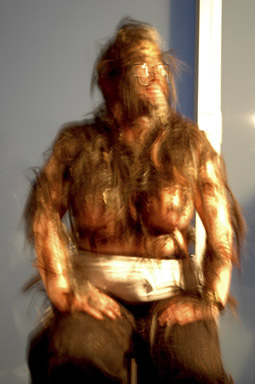
Oreet Ashery
courtesy the artist
Oreet Ashery
And yet, at this final NRLA, I’m aware of the kind of work that is uniquely possible in an environment such as this. It’s hard to imagine a different setting for work such as Oreet Ashery’s Hairoism, in which, over several hours, Ashery’s helpers glue scraps of hair to her shaved head in order to reproduce the characteristic hair styles and facial hair of a series of prominent male figures in the Israeli/Palestinian conflict. Because it is organised toward the production of precisely conceived images, the live element to this work might seem incidental, as if only the final product matters. But it is the live production of the images that makes this work so powerful: Ashery’s fixed, glassy stare and her wonderfully particular, sedentary body; the overwhelming barrage of documentary footage and news clips that fill the room; the silent presence of her deliberately caricatured helpers, collecting hair samples from the wandering audience; and, in fact, the material presence of the documentation of the image in the form of polaroids and simultaneous video feed of Ashery’s body-in-formation.
Likewise, the festival has always been a supportive environment for one-to-one performances, and one of the most powerful examples this year is Francesca Steele’s Routine. From the publicity information I learn that she has been training as a bodybuilder for over a year as her artistic practice. As I queue for over an hour for my five minutes with her, I have a pretty strong suspicion about what the encounter will be. This turns out to be exactly right: on entering the space, I am welcomed onto a small platform by a naked and silent Steele. Inches away from me and staring into my eyes, she moves her radically transformed, de-feminised body through a series of poses that display her lean musculature. Despite knowing exactly what to expect from the work, and despite my familiarity with these kinds of intimate artistic experiences, I leave the encounter palpably shaken, an unknown and untraceable energy working away inside my stomach and trembling in my hands and fingers.
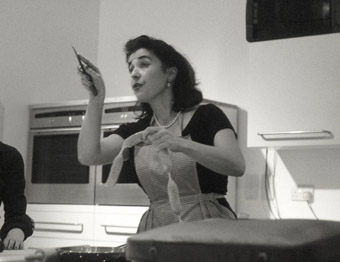
Marica Farquhar
courtesy the artist
Marica Farquhar
Finally, one the most moving and life-affirming events of the festival is Marcia Farquhar’s The Omnibus. Farquhar announces that she will honour the NRLA’s 30 years by ruminating, non-stop, for 30 hours about the last 30 years of her life—during which time she raised her children, struggled with depression and returned to art school as a mature student. (Okay, so it didn’t actually turn out to be 30 hours; initially she planned to invite audience members to stay with her overnight in the theatre, but Health and Safety regulations dictated that members of the public had to vacate the building between 2am and 10am.)
Farquhar’s previous performances have been marked by her meandering, unabashedly self-critical and open-ended monologues. This durational format pushes her to a new extreme. Instinctively, she produces an extraordinary mash-up of two different etiquettes: that of a host in a social situation, and that of a performer in a theatre event. As audience members come and go, she interrupts whatever story she is in the middle of to bid each person goodbye, and cheerfully greets each new guest as if at a dinner party. Trying to catch each newcomer up on what the project is about and what has already been discussed, she is constantly stuttering, winding back to the beginning of the event, forgetting what she was talking about, and reconstructing the thread of the event even as it unravels.
As with the commemorative agenda of this final NRLA, there is a risk that simple nostalgia will dominate. But Farquhar grasps at distant memories, and the more recent past of this particular event, not in order to save the past from being lost but in order to be here now, together. And, despite announcing that she has no plans for a big finale at the end of the 30 hours, we find ourselves stumbling into one: on our feet, singing along to her Sex Pistols original 45 in unison: “No future, no future, no future for you.”
National Review of Live Art, The Arches and Tramway, Glasgow, March 17-21
RealTime issue #97 June-July 2010 pg. 8-9
© Theron Schmidt; for permission to reproduce apply to realtime@realtimearts.net
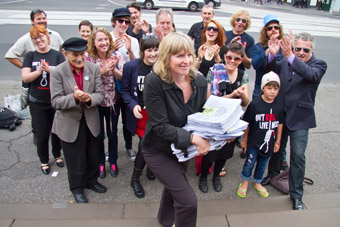
Save Live Music in Melbourne – a petition with 22,000 signatures calling for the the delinking of live music and “high risk” licencing conditions, delivered to the Victorian Government April 7
photo www.carbiewarbie.com, with thanks
Save Live Music in Melbourne – a petition with 22,000 signatures calling for the the delinking of live music and “high risk” licencing conditions, delivered to the Victorian Government April 7
IT IS A COMFORTING THOUGHT THAT AUSTRALIANS ARE GREAT AT ENTREPRENEURSHIP AND SMALL-SCALE INNOVATION, BUT LET ME SUGGEST WHAT WE DO EXTREMELY BADLY: LONG-TERM AND LARGE-SCALE STRATEGIC PLANNING. IF SUSPICION OF GOVERNMENT INTERVENTION IS RIFE, IT MUST BE BECAUSE WE HAVE VIRTUALLY NO EXAMPLES OF A WELL-THOUGHT-THROUGH, AMBITIOUS AND SUCCESSFUL STRATEGIC INTERVENTION. FOR EVERY INNOVATIVE ECO-BUILDING AND LANEWAY FESTIVAL, WE HAVE A FAILING PUBLIC TRANSPORT NETWORK OR A FORGOTTEN CARBON EMISSIONS SCHEME.
One-person innovation has traditionally been the domain of artists—this is the thinking behind many a ‘creative industries’ policy. The corollary is that artists are perceived as situated outside large systems (ministries, policy frameworks) as subcultural rebels, creating on the geographical, economic and social margins, needing no infrastructural support for their ephemeral creations.
Yet, looking at Australian arts in urban terms, another picture emerges. My research finds almost every arts venue in Melbourne since 1991 clustering in loose clouds around public transport, state art centres and educational facilities, and moving around to avoid the worst of the real estate boom—in music, design and performing arts alike. It is tempting to attribute artistic success solely to individual genius, but there is in fact cultural infrastructure in place, which includes schools, low rents and central locations, on which every artist relies, and this infrastructure is what cultural policy can begin to protect.
the importance of breeding places
It is common in artspeak to talk about defunding artistically irrelevant institutions, as Gavin Findlay does (RT96, p8), but it is actually the uncertain funding of institutions that emerges as a bigger problem. For small- and medium-sized companies, flagship buildings to perform in and independent programming venues are a vital link to peers, critics and audiences. Convinced of art’s ephemerality, we forget the importance of ‘breeding places’: spaces and events that yield exposure, attract audiences, house archives, provide education and build social centres for the fleeting world of the arts. They serve their role best when their location and program times are unchanging and predictable—because then they can become meeting points, exchange points, networking points.
When we speak of the ‘independent’ artist, we sometimes forget how much artists depend on each other. Our few remaining theatre archives, the only memory-keepers we have, are tied to institutions with longevity (STC, Dancehouse, arts centres, state libraries); while VCA, Dancehouse or La Mama in Victoria, or Performance Space and TINA in NSW, are actual incubators of ‘scenes’ (social capital, an aesthetic, training), ensuring continuity to the arts. We can myopically boast a long list of important places and events that have ceased operating, from Pram Factory to the Green Mill dance festivals. Our lack of regard for ‘breeding places’ is best exemplified by the treatment of Performance Space, possibly the most important space for contemporary arts in Australia. A living incubator of innovation since the 1980s, having nurtured dozens of our most important performers, it has still not been recognised as a cultural flagship, let alone endowed with a permanent space of its own or operational autonomy within CarriageWorks.
The arts can and do punch back—but only if the issue can be sold in more than artistic terms. As I’m writing this, Victoria’s liquor licensing laws are being tweaked to save The Tote, a ramshackle music venue, from closure. Politicians were more worried about the voting preferences of the 200,000 protesters than the cultural significance of The Tote, granted; but the 200,000 saw The Tote as an indispensable part of Melbourne’s culture, not a den for a handful on society’s margins. However, this hasn’t come out of nowhere: at least since Espy, the iconic music pub in St Kilda, was threatened with closure in 1997, live music has been promoted as a key part of Melbourne’s ‘cultural’ specificity. Yet there must be a better way to protect cultural incubators than with rallies.
culture as a given
For many arts practitioners, the debate on the national cultural policy may look suspiciously like yet another thing to complicate already-fuzzy KPIs—but it would be unwise to limit the discussion to arts funding, because it is about more than that. To admit to a ‘culture’ is to say that there are things that we do that are important and worth protecting, because they make us who we are, regardless of their economic, health or social outcomes. In a sense it is irrelevant whether ‘culture’ includes media (as in Germany), is defined as “anything that stimulates closeness” (as in Croatia) or is left undefined (as in many European countries that nonetheless have robust cultural policies). It is primarily a principle of protection.
Artists should understand the power of words. At the moment, one of these is ‘economy.’ Being good or bad for the economy, vaguely defined, is argument enough to defend or shelve a policy. Agreeing that we have a ‘culture’ would allow a whole new string of arguments to be made and, with due respect to David Throsby, defend the arts not on the grounds of its goodness for the economy, community or health, but simply as important for our culture.
Of course, arts policy in Australia already assumes ‘culture’: funding of opera is otherwise inexplicable. But let me give you a sense of what else ‘culture’ might protect: in the 1990s Amsterdam initiated Broedplaats (“Breeding Places”), a squat protection policy, recognising them as incubators of creativity. “No Culture Without Subculture” was the mayor’s rallying cry. Formation of ‘alternative cultural centres’ is common throughout Europe, with a kind of light heritage overlay protecting use, rather than the form, of a building. Palach, in Croatia, has been an alternative music venue/gallery/café/performance space since 1968. It has had its dull phases, of course, but a new generation of bright young things inevitably emerged, taking over the same central location and benefiting from access to facilities, a ready-made audience and previous generations of artists. Similarly, the Save the Espy campaign in Melbourne could not rely on existing state laws to protect the beloved music pub: it didn’t qualify in terms of architectural, community or social heritage. After a prolonged fight, Espy was ultimately saved in 2003 because the local council managed to install sufficient protection on the grounds of local ‘cultural’ significance.
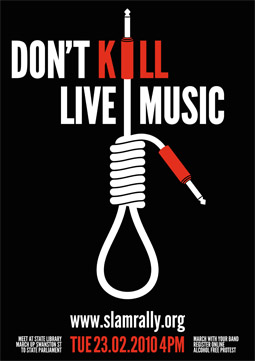
Save Live Music in Melbourne (SLAM) poster
cutting across policy areas
Another intervention that only national cultural policy can achieve is the nurturing of systems, interventions that cut across policy areas and require departmental collaboration on the federal level. Many have been picked up in the submissions to Peter Garrett’s cultural policy discussion website: simplification of artist work visas, greater support for regional and overseas touring (having no national culture, Australia has no sustained cultural diplomacy either). To this I would add improvements to arts education, understanding the importance of subcultures and integration of arts institutions into the urban fabric—giving them centrality, advertising, public transport. What was the point of investing millions in CarriageWorks, I wonder, if it is still sitting next to an underdeveloped train station, in a dark street, untouched by a single useful bus line? A comparatively cheap intervention into public transport would have quadrupled the returns on the enormous investment. Instead, one of Sydney’s most central performance venues manages to remain hidden to most of its population.
But what I would like to see most is some meaningful form of social security for artists. In most countries with ‘culture’, artists benefit from tax exemptions and reductions, access to free health insurance and pension funds, and different forms of income support that usually don’t require active job seeking. It is a measure that gives artists some modest existential certainties, but it’s also an intervention that the Australia Council for the Arts cannot initiate on its own.
art without culture…?
Judging from the way we mangle our strategic policies, there is no reason to assume Garrett’s national cultural policy will get everything right. But defining ‘culture’ as an intangible, but protectable and nurturable good is the first step towards building systems, structures and strategies that ensure longevity for what we’ve got. We need culture if we want to remember, and be remembered ourselves; if we want our art to matter. Without ‘culture’, we’d have no culture wars, true, but also no values, meaning, sense. Without culture, nothing differentiates the arts from any other unprofitable industry. And without culture, there is literally no subculture.
Jana Perkovic is working at the University of Melbourne on an ARC-funded research project titled “Planning the Creative City”, studying the geographical clustering of independent arts in Melbourne, Sydney and Brisbane, and the relationship between arts policy, demographics and urban planning. She writes for RealTime on contemporary dance and performance in Melbourne and Europe.
RealTime issue #97 June-July 2010 pg. 10
© Jana Perkovic; for permission to reproduce apply to realtime@realtimearts.net
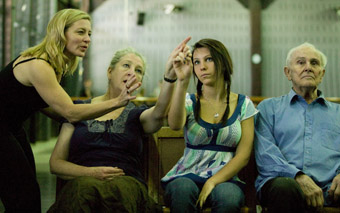
Kate Champion in rehearsal with cast members from Force Majeure’s The Age I’m In
photo Lisa Tomasetti
Kate Champion in rehearsal with cast members from Force Majeure’s The Age I’m In
THERE IS SOMETHING IN THE AIR IN AUSTRALIA CONCERNING AUDIENCE ENGAGEMENT. THE AUSTRALIA COUNCIL FOR THE ARTS’ PUBLICATION OF “MORE THAN BUMS ON SEATS: AUSTRALIAN PARTICIPATION IN THE ARTS,” IN MARCH THIS YEAR, PICKED UP ON A DESIRE FOR MORE PROFOUND ENGAGEMENT WITH THE ARTS FROM AUDIENCES ACROSS THE NATION.
Arts Queensland’s bold Coming to a Stage Near You strategy for performing arts touring, launched in 2009, combined with its Regional Stages partnership with the Australia Council, is pioneering a ‘demand-driven’ model for regional touring. And the Roadwork performing arts consortium which I reported on in “Australian Dance, Unseen at Home” (RT95 is supporting a 12-venue national touring circuit for “adventurous” dance and theatre productions.
I spoke to John Baylis, Associate Producer at Performing Lines, to better understand whether this ‘push’ for two contemporary performance productions per annum through the network was going to be met with a ‘pull’ from their audiences. Baylis responded, “Having established the network and sent our first production out [Force Majeure’s The Age I’m In], the next challenge is to make sure that tours are successful locally. We do not want tiny audiences and for venues to lose confidence in the audience appeal of adventurous work.” He spoke about the Roadwork Audience Engagement Plan, recently commissioned from freelance consultant Angharad Wynne-Jones, who ran innovative audience engagement projects during her directorship of the LIFT festival in London, 2004-2008. For Roadwork, her brief was to create a long-term audience engagement plan which would take the $60,000 the Australia Council funding makes available for marketing each year and leverage it into a powerful and sustainable program of activities for the venues to tailor and share.
Baylis described how network members had been enthused by the 2009 Australian Performing Arts Centres Association (APACA) conference at which American consultant Alan Brown of Wolf Brown talked about his study of the impacts of live performance and his vision for a new language and methodology for evaluating arts activities. Brown’s “Assessing the Intrinsic Impact of a Live Performance” investigates the impact of an entire arts system, the cumulative impacts or ‘value footprint’ of an institution on its community and the impacts of a single performance on an individual. In a private workshop for the Roadwork venue managers, Brown was able to elaborate upon the practical implications of his discoveries. The presenters were keen to put his ideas into action and soon after agreed to tour Lucy Guerin Inc’s Untrained, a production with huge potential for audience development due to its integration of two non-professional local ‘performers’ in many of the venues in which it is presented.
Wynne-Jones’ plan is also influenced by US thinker, Diane E Ragsdale, whose address to the Arts Marketing Association of the UK, “The Excellence Barrier”, makes pithy warnings such as “Don’t conflate Money or Attendance with Impact” and recommendations which include “Let people in on the action” and “Be a concierge: filter and make recommendations.” Wynne-Jones writes “For engagement to happen, significant behaviour change (from production, presenting and consumption to engagement) needs to occur in artists, presenters and audiences, including more engagement with artists before the work is created; more entry points and interactivity options for audience members to self-manage their experience and to connect with each other as a social network; and for the audience to be regarded by presenters and artists as collaborators in the experience.”
Wynne-Jones cites an initiative from one of her other areas of activism, climate change (specifically the Castlemaine 500 project) to illustrate her philosophy for change. “One of the most effective ways to change behaviour has been identified as being involved in small groups, taking actions and supporting one another in that action and sharing reflections and learnings (as opposed to mass marketing educational campaigns or policy directives).” Wynne-Jones began the formulation of her plan by consulting six performing arts companies who have all toured regionally with some degree of success. PVI Collective, Urban Theatre Projects, Force Majeure, Lucy Guerin Inc, Version 1.0 and Back to Back displayed an eagerness to embrace her ideas and to invest their resources in audience engagement activities. John Baylis, Stephen Champion (Bathurst Memorial Entertainment Centre), Kar Chalmers (Performing Lines, previously with the Old Fitzroy Theatre) and Rick Heath (Push Management) added their perspectives. Aware that the venues in the consortium have diverse resources and needs, the plan offers a menu of possibilities. Having voted upon their preferred recommendations, the consortium members will meet in May 2010 to decide which of the favoured initiatives will be implemented.
Many of the proposals in the plan require no financial investment, although there is always a degree of people power involved, from artists, venues and the community. Local artists are often engaged as intermediaries between the touring companies and the community. Strategies that segment and target community groups are not innovative in themselves, yet the plan is novel in its structured commitment to engaging with these groups with long-term consistency and respect for their authority in local matters. Quirky proposals include a suggestion that venues host a dinner with the “big or talkative cheese in town for the company on the pre-tour road trip.” Another suggests, “Local audience members and artists take the company members on a guided tour of the hidden secrets of the town (best op shops, swimming spot, graffiti, bar meal etc).” More obvious ideas about workshops and post-show talks are given impact by the underlying principal that the company visits each venue with sufficient lead time to begin the process of engagement with the eventual production, and that the groundwork for these interactions is laid and maintained by the venue. An “engagement coordinator” position in each venue is recommended and comprehensive strategies for evaluating the success of the initiatives and sharing results as a network run throughout the plan.
The Roadwork consortium presenters have responded positively to the plan and many have expressed their appreciation of the opportunity to spend face to face time discussing these matters together. Several of the venues have already begun this process of deepening their interaction with audiences. At Illawarra Performing Arts Centre, Simon Hinton’s team films vox pops in the foyer on opening nights, posting the videos of audience reactions to the show on YouTube. Lewis Jones of The Empire Theatre in Toowoomba has been using Arts Queensland’s Regional Stages funds to support an extensive program of workshops with touring companies. Anne-Marie Heath of the Civic Theatre in Wagga Wagga has engaged with Bangarra Dance Theatre in a week of workshops culminating in a community dress rehearsal for the local Indigenous community and educators.
While there are reservations amongst some about the plan’s many social networking recommendations or the resources required to implement certain ideas, there are also suggestions that indicate a second stage of investment in this process will be welcome. The presenters are interested in longer term relationships with artists and many are keen to explore three to five year residencies. In Queensland, with its new democratic model of audience-driven programming, Lewis Jones says, “Should we be looking at a deeper strategy where we are proactively seeking works that resonate with our regional audiences? Or even better are created in a regional area?”
These responses to the Roadwork Audience Engagement Plan indicate that presenters are as invested in animating their venues and engaging their audiences in profound arts experiences as artists are in creating them.
RealTime issue #97 June-July 2010 pg. 13
© Sophie Travers; for permission to reproduce apply to realtime@realtimearts.net
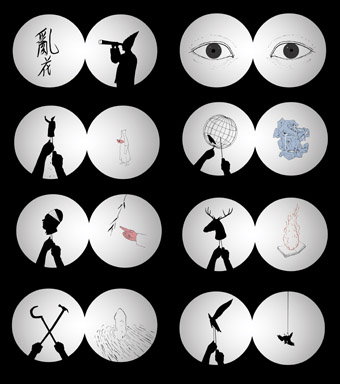
Flowers of Chaos, 2009, Wu Junyong; exhibited as part of Mu: Screen, UTS Gallery
courtesy of the artist
Flowers of Chaos, 2009, Wu Junyong; exhibited as part of Mu: Screen, UTS Gallery
mu: screen, three generations of chinese video art
If you’ve been following RealTime+OnScreen’s continuing account of Chinese feature films, documentary and the work of artist Wang Jianwei in RT96 (p41), you’ll want to see MU:SCREEN, Three Generations of Chinese Video Art. This important show includes works by the pioneers of the form in China, Zhang Peili and Wang Gongxin. The other six artists represented in Beijing-based Marie Terrieux’s program are proteges of the older artists and recent graduates of the first video departments, set up in Hanghou and Beijing art academies as late as 2003. MU:SCREEN, UTS Gallery. Level 4, 702 Harris St Ultimo, Sydney, see www.utsgallery.uts.edu.au for times.
rescue carriageworks now!
Jana Perkovic, writing about the development of an Australian cultural policy (p10), says of Performance Space: “A living incubator of innovation since the 1980s, having nurtured dozens of our most important performers, it has still not been recognised as a cultural flagship, let alone endowed with a permanent space of its own or given operational autonomy within CarriageWorks.” This complaint resonates with growing concern about the artistic direction and management of CarriageWorks.
Headed “Rescue CarriageWorks Now—Lobby for a relevant CEO!” the following statement has been circulating via Facebook since the resignation of the centre’s first CEO, Sue Hunt: “This group has been formed to solicit support in lobbying for strong contemporary arts sector based leadership to take the reins of CarriageWorks and steer it back to its original purpose of supporting, cultivating and presenting quality contemporary arts.” The lobby leaders argue that “mainstream inspired leadership” has resulted in commercial and bureaucratic imperatives” and “a complete void in the appreciation of real sector needs…” rescuecarriageworks@hotmail.com
constellation: a durational chamber work
Melbourne composers and sound designers Madeleine Flynn and Tim Humphrey have collaborated with an intriguing spectrum of artists engaged with music and sound, commissioning works from Ros Bandt, Carolyn Connors, Rohan Drape, Robin Fox, Sebastian Harris, Anita Hustas, Neil Kelly, Graeme Leak, Kate Neal, Wang Zheng Ting and David Young. Each piece is a response to the artist’s year of birth in the Chinese zodiac. Performances are cumulative: on the first day one piece, working up to all of them on the last day. The compositions gradually become part of a greater work with many dimensions: objects, scores, instructions, installations and video.
The artists describe the gallery space as “set like an emptied chamber orchestra with desks and a small grand piano. Each orchestral desk has a chair and music stand representing a composer. When seated at the desks, visitors can access a recorded version of the work that each composer has written.” The compositions are scheduled to be performed live by Flynn and Humphrey “on piano, prepared piano, flugel, laptops, modified midi wind controller, toy piano and windup toy rabbit…” All performances are free of charge. Constellation is produced in association with Red Gallery, New Music Network, Arts Victoria and Liquid Architecture. For information on the artists and their creations visit http://madeleineandtim.net. Constellations, Red Gallery, 157 St Georges Rd, Fitzroy North, Melbourne, July 1-19, www.redgallery.com.au; www.liquidarchitecture.org.au
the rabble, cageling
The Rabble return to CarriageWorks for their third season there since 2006 to perform Cageling, an impressionistic, surreal even, response to the nightmarish world of the oppression of Spanish women poetically conjured in Lorca’s play The House of Bernarda Alba. In an interesting move, Melbourne actor (and director) Daniel Schlusser is cast as Bernada, the tyrannical mother. The show, which premiered to a spectrum of strong responses in Melbourne in May, has been devised, designed and directed by Emma Valente and Kate Davis. The Rabble, Cageling, Carriageworks, Sydney, June 24-July 3
RealTime issue #97 June-July 2010 pg. 14
© RealTime ; for permission to reproduce apply to realtime@realtimearts.net
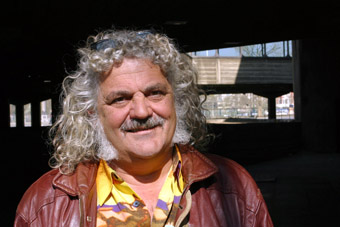
Pierrot Bidon
photo Philippe Cibille
Pierrot Bidon
FITTINGLY, THE LAST ACTION OF PIERROT BIDON WAS TO GIVE THE PEACE/LOVE SIGN WITH THE LEFT HAND, AND THE THIRD FINGER UP WITH THE RIGHT.
A larger-than-life showman and director, Bidon is rightly credited with revolutionising the stagnant artform of traditional circus into the post-industrial, often edgy and certainly evolving artform that we have today.
From travelling Cirque Bidon (1975) to the small villages of France and Italy with horses, gypsy caravans and an open-air show, to the formation of Archaos in 1986, he led the way. As a tightrope walker he was already deconstructing the form—playing with the contract between performer and audience that had previously been sacrosanct in circus. Miked up, he would provide a personal, almost contemptuous, commentary on audience expectations of a ‘death defying feat’ and how he could, so easily, feed their appetite for proximity to close calls and disaster.
Archaos, subtitled Cirque Revolutionnaire and Cirque de Caractere, was a complete assault on the senses. It was a radical evolution: the smell of greasepaint, sawdust and animals replaced by petrol, oxy-acetylene torches, burning rubber and pyrotechnics. No sequins, spangles or red noses, but crash helmets, corrugated iron and boiler suits. No horses, lions or elephants but motor bikes, juggled chainsaws and fork lift trapeze rigs with a rock ’n’ roll, Mad Max/punk, apocalyptic aesthetic that was loud, in your face and literally explosive.
“ We are the animals” he declared, a simple statement that set the city fathers aquiver. Publicity was always as entertaining as the show and intended to rattle cages. “It’s our mission to shock society. I’m here to shoot society in the head,” said Bidon. Cars fell in half as he arrived for the assembled press. There were motorbike stunts over stationary traffic in an unsuspecting city. Daring stuff, but mostly it was mischievous and cheeky, albeit with the underlying and ever-present threat of anarchy.
Post Archaos, Pierrot set about helping those less fortunate—the streetpeople who inspired him. In the shanty towns of Brazil, street performance workshops led to the creation of Circo Madrugada. In 1998, in Conakry, Guinea, he created Cirque Baoboab, a circus spectacular that toured extensively with jugglers, dancers, acrobats and a West African beat.
The Archaos tour to Adelaide and Melbourne in 1990 had an enormous and enduring influence that changed circus in Australia forever. “We are free,” he claimed and then showed us the possibilities. The blinkers were off. Archaos inspired a new generation of circus performers and created a climate, both here and overseas, where new circus could flourish. We reap the benefits with a popular, burgeoning form that can traverse genres while respectfully and proudly remaining ‘circus.’
For fearlessly leading the way with astounding skill, artistry and thrilling showmanship, we salute you, Pierrot. Peace, love and third finger up!
Janine Peacock
After the expansive experience of working with Archaos on the 1990 tour to Adelaide and Melbourne, Janine Peacock travelled the world with Australian and French companies. In 2009 she was awarded an Australia Council-Community Partnerships Creative Producer Initiative and is now operating as a facilitator for independent artists and projects under the banner Loose Canon Art Services.
RealTime issue #97 June-July 2010 pg. 14
© Janine Peacock; for permission to reproduce apply to realtime@realtimearts.net
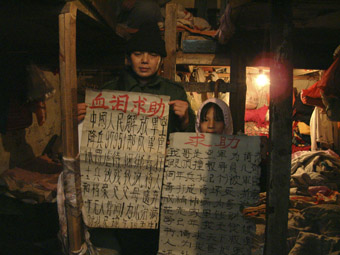
Petition
“BRING DOWN CORRUPTION, GIVE ME MY HUMAN RIGHTS!” THAT’S THE PLAINTIVE CRY HEARD NEAR THE BEGINNING OF ZHAO LIANG’S FILM, PETITION, A DISTURBING LOOK AT THE BRUTALITY, VIOLENCE AND INTIMIDATION SURROUNDING THOSE SEEKING JUSTICE IN CONTEMPORARY CHINA. GUO XIAOLU’S ONCE UPON A TIME PROLETARIAN SIMILARLY CONTINUES THE CHINESE INDEPENDENT DOCUMENTARY TRADITION OF PROBING WHAT LIES BEHIND THE GLITTERING FACADES OF CHINA’S ECONOMIC SUCCESS. BOTH FILMS APPEARED AT THE RECENT HONG KONG INTERNATIONAL FILM FESTIVAL, THE ONLY PLACE IN THE PEOPLE’S REPUBLIC WHERE SUCH CRITICAL WORKS CAN PLAY AT SUCH HIGH PROFILE EVENTS.
petition
Zhao Liang’s confronting feature-length documentary is the result of more than a decade of living and filming in a shanty town next to Beijing South Railway Station. The slum—now demolished—was once home to a floating population of thousands who came from all over the country to lodge complaints about authorities in their hometowns. Petitioning is a vestige of China’s feudal past, when any subject theoretically had the right to complain directly to the emperor if wronged by a low-level official. In a society where all levels of government, the courts and police are tightly controlled by the Communist Party, petitioning is the last hope for those seeking redress for an injustice.
Zhao’s film opens with his subjects recounting the litany of problems that brought them to the capital, from compulsory grain requisitions unpaid for by local officials to workers laid off from state enterprises without notice or compensation. Others have had their homes demolished without recompense, or suffered abuse in the armed forces.
The hopelessness of the petitioners’ situation quickly becomes apparent as Zhao follows them into offices ostensibly set up to receive their complaints. Filming secretly, Zhao captures the lethargic indifference of officials ensconced behind metal grilles and glass screens, who routinely deploy security guards to drag away old men and women and beat them when they resist. Outside, “retrievers”—hired thugs sent by local authorities to bring back those attempting to lodge complaints—lurk around the offices, assaulting petitioners and sometimes threatening to kill them if they do not leave Beijing. One petitioner who has been encamped in Beijing for 18 years is chased onto a railway line to be torn apart under a passing express train.
The extreme psychological stress inflicted by this system is traced through the story of Qi, a middle-aged woman pleading for an investigation into the death of her husband, who died mysteriously while undergoing a compulsory medical at work. When we meet Qi, her daughter is a young teenager, loyally following her mother to government offices day after day, rummaging through rubbish for food as they eke out a living in the petitioners’ slum. As she sees her youth and chance for education slip away, the daughter becomes increasingly disillusioned with her mother’s quest, and after years of waiting she flees with a young man to start a new life. She explains her motivations to camera, before entrusting Zhao Liang with a farewell note to her mother.
When Zhao hands the note to Qi, she breaks down and flees the filmmaker’s lens, accusing him of abetting her daughter’s “escape.” Zhao follows and begs her to stop, but after a prolonged chase that is at once absurd and heartrending, Zhao comes to a halt and we see the distraught mother disappear into the distance.
The sequence represents a narrative and ethical crossroads, the point where Zhao’s film becomes less a documentary ‘about’ these people and more an obsession that begins to disturbingly resemble that of the petitioners themselves. It’s as if Zhao, having witnessed and filmed these people’s suffering for over a decade, feels he must stick with them even when they reject his presence, keeping his camera rolling to ward off the awful truth that their situation will likely never be resolved. How do you finish a real-life story about injustice without end, in a system that offers endless new traumas in place of closure and resolution?
As it happens, outside forces bring some sense of cinematic closure. Shortly before the 2008 Olympics, Beijing South Railway Station and the adjoining slum are demolished to make way for an ultra-modern bullet train terminus. We see petitioners scrambling amongst the rubble as they desperately try to retrieve their meagre possessions before they are forcibly relocated to the city’s outskirts. The traumatised Qi disappears and Zhao learns she has been imprisoned in a psychiatric ward until the Games are over. The petitioner’s village is gone, but their story continues, an endless cycle of misery carefully concealed from visitors to the capital.
once upon a time proletarian: 12 tales of a country
Guo Xiaolu’s Once Upon a Time Proletarian: 12 Tales of a Country looks at life outside China’s prosperous key cities. It comprises short interviews with 12 subjects of varying backgrounds, starting with an outspoken farmer whose first words to camera are, “This country is shit!”
Continuing his straight-talking critique of contemporary China, the farmer exclaims, “It’s just raping, corruption, bribing and stealing…the Communists now are completely corrupt…people only care about how to make money. As long as it suits them—fuck the rest!”
While the film’s other subjects are more restrained, endemic corruption remains a common theme. A small-time restaurateur in the hometown of Lei Feng, a PLA soldier Mao once extolled as a virtuous model for the nation, explains how economic “reforms” have corroded the social fabric of the town: “Without bribing you can’t do anything. Money here can make a dead man alive.”
Guo Xiaolu’s interviewees reveal the profound disconnect many feel from their own lives in a society that is at once authoritarian and poor, yet rabidly materialistic. The restaurateur in Lei Feng’s hometown says, “We have no feelings, we just do business…I don’t care for anything else. I’ve more or less lost my life.” A fishmonger comments, “My life is blind,” though she adds that things were much worse back in her village. Young hotel workers explain how their days are an endless cycle of long hours worked for minimal wages. “Nothing is meaningful,” one of them says. “It’s difficult to even think.”
We also meet some who have gained from economic reforms, though corruption continues to lurk behind every comment. A wealthy hotelier explains that “the peasants were moved elsewhere” to make way for her hotel, a casual reference to the ongoing land grab that has seen vast numbers across China thrown out of their homes for little or no compensation in the name of ‘development.’
The film’s final sequence sees a group of young children in an art class speaking to camera. One boy confidently states he wants to be a famous artist, though he amusingly adds that Van Gogh and de Vinci were pitiable because, “They were poor and couldn’t find girlfriends.” His ideal life is “beautiful, free, without any restrictions.” A young girl speaks with quiet intelligence about her love of Van Gogh. Their optimism and confidence provide a sharp contrast with the adult interviewees, though whether this represents youthful naivety or a hope for the future is left open.
Once Upon a Time Proletarian sets hope against apathy, progress against problems, development against ongoing poverty. Most of all, Guo’s film, along with the more intense despair of Petition, evokes the existential void at the heart of a society in which the state fails to provide even a modicum of impartial justice, and treats any dream save material gain with suspicion.
Petition (Shang Fang), director Zhao Liang, producer Sylvie Blum, People’s Republic of China, 2009; Once Upon a Time Proletarian: 12 Tales of a Country (Ceng Jing de Wuchanzhe), director, producer Guo Xiaolu, producer Pamela Casey, People’s Republic of China, 2009
RealTime issue #97 June-July 2010 pg. 16
© Dan Edwards; for permission to reproduce apply to realtime@realtimearts.net
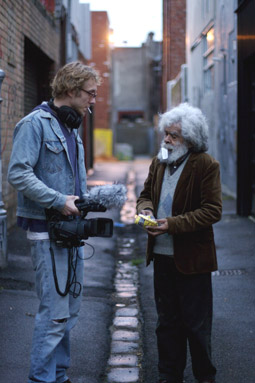
director Amiel Courtin-Wilson and Jack Charles, Bastardy
photo Adam Arkapaw
director Amiel Courtin-Wilson and Jack Charles, Bastardy
WHEN TOM ZUBRYCKI TOOK TO THE STAGE AT THE AUSTRALIAN INTERNATIONAL DOCUMENTARY CONFERENCE EARLIER THIS YEAR, TO ACCEPT THE STANLEY HAWES AWARD FOR HIS CONTRIBUTION TO THE AUSTRALIAN DOCUMENTARY SECTOR, HE DID SO WITH HIS CROSSHAIRS TRAINED ON TWO OF THE SECTOR’S BIGGEST GAME.
“At the ABC and SBS,” Zubrycki warned in his acceptance speech, “documentary slots are becoming more prescribed and rigid. Programs are tending to be format-driven and lighter in content. The range of subjects, viewpoints and ideas hitting our screens is narrowing.”
An independent filmmaker for over 25 years, Zubrycki accused the public broadcasters of exerting too much influence on the style and substance of the documentaries being made in Australia, as well as making programming decisions that ultimately stymied emerging filmmakers at the expense of those already established. “Don’t get me wrong,” he said. “We are pleased public broadcasters are commissioning our ideas. But is this concentration of decision-making good for the industry? For diversity?”
For many—filmmakers, critics and bureaucrats alike—the answer is an emphatic no. Zubrycki’s comments come at a time when, for all the critical acclaim and popular success enjoyed by certain high-profile documentaries and their makers, the vast majority of non-fiction films made in this country reek of a paint-by-numbers sameness. This tends to be the case regardless of whether a film is intended for theatrical release or broadcast: with important exceptions—Anna Broinowski’s Forbidden Lie$, Gillian Armstrong’s Unfolding Florence, and so on—most films choose not to experiment with visual language or create cinematic forms unique and relevant to their content, limiting themselves instead to a handful of only the most anaemic televisual tropes. All but a few devote the balance of their attention to individual psychology at the expense of social and cultural phenomena, or else tend towards the inoffensive genres of history and the natural sciences.
“There is a certain rigidity creeping in at the level of both form and content,” Zubrycki says. “Character and narrative-based documentaries are getting rarer and rarer. Of course, this is ironic because those are exactly the sorts of films that distributors around the world are crying out for.”
Much of the problem, he says, can be traced to the disappearance of half-hour and feature-length documentary slots from the public broadcasters’ line-ups, with high-concept documentary series taking precedence where once stand-alone films, by both emerging and established filmmakers, were the norm.
“The 30-minute documentary slot on SBS, Inside Australia, which was canned two years ago, was very important,” Zubrycki says. “Admittedly, the quality varied, but the series also produced some very good programs, which secured the broadcasters good ratings and gave emerging filmmakers an opportunity to give vent to their creativity on a project that was often original and unique.
“It’s too much to ask a filmmaker to have a four-part series of half-hour episodes as their first substantial documentary project. The risk of failure is too high. I wouldn’t be surprised if SBS follows the ABC in future by reducing its risk-taking and commissioning almost solely from established filmmakers.”
“What happens to emerging filmmakers then?” he asks. “It’s back to do-it-yourself filmmaking, which is fine if you’re making your first film, but hard if you want to begin establishing a career.”
Not that the public broadcasters, with their increasingly intransigent frameworks, are necessarily the best place for an established filmmaker, either. “I think what Amiel Courtin-Wilson is doing in Melbourne is really interesting,” Zubrycki says. “He tends to work with his protagonists for years, as he did with Jack Charles on Bastardy, and often has several films on the go at any one time. Then there’s John Hughes, who’s evolved his own masterly and unique style of essay film and whose new doco, Indonesia Calling, is playing at the Sydney Film Festival…But we have very few documentary auteurs in this country, which is mainly due to the dominance of the television-biased funding model.”
Zubrycki admits that alternatives do exist for filmmakers whose work does not tick the usual boxes. He believes that Screen Australia’s Special Documentary Fund, which has no market attachment requirements and has been set up to benefit those who wish to work independently of the broadcasters, needs to be expanded, noting with irony the fact that a number of films made possible through the scheme have since been sold back to channels that originally turned them down. He is also interested in the role that philanthropy could come to play in the sector over the course of the next 10 years. “In countries like the United States and Britain there are philanthropic institutions that actively support documentaries,” he says. “While that has been slow to take off in Australia, the Documentary Australia Foundation has been doing some great work in the area. It’s also very encouraging that some of the country’s film festivals are supporting documentaries.”
A recent alternative has emerged: the South Australian Film Corporation’s new Documentary Innovation Fund, which seeks to fund those projects that fall outside the funding and programming requirements of the public broadcasters.
“The ABC and SBS have for a long time been the agenda setters for documentary,” SAFC CEO Richard Harris says, “mainly because the commercial networks have always assumed there is no mass audience for docos.” (A curiously ironic view, he notes, given the commercial networks’ “ravenous” appetite for reality-based hospital, police and surf-lifesaving programs.)
“It is a fact that the ABC and SBS have recently moved away from their interest in one-offs and are more interested in series. I also think it is safe to say that they have generally become more risk-averse and more audience-driven in their approach. The public broadcasters have become more devoted to developing schedules and timeslots, where people know what to expect at a certain time, which is interesting in and of itself given that this is in fact a time in which audiences are starting to uncouple themselves from the idea of ‘appointment viewing’.”
“As a result,” he says, “I do feel that the balance has tipped and that there appears to be little room for programs that do not fit what have become more rigid schedule dictates. I think that this is unfortunate.”
The Documentary Innovation Fund, which closed its first round of applications in May, was born of what Harris describes as the funding body’s commitment to diversity. “There needed to be somewhere where the broadcasters were not the key gatekeepers,” he says. “While the broadcasters are major players—and thank god they are—they shouldn’t be the only ones. And this is particularly the case in South Australia where, with a few exceptions, we have a somewhat nascent documentary sector that doesn’t yet have the runs on the board.”
As for the question of where certain documentaries belong—on the big screen or the small one—Harris is convinced it will become less and less relevant as convergence and crossover become more and more prevalent.
“The line between cinema and television is such a vexed issue,” he says. “I do think it’s interesting that Bastardy, which was made with almost no budget, ultimately screened both theatrically and on the ABC. Perhaps that serves as an example of the new convergent world we are living in. If the boundaries are expanding, it’s because there’s no longer the same distinction between what should be seen on the theatrical screen and what should be seen on television or even on the net. I can’t help but feel that’s a good thing.”
Harris’s reference to the internet here does not quite convey the level of importance he ascribes to digital technologies and their potential uses. Indeed, both he and Zubrycki believe the future of innovative documentary filmmaking is ultimately to be written in binary, with the low-budget, self-distribution paradigm that digital video and the internet have made possible set to play an ever more crucial role.
“Digital distribution, both online and on theatrical screens, is going to offer exciting opportunities to those who are positioned to take advantage of them,” Harris says. “This will be the space for those filmmakers who have a true authorial voice. I think that form and subject matter will actually become more interesting in this space and that the influence of the broadcasters on these documentaries will become less and less.”
Zubrycki agrees. “The production system has changed almost beyond recognition in the last 10 years,” he says, “and that in turn has expanded documentary language.” And we can expect to see a similar evolution over the course of the next 10. “Faster download speeds are going to open up new horizons for distribution and should provide a new and useful income stream for producers,” he says.
For the most part, though, Zubrycki can’t see his big-game targets going down any time soon. “I think the current state of affairs will continue for a while for the simple reason that the industry wouldn’t survive were it not for television,” he says. “Television—both terrestrial and increasingly pay—will remain the main source of funding for documentaries.”
But Harris, who readily describes himself as an optimist, is not so sure. The big-game may be lumbering along as ever, he suggests, but with new and exotic mammals on the horizon, perhaps some much-needed change is already underway. “It’s a bit of mixed bag really,” he says. “With the conventional players vacating the space, I actually think the future options for documentary filmmakers are going to be quite exciting.”
For Tom Zubrycki’s Stanley Hawes Award address, go to www.tomzubrycki.com/read/2481982295.html. Applications for the current round of the South Australian Documentary Innovation Fund closed on May 17, but you can read about it on the Programs page at www.safilm.com.au.
RealTime issue #97 June-July 2010 pg. 17
© Matthew Clayfield; for permission to reproduce apply to realtime@realtimearts.net
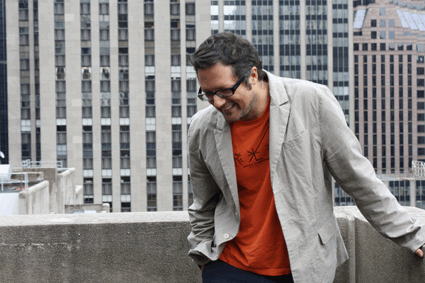
portrait Rafael Lozano-Hemmer, photo Ana Cristina Enrique; installation shot People on People, Rafael Lozano Hemmer 2010, Recorders Manchester Galllery UK, photo Peter Mallet
RAFAEL LOZANO-HEMMER IS BACK IN AUSTRALIA FOR THE WORLD PREMIERE OF A MAJOR NEW WORK, SOLAR EQUATION, WHICH WILL RUN JUNE 4-JULY 4 AT FEDERATION SQUARE IN MELBOURNE AS PART OF THE ANNUAL THE LIGHT IN WINTER FESTIVAL. DURING ITS INSTALLATION, HE SPOKE WITH SCOTT MCQUIRE, WHO INTRODUCED READERS TO THE WORK OF THE ARTIST IN REALTIME 89.
Can you begin by describing the new work?
Sure. Solar Equation is a 100,000,000: 1 scale maquette of the sun. We have floated a tethered aerostat—a static balloon—filled with helium and cold air over the Federation Square plaza. And what we’re doing is projecting, from five projectors, live mathematical simulations of the behaviour of the surface of the sun.
Since 1995, a new space observatory called SOHO has been sending imagery of the different types of solar flares and turbulence and dark spots—the actual weather patterns that can be seen at the sun. (The Solar and Heliospheric Observatory is an international collaboration between ESA and NASA; http://sohowww.nascom.nasa.go.) Another new observatory called SDO (Solar Dynamics Observatory, http://sdo.gsfc.nasa.gov) is now receiving imagery of the solar surface which almost matches the resolution of the earth’s surface that you can get with Google Earth. I think that the availability of all that imagery asks us to think about the sun in a different way. It used to be depicted in a very iconic way, and a symbolic way, and a mythical way. Today we’re beginning to see it more as a representation of non-linear processes. Solar Equation is a way to faithfully represent those phenomena in a scale that is more urban. Most importantly, it’s not a video that loops around, it’s actually imagery taken by SOHO and SDO overlaid with equations, which simulate those behaviours on the surface. It is mathematics playing back complex systems that will never be repeated.
Where did the idea for aerostat come from? And what are some of the practical issues about projecting the images onto that moving surface?
One of the issues with Federation Square is that it’s already a very complex space. It’s very much spoken for, every single surface is already expressing. It’s very baroque. So you either need to be strategic and do something very elegant and well placed, or something that’s going to speak to the scale of the square. And the only place I thought I could do that was the sky, because every other surface was already really predetermined. So early on I decided that it should be a piece for the sky. And I have never worked with inflatables, so I thought that would be an interesting direction to go in.
You like a challenge!
Yeah! When I first went around and I asked different companies to build this for us, literally all of them said that it’s impossible to do, because Melbourne has 90 kilometre per hour winds in a worst case scenario. So no company would agree to engineer something like that until we found Airstar (www.airstar-light.com). And they were up for the challenge. So we custom-manufactured the balloon, which is 14 metres in diameter, four metres bigger than any similar balloon made previously. Most balloons are elliptical or pear shaped. This one is very spherical, and that’s actually quite a difficult thing to do in terms of engineering. But in terms of the effect, we want people to just not think about the engineering. They should just come in and see a sun floating about 18 metres off the ground, and it’s working!
In terms of the graphics, one of the main reasons why people don’t project onto balloons very successfully is because they bob and sway. In our system, we have a capability to track the balloon in three dimensions, so that as it bobs and sways, our graphics actually compensate for that.

Solar Equation by Rafael Lozano-Hemmer for The Light in Winter, Federation Square
courtesy Federation Square
Solar Equation by Rafael Lozano-Hemmer for The Light in Winter, Federation Square
So the dynamic adjustment is part of the process of rendering on the fly?
That’s right. It’s just trying to have a perfect overlap between virtual and real. And that really matters to me, because what I’m trying to do with my work is to emphasise how virtual the material is and how material the virtual is. Having that exact registration is what allows people to have that moment of suspension of disbelief.
How do you get a seamless overlay of five projectors on a spherical surface?
The computing is being done by six media servers, which are interconnected but independent. So each of the media servers is actually rendering the segment of the balloon connected to a projector. The blending is happening through normal techniques, like alpha-blending and so on. So rather than a situation where you’re doing computer graphics or video, and you need to shift an enormous amount of data, to move from one projector to the next, here what we’re doing is we’re sending numbers from one computer to the next. So that as a particular singularity in the equation moves, it’s not the actual graphics that are being transmitted but the meta-qualities that prescribe that movement. This is how we managed to succeed with it. This is not a graphical environment, it’s a mathematical environment.
So you’re not so much making an image numerical, you’re visualising changes in number sequences?
That’s exactly right. The total piece that you’re seeing is the sum of individual sets of equations. For instance, some of the equations that we’re using are reaction diffusions, so you have these initial conditions which then generate a larger environment. And the initial conditions for each of the media servers are actually independent. So you don’t have to think of it in terms of the entire thing. You have to think of it in terms of the local effects of each of the equations. We have three layers of equations making the simulation and, in a way, the complexity helps make this possible.
What inspired the work?
As an artist who works a lot with light, I’m fascinated by the fact that pretty much every single culture has a sophisticated relationship with the sun. I think that, as an artist, it’s a way to represent the majesty of the source of all the forces that create life. Also, there’s a darker side to it. As Goethe said, the brighter the light, the darker the shadow. There’s a sense of real uncanny terror that I hope this piece will evoke. It’s not going to simply be a very pretty picture, there’s something really demonic and brutal, there’s a sheer force and violence associated with these explosions that I hope comes through the piece. I’m not sure if I’ll succeed with that, we’ll see in a few days.
But I like it that this light comes out of enormous destruction, and that destruction is also creation because of the creation of matter. So many of the very important narratives of art in general can be played off the sun. Personally, what I’m most attracted to about the sun is understanding the maths. The maths for me is a really interesting thing, because most of the ways in which these maths get played back are disembodied. To be able to present them in an urban embodiment really matters to me.
You once said “Today we can and should make dynamic mathematics our media.” Is that what’s going on here?
Absolutely. I agreed to this, I didn’t coin it. One could say that there was a fundamental shift in visual art with the introduction of perspective, with the kind of mathematical overlay into the pictorial plane introduced by Brunelleschi and others, changing the way visual art was experienced, altering its role in society, and so on. Today we’re seeing something similar. I think that non-linear dynamics, chaos, fractals, emergence, A-life—all of these different approaches, which are finally mature enough that you’re being able to generate these environments—I think that they genuinely contribute to a new understanding of art. And there’s a certain sense of it contributing to the aesthetics of post-humanism. It’s humbling, as an author, to let your work go out of control. In fact, if you can control it, you’re kind of failing! It’s not random, and it’s not pre-programmed, it’s something that is a collaboration with the maths. So the system has things to say, and we are just now beginning to be able to listen, and to present what those maths are producing in an attractive way.
What’s it going to be like for an audience?
It’s going to be disappointing to those who are expecting a cathartic spectacle. Often with a big urban piece, one thinks of a fireworks display, of a son et lumiere show, and with these there are very well established, associated narratives of catharsis. I think that the people who will enjoy it more are the ones who, all of a sudden on a Tuesday night, you know, find themselves in Fed Square after seeing a movie or something. They’re just walking by and they sit back and watch the math unfold. I’ve often said, and this piece is really a good example, that these works are closer to water fountains than to shows. There’s no beginning, there’s no end; it’s just a constant stream of imagery.
There is an interactive element to the project, though I’m not underlining it too much. We’re developing a piece of software which allows people using an iPod or an iPhone or an iPad to actually preview the equations and change some of the variables. For instance, there’s one moment where you can actually use the multi-touch surface of the device to pass your fingers over it, and you literally see all of the turbulence of the surface of the sun react to that touch. So it’s a little moment of intimacy, where you get the sense of agency in relationship to it. But I’m not promoting it too much because, unlike other interactive pieces of mine where it’s all about people self-representing, this is more just like an extension of the project.
In the future, I think this project’s going to continue, we’re going to take it to other cities, and as we get more time we’re going to add some more equations like Navier-Stokes and fractal flames. So it’s going to be like a platform for math, and I’m hoping that mathematicians will come to us and say ‘hey, have you tried this kind of approach?’, because we’re all interested in growing the platform.
This is the kind of work that could equally sit in an art institution but also a science museum.
Yeah, and that’s really good. If people call it art, that’s great. If they see it as sort of a didactic piece, that’s great too. I’m really happy to learn how people will see it; I have no idea actually. There’s already a lot of Twitter images, with people imagining what it’s going to be. I’m excited about what they’ll end up saying.
For more information about The Light in Winter and the work of Rafael Lozano-Hemmer visit: www.fedsquare.com/thelightinwinter and www.lozano-hemmer.com
The Light in Winter, Federation Square, Melbourne, June 4-July 4
RealTime issue #97 June-July 2010 pg. 23
© Scott McQuire; for permission to reproduce apply to realtime@realtimearts.net
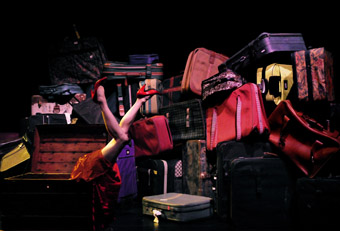
Rebecca Youdell, Cove, Bonemap
photo Suzon Fuks
Rebecca Youdell, Cove, Bonemap
BONEMAP’S COVE, AN IMMERSIVE ‘INTERACTIVE MEDIA ARTS EXPERIENCE,’ FELT LIKE A TEAR IN THE SPACE-TIME CONTINUUM, A PLACE APART, WHERE ERAS OVERLAPPED AND DISSOLVED, AND WHERE I COULD ACCESS MEMORIES NOT ALL MY OWN, BUT ACHINGLY FAMILIAR NONETHELESS. THIS APPARENTLY SIMPLE, BEAUTIFUL AND EVOCATIVE WORK, JUST 10 MINUTES LONG, CREATED A LEISURELY AND TIMELESS SPACE WITH WHICH THE VIEWER COULD INTERACT WITHOUT THE DISTRACTION OF NOTICING THE TECHNOLOGY, STRATEGY AND SWEAT SUPPORTING THE ‘EFFORTLESS’ EXPERIENCE.
My anticipation was heightened immediately at the booking phase when I (and every other viewer) was given an individual timeslot and the luxury of being an audience of one. This was principally due to the limitations of the technology involved (including an infrared tracking system), but Bonemap exploited the strategy fully, erasing the general expectation that numbers are everything in terms of audience. Without feeding off others’ reactions, the single viewer was compelled to rely on their own sensory and psychological responses, allowed to ‘own’ the space and to interact with the set and the solo performer, without interference.
After being primed by an usher while waiting in the foyer—”…movement is rewarded!”—I was led along a corridor to a doorway with a black drape, which built suspense while giving away nothing of what was beyond. The curtain was drawn back to allow me through, and my first brief sensation as I made out the wide circular enclosure of black scrim in the semi-darkness, was of being nine years old, agape in the Melbourne planetarium. I had to look back momentarily to check with the usher whether I should continue further forward. He gestured to keep going, then retreated, closing me in. I tentatively stepped down into the simmering fog of ankle deep dry ice to find that, yes, there was a floor underneath, I was not going to fall through to China. Piles of trunks and suitcases formed the perimeter of the ‘cove’, low in front, rising in hills behind to frame the single entrance/exit.
A moth or butterfly appeared high on the scrim and, following its flight, the ambient soundscape began to intone differently as I moved around the space. The moth was replaced by particles that could have been moondust or fog, and the power of the viewer to affect the projections quickly became apparent. I began to raise and wave my arms and walk back and forth, creating a black ‘hole’ in the fog which followed my movements. Then, mid-wave, the projection faded, an extended world beyond the scrim dawned. A woman in a red satin dress pulling a large travelling trunk was waving back at me.
From the safe haven of my cove, I could see a strange geography, teetering islands of luggage emerging from a suggested sea. The soundscape creaked and bubbled, reverberating with a low throbbing reminiscent of the industry of a port heard from underwater. The slight woman (Rebecca Youdell) continued to slowly make her way along a presumed dock, periodically pausing to squint into the distance as if looking for a familiar face waiting to meet her. If I smiled and waved she responded. Eventually she stopped and gestured at the trunk. I mimed that I wanted her to open it, and she did. Bending forward as if to take something out, she instead slowly disappeared into it, red shoes waving in the air as the scene went to black.
Waves washed against the walls of my cove, leaving me with a thousand questions about the fragile-looking lady in red. Why she was alone? Had she fallen through the world to China? I resumed exploring my space, opening a random case to reveal what looked, in the dim light of the projections, like vintage glass laboratory equipment, which I rapidly attempted to replace as I found.
The world beyond reappeared suddenly, and the woman was back, on one of the hillocks of cases, looking for something. Like an animal, she scrabbled around, sniffing the air, alert and primal even in her civilised finery. She singled out a little red valise, listened to it, then opened it to speak lovingly to something or someone inside. Back to black, back to wondering idly about the narrative I’ve witnessed, while playing with the projections, now clouds.
Then it’s sunset in the world beyond the cove, and the lady in red has transformed into a sea bird flying from the setting sun, her pleated dress now wings, her shadow looming huge on the scrim. She wheels in flight to follow my movement around the cove, as overhead a projected flock joins her migration. The sun sets and I must leave.
Bonemap’s Russell Milledge and Rebecca Youdell are masters at milking the power of suggestion and gesture to create rich visuals and engaging narratives. As they note, “the research funding for this work was focused on technical innovation” (primarily the interactive tracking systems), but they prove once again that technology becomes art when infused with their breadth of imagination. Following themes developed in their earlier work, The Exquisite Resonance of Memory (2008), Cove takes the viewer on a sensory journey through the ambiguous territories of colonisation, displacement, migration and memory, never pinned to a specific time and open to the viewer/interactor to question, interpret and colour with their own experience.
Bonemap, Cove, media design Russell Milledge, performer Rebecca Youdell, sound Steven Campbell, programming Jason Holdsworth; in association with Kick Arts Contemporary Arts and James Cook University School of Creative Arts; JUTE Theatre, Centre of Contemporary Arts, Cairns, April 29-May 1
RealTime issue #97 June-July 2010 pg. 24
© Bernadette Ashley; for permission to reproduce apply to realtime@realtimearts.net
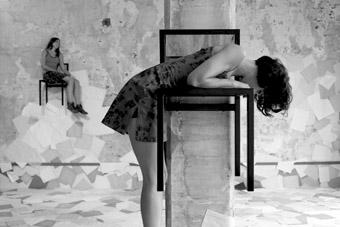
Cinetica
A LARGE CLOUD OF VOLCANIC ASH, SUSPENDED OVER BRITISH AIRSPACE AND SEVERELY DISRUPTING INTERNATIONAL TRAVEL, THREATENED TO CAST A PALL OVER MOVES’ FIVE-DAY PROGRAM, THIS YEAR RELOCATED FROM MANCHESTER TO A NEW AND WELL-RESOURCED HOME BASE AT LIVERPOOL’S BLUECOAT ARTS CENTRE. NOW IN ITS SIXTH YEAR, THE FESTIVAL IS ALSO NEGOTIATING THE POTENTIALLY TRICKY BUSINESS OF REGIME CHANGE, WITH INCOMING DIRECTOR GALA PUJOL AT THE HELM OF AN EXPANSIVE OPERATION, COMMITTED TO A REGION-WIDE, NON-TRADITIONAL SCREENING REMIT; A PAN-EUROPEAN NETWORK OF PARTNER FESTIVALS; AND TO SHOWCASING THE WIDEST POSSIBLE RANGE OF SCREEN-BASED MOVEMENT—WHICH MAY OR MAY NOT INCLUDE ELEMENTS TRADITIONALLY RECOGNISABLE AS ‘DANCE.’
While the ash cloud only succeeded in postponing program from Iceland, Hungary and Portugal to a rescheduled autumn event, a sense of generational handover pervaded every aspect of the festival. Work by a new crop of artists, filtering into mainstream programming, included the shifting subjectivity of Marina Tsartsara’s green-and-gold, meadow-set Through (2009) and the microscopic movement world of Fiona Geilinger’s charcoal-effect Pinstripe (2009). There were excursions into Second Life, the sporadic appearance of mobile phone pixillation—as distinctive as film grain—and the unvarnished immediacy of a YouTube aesthetic mixed with high-end finish from established, international ‘names’, such as Cordelia Beresford’s Sydney-set Night Shift (2009) and Marlene Millar and Philip Szporer’s spotlit, fragile Falling (2009). With additional links to the Watching Dance conference, held in parallel in Manchester, three home-set presentations on “Framing Motion” fielded Kate Sicchio’s notion of programmer as choreographer, composing pixels in frames within frames; Vida Midgelow on the politics of documentation, casting improvised movement as a process of disappearance; and Liverpool-based Gina Czarnecki’s outlining of her professional evolution from painting to film and then video, culminating in a slowed moment—captured in green-tinged night-vision—of close-in, facial transformation, from recent work Spintex (2009).
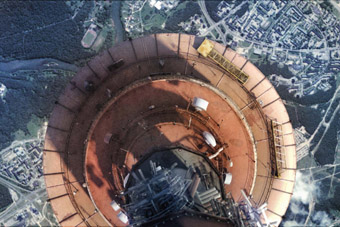
Synchronisation
The newly-introduced Alternative Routes awards resulted in a striking line-up, with first-prize winner Rimas Sakalauskas’ Synchronisation (2009) using the disquieting language of 1960s sci-fi in a slow-burn aggregation of sound and image, with a hollow metal sphere rising slowly, unnoticed, from a children’s play area, and a satellite’s revolving shadows hovering over patchworked landscape. Receiving special mention, a series of luminously monochrome images—an airborne arc of rock; an unearthed sunflower stalk; metal chairs suspended from writing-papered walls—in Ana Cembrero’s Cinética (2009), threaded through episodes of recognisably codified dance, with Thomas Browne’s Aston Gorilla (2009) capturing a young son’s dream image of his football-shirted, ape-masked father through a subtly edited movement language of simian swings and grabs. In addition, highly stylised diary-entry disruptions—the buzz of a house fly, the patterning of leaf shadow—in Marcin Wojciechowski’s Interferences (2009) sat against the graphic simplicity of Stuart Pound’s Dance 0-19 (2009) with its quick-fire progression of doubled, tripled, at times quadrupled numerals, white against a dark screen, illustrating the complex algorithmic workings of an intricate gamelan score.
Addressing issues at the heart of Moves’ identity, and reflecting widespread groundswell of artform shift, festival co-curator Gitta Wigro chaired a roundtable discussion of “Screendance on the Verge,” highlighting the dangers of artificial distinctions imposed around a self-titled niche. Pauline Brooks, of Liverpool John Moores University, outlined her role as facilitator for an emerging generation of screen-literate artists, while Claudia Kappenberg, head of the AHRC Network for Discourse and Publication in Screendance, emphasised the need for a body of informed writing within the field, also setting out her involvement as co-curator in the recent artist-led What If…Festival. Calling attention to the increase in hybridity across all forms, Jamie Watton, Director of South East Dance Agency, also noted the end of the producer-led era, acknowledging artists’ role at the centre of the creative process, with this shift reflected in a change of terminology from ‘screendance’ to the more open-ended ‘screen-based work.’
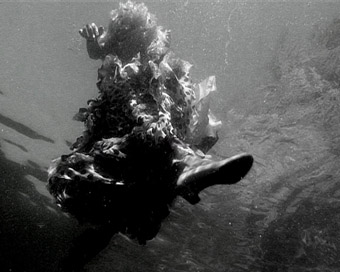
River Dreams
Illustrating this change of emphasis, a range of highly distinctive voices, scattered across scheduling, included Daniel Hopkins’ horizontal arrangement of subway train travel as blue/green stripes of periodic motion blur in Movement #1 (2009); the heightened materiality of Heidi Phillips’ archive footage in Discovering Composition in Art (2008); Richard O’Sullivan’s close-in, time-sliced landscape of rock and tree in Palimpsest (2008); Morgan Beringer’s partially glimpsed world of breakthrough between frames in Abstraction 27 (2009); and the soft fluidity of Betsy Dadd’s pastel lines in 8000 Drawings (2009), achieving a Norman McLaren-like state of never-settled flux. In addition, Sanke Faltien’s smoothly continuous camera motion through road-tunnel-set Queensway (2009) followed film-grained monochrome pathways of snaking white lines and overhead strip lights, and in Beatriz Sánchez’ highly accomplished River Dreams (2009) decontextualised fragments—a heeled, strap-fastened-shoe; the tiered flouncing of a polka-dotted flamenco dress; finger work against guitar fret board—took on the rippled fluidity of an underwater movement state.
In a particularly strong documentary-influenced programme, the deceptively simple surface gaze of Nick May and Ben Holland’s Food Chain (2009) surveyed Escher-like, multi-angled conveyer belts, the repetitive gestural unison of eye-deadened production line workers, and a single, flailing onion. Bronwen Buckeridge’s camera in Lacuna Cut (2009), closed in on the ritual application of mask-like face paint, abstracting to a red spot; a pink stick; encroaching expanses of blue, white and gold. Against the static foreground of a roughly textured field, archive wedding photos and architectural structures in Jonathan Franco’s Living Land (2008) momentarily flash up, and are gone, and in Carlos Amelia’s powerfully understated Tierra Y Pan (2008), slow, outward camera motion locates a dog tied to a post within a wind-whipped, desert-set horizon line, as focus gradually recedes from episodic and unsparing narrative detail, revealing in turn a heavily pregnant woman, a doctor’s bag, a spade.
Near the festival’s end, Daniel Bird’s contextualisation of Armenian filmmaker Sergei Paradjanov’s “dynamic, frenetic” symbolic language in The Colour of Pomegranates (1968) cast a long shadow across scheduling, identifiable in Anne Harild’s Morandi Room (2008), with front-on camera perspective catching the surface sheen of proliferating, differingly-shaped vessels, and the shifting gleams of light on rising water-level. Paradjavnov’s legacy was also evident in the snowset tableau of Galina Myznikova and Sergey Provorov’s Despair (2008) and in the poetic economy of a young female face in greyscale, close-in, slowed-motion, shaking blade-like wettened hair in Myznikova’s The Girl—Helicopter (2008).
Sited throughout the Bluecoat, installations included the linked remote screens of Charlotte Gould and Paul Sermon’s al fresco Urban Picnic, codes for mobile phone downloads created by Salford University students, and the rich visual arrangement of Sara Bjärland’s monochrome dandelion seeds in 80 Movements (2008), with a series of carefully composed slides appearing at rhythmically projected intervals. Across the four-frame line-up of Katrina McPherson and Simon Fildes’ Crux (2009), a quartet of male boulderers—captured in the detail of white-taped fingers, a beaded bracelet, a circular tattoo—attempt the unfakeable physical engagement of sheer exterior ascent, with slow eye scans and sudden drops, reaches for stone ledges and rock shelf and hand holds and finger crevices also recorded in the linear verticality of Laban-notated scores. Elsewhere, a single participant is guided through an immersive audiovisual experience by the intermittent touch of an unseen hand in Clara Garcia Fraile and Sam Pearson’s When We Meet Again, and left to re-enter real space alone with a smile and the gift of a single strawberry.
Viewed from within a landscape of hybridisation and boundary-crossings, Moves is looking like a festival whose time may just have come. Emerging into early evening light, the sky above Liverpool is a bright, clear blue, and not a cloud in sight.
Moves10, Bluecoat Arts Centre, Liverpool & venues throughout the north-west, UK, April 21-25
RealTime issue #97 June-July 2010 pg. 25
© Chirstinn Whyte; for permission to reproduce apply to realtime@realtimearts.net
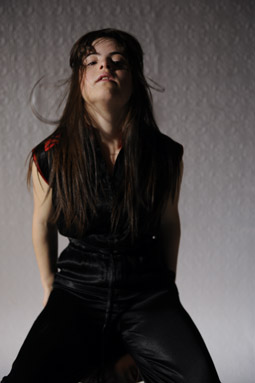
Jianna Georgiou, Sixteen by Sophie Hyde
photo Andy Rasheed
Jianna Georgiou, Sixteen by Sophie Hyde
THIS YEAR’S REELDANCE AUSTRALIA AND NEW ZEALAND AWARDS INCLUDED ALL THREE OF THE MAIN GENRES OF SCREENDANCE: DANCE-DRIVEN ‘DANCE ON CAMERA’ AS SEEN IN STRAND (MICHAELA PEGUM, SIOBHAN MURPHY AND DOMINIC REDFERN), VISUAL ART DRIVEN ‘VIDEO DANCE’ AS IN SHADOW IN BLUE (ZOE SCOGLIO) AND CINEMATIC DANCEFILM AS IN ALMOST ALL OF THE OTHER PRODUCTIONS SCREENED.
This impression of a strong cinematic sensibility comes from the award program being dominated by the work of a filmmaker (rather than a choreographer), Sophie Hyde, who directed three of the 10 works shown. Her works convey their meanings through mise en scene, montage and especially sound scores (by DJ TR!P, an indispensable collaborator). The three films form the Necessary Games ‘triptych’ performed by Restless Dance Theatre in South Australia, a company of mixed ability dancers.
The best of these, Sixteen (choreographed by Kat Worth), won the award for best dancefilm. It’s a sweet portrait of a young woman’s playful, physically expressed encounters with different men. The character’s disabilities are neither the text nor the subtext of the work, they are a given, which is not particularly remarked upon. Instead we are invited, through the frames within frames of a photographer’s studio where the piece is set, to see different qualities of relationship and a girl taking charge of her choices.
Slightly less successful in its creation of drama and relationship is Moth (choreographed by Paul Zikovich), which juxtaposes the moves of a young man with Down’s syndrome against those of a lean and muscular, able-bodied dancer. The pairing of these two, though adroitly shaped, felt a bit strained. That said, Moth had the most brilliant editing of the evening, with cuts creating movement dynamics and patterns of time that are as much ‘the dance’ as the movement of bodies.
The least engaging of the triptych, Necessity (choreographed by Tuula Roppola), was also, to me, the least successful in creating a cinematic experience of movement. It felt more like a recording of a dance than a cinematic construction, using close-ups for the small gestures and wider shots for the bigger gestures. This raises a problem not present in the other two: would I be interested in this if not for the unusual aspect of a disabled person dancing? I would be interested in Sixteen and Moth, but in this one, I wasn’t so sure.
The runner-up prize-winner was Tap Hop Lesson 1 (by Soda Jerk) a mash up of two pieces of archival footage—one a 1930s American movie in which a group of black men entertain the white folks gathered at a glamorous party, the other a 1980s television studio shoot of some guys doing hip hop. We’re invited to compare these alternating scenes, one on the left, the other on the right side of the screen, with little comment, except for their juxtaposition, until the soundtrack from one is laid under the images of the other so the Jazz and Tap of the 1930s becomes the ‘lesson 1’ for Hip Hop of the 80s. Aside from this slight if entertaining insight, this piece does not explore the implications of racial stereotyping and spectatorship to which it alludes.
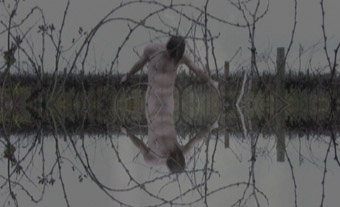
Saint Sebastian, James Welsby
Saint Sebastian (by James Welsby) winner of the “Encouragement Award” is an accumulation of images of lonely, vulnerable men making a strong reference to the eponymous tortured saint. The figures on screen are positioned as objects of beauty and pity, but the images constructed neither use the tools of visual art to create a sensual experience of beauty, nor the functions of cinema which would align us with the figures as characters and allow for the emotional engagement of pity.
The only ‘dance-driven’ piece on the evening was Strand, a sometimes glorious and more often maddeningly frustrating piece for two lovely dancers executing choreography in a sea of desert. There is one stunning camera angle in this piece, a long shot in which the dancing is contextualised in vastness—making it poignant, absurd and, in a way, fierce, in its battle against the odds of the space. But cutting closer in is unmotivated. It displays the dancing, but it frustrates the desire for the cinematic piece this could have been with more canny cuts and characters, or the visual artwork it might have been had it stayed with its one beautiful shot.
The only visual art driven ‘videodance’ on the night, Shadow in Blue, displays a lot of cool stuff that can be done with the effects palette on digital editing systems. But it also raises the question of duration. If the objective is to present a kaleidoscope of effects, shouldn’t it be up to the viewer to decide how long the toy will fascinate? Does the duration of this piece add to its meaning and justify its exhibition in a festival context or would it have more life on a gallery wall?
Motel Of Deception (Chrissie Parrott and Nancy Jones) wryly translates Neo Noir into a cleverly framed and surprisingly acrobatic set of physical relationships while keeping firmly rooted in the genre and the pleasures it affords. The textures of the seedy motel room, the deceptions framed in mirrors, the dance moves creating character and story all make for clever and engaging subversion of both the sincerity of dance (“the body never lies”) and the irony of Noir.
Tank Man Tango (Deborah Kelly) plays with documentary by suggesting that a fragment of news footage is actually a piece of choreography, and then documenting a project in which the instructions for executing that choreography travel the world and become a political ‘flash mob’ dance in commemoration of the victims of military force at Tiananmen Square. Playful yet pointed, this doco and the underlying dance achieve something rare: reminding us to care while adroitly avoiding a scolding.
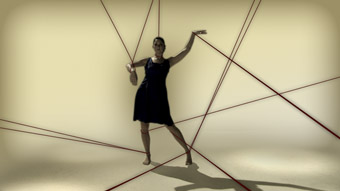
Reading the Body, Sue Healey
Finally, Reading the Body (Sue Healey) one of the most fully realised works of the evening, and certainly the most fluent integration of dance, art and cinema, offers a revelation which only cinema could give us, as well as finely balanced beauty and an articulate and sensitive dance. Healey overcomes the frequently experienced gap in comprehension between the dance and its audience by revealing, with animations, the inside of the body. These revelations are timed and phrased to punctuate, extend and interact with the dancer. The cinematically constructed relationship between the animations and the dancer align us with the character, make us feel what she feels, and give us access to the mysteries of dance.
Judges for the 2010 awards were Ross Gibson, Professor of Contemporary Arts, University of Sydney, Helen Simondson, Manager of Screen Events, Australian Centre for Moving Image, Shona McCullagh, Award Winning Dance on Screen Artist, Clare Stewart, Director of Sydney International Film Festival and Adrian Martin, Senior Lecturer in Film, Monash University.
–
Reeldance Australia & New Zealand Dance Awards, Reeldance Festival, Performance Space; CarriageWorks, Sydney, May 16
RealTime issue #97 June-July 2010 pg. 26
© Karen Pearlman; for permission to reproduce apply to realtime@realtimearts.net
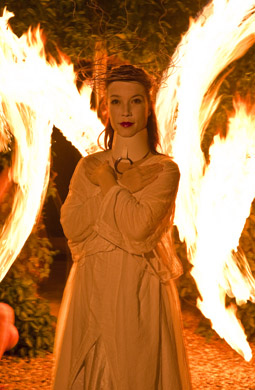
Andrea Jenkins, Dante’s Inferno, Zen Zen Zo
photo Simon Wood
Andrea Jenkins, Dante’s Inferno, Zen Zen Zo
ZEN ZEN ZO HAS BUILT A REPUTATION BASED ON SELF-DEVISED CREATIVE PROJECTS AS WELL AS RADICALLY UPDATED WESTERN CLASSICS. AN ECLECTIC, TRANSDICIPLINARY APPROACH INCORPORATES EASTERN DISCIPLINES SUCH AS THE SUZUKI METHOD AND BUTOH, WITH ELEMENTS OF POP CULTURE THROWN IN FOR GOOD MEASURE. BOTH STRANDS ARE APPARENT IN THE PRODUCTION OF DANTE’S INFERNO FOR THE IN THE RAW STUDIO SEASON AT BRISBANE’S OLD MUSEUM. THIS IS A SHOWCASE FOR GRADUATE STUDENTS FOLLOWING THEIR SIX-MONTH INTERNSHIP PROGRAM AND FEATURED GUEST CANADIAN DIRECTOR STEPHEN ATKINS WHO ALSO LAUDABLY UNDERTOOK THE TRAINING.
The Neo-Gothic edifice of Brisbane’s Old Museum was an eminently suitable site for a production styling itself as living hell. Despite the dire warnings of gypsy fortune tellers, the milling crowd outside the museum was soon gathered up by our Tour Guides, a pair of bubbly air hostesses with a perfect grasp of airborne vernacular who escorted us with torches over uneven ground to Hell’s Gates. Here we were confronted by a charivari chorus of the damned, Hell’s buskers, a foretaste of torments in store. We passed promenade-wise through an arching tunnel in a hedge into Hell itself. First stop, Limbo: four actors in perpetual circular motion, stepping up and down and around on blocks representing an endless gym for the soul. And so on through a series of installations in the grounds depicting interpretations of Dante’s sins including the third (the gluttonous), fourth (the avaricious/spendthrifts) and fifth (the melancholic) which were sometimes obvious, sometimes merely enigmatic and sometimes deadly as in the Night of the Living Dead.
At this point in the first circle of Hell where Dante depicts the eternal lovers, Francesca and Paolo, damned because they would not abandon their human, fleshly love for the love of God, the company seems to have flinched from exploring Dante’s sympathetic and complex examination of a situation reflecting his adoration for his ideal love, Beatrice. Instead we are treated to a quartet of reanimated souls enacting a post-Brechtian, cabaret-style ballad about their sordid and murderous lust for gold. Quibble aside, so far it has been an entertaining stroll through the grounds of Hell until the atmosphere changes after the deaths of our ebullient guides. We are abandoned, lost and barred by demons from continuing our journey through the realms of the Middle and Lower Hells, yet the only way out is down.
Our guiding light appears in the form of a shining angel, a striking figure of sculptural serenity, who is surely Beatrice as she appeared to Dante. Entering the building, the massive enclosure of the performance space dictates a different response. We no longer have the freedom of bystanders, fair-goers, or separate observers and feel threatened by the sheer proximity and physicality of the performers and the darker nature of their sins, which feel intimately personal. We witness a violent orgy of rape and pillage until herded by these truly damned souls into witnessing our own capacity for violence, masochistic self-harm and despair culminating in the sin of suicide startlingly portrayed by an instantaneous descent of two chairs on the end of ropes. Our attention is refocused by two girls sweetly singing a plaintive lament as a coda and then to self-deception within a loveless relationship until the alienated pair rise from the breakfast table to act out their onanistic fantasies. The final scene is a mechanistic office version of the treadmill of work encapsulated in Fritz Lang’s 1927 film Metropolis. We are invited to our first day on the job as we leave through a maze of candle-lit corridors to the Exit which is No Exit.
Last year Zen Zen Zo’s production of Shakespeare’s The Tempest turned powerfully on an interpretation based on contemporary post-colonial discourses and as a result won the Matilda Award for Best Independent Production in 2009. The rather fragmented nature of their current showing lacked such an underlying concept—a big ask, I know, when the original is such a monumental work and such a strong product of the Western medieval mindset. In part, the site-specific use of the Old Museum aptly stood in for the towering architecture of Dante’s Catholic faith which was the foundation of his epic poem but by shearing away Dante’s basic beliefs, rendering them simply as metaphors for life, this treatment risked destabilising the whole structure. Perhaps the trouble lay in the way the performance text was constructed. According to Atkins each and every cast member was given a snippet of the poem and told to go away and creatively interpret it. The results were assembled and the final shape of the piece collectively decided upon. However, I suspect it would take a true, mad heretic of the stature of Neitzche’s Zarathustra to perform such a cut and paste. Nevertheless, Zen Zen Zo’s characteristic energy and the unflagging focus of the ensemble playing was impressive in covering such huge territory on such rough ground. Dale Hubbard’s music was impressive and subtly modulated, and like Beatrice in many guises it led us through the production. The technical team also dealt adroitly with big outdoor stuff.
The classics, of course, can ask the questions that are often shouldered aside in the brutal tempo of modern life. But if so, the questions and not necessarily just the answers need to be recast in order to be relevant. I found the final ‘Metropolis’ scene (which I know some felt to be anticlimatic) the most replete from this aspect, with its icy promise of an unending corporate eternity which will lead us all, ironically soon enough, into the fiery furnace of the fundamentalist imagination so that the world ends, as TS Eliot predicted, not with a bang but a whimper.
Dante’s Inferno, devised by Zen Zen Zo Physical Theatre Company members and 2010 interns, dialogue Stephen Atkins, director Stephen Atkins, designer Alan John Jones, lighting designer Ben Hughes, composer Dale Hubbard, performers Zen Zen Zo Physical Theatre Ensemble, Brisbane Old Museum, May 6-22
RealTime issue #97 June-July 2010 pg. 7
© Douglas Leonard; for permission to reproduce apply to realtime@realtimearts.net
{$slideshow} CHARACTERISTICALLY, AIMEE SMITH CONCEIVES WORKS ON A SINGLE SOCIAL CONCERN. IN BREAKINGS IT’S THE RAMIFICATIONS OF BEING IMMERSED IN MEDIA-DEFINED HYPER-REALITIES. IN THE BEST OF HER WORKS, A RIGOROUS CLARITY OF PURPOSE EITHER PUMMELS THE IDEA UNTIL ITS TENETS COLLAPSE (WAITING FOR THE REVOLUTION, 2009) OR THE SURFACE IDEA FRACTURES INTO ITS INEVITABLE INTERPRETIVE MULTIPLICITIES (REFUND POLICY, 2007, AND ACCIDENTAL MONSTERS OF MEANING, 2009).
Smith’s first full-length work, Breakings, driven by schizophrenic responses of the character/performer, both affirms the array of options given by the media-dominated environment and closes down personal agency in a claustrophobic deadend of failure and loneliness. The unforgiving perspective enfolds the terminable condition of an isolated individual brought about by virulent bombardments of realities from somewhere beyond word and screen.
The cornered life begins in a tightly set bed-sit, plastered with newspaper across every conceivable surface and furbished at appropriate points with electronic screens. Pathological obsession lurks as paper and text, image and pronouncements operate in juxtaposition with Smith to enact curious metaphors and misplaced relationships. The morning alarm rings and the screen image is switched off before Smith rises to extract cat food from the screen fridge for the screen cat. Normality pervades the Baudrillardian simulacra-scape without missing a monotone 2D beat.
Beginning with the normal action of reading the morning’s paper Smith then travels the room’s dimensions devouring endless printed edicts with an increasing avidity that drags the body in its wake. It is as if spectators are taken on a pocket-compact history of human engagement with the media, suggesting a viral susceptibility to information born with the invention of print. Fuelled by a compulsion to know as much and as quickly as is possible, the quick-fix ingestion is serviced by the production’s innovative and deceptively simple technologies that extend word into sound and pictures. Screens, formerly stand-ins for reality, splutter into action and project images and statistics of atrocities in the same breath as seductive views of glamour and success. Media has, in a sense, acquired its proper stride or, more tellingly, its crazed flight. Death and mutilation interpenetrate sexual allure with a speed and ease which is played out by Smith’s corporeal appropriation of collisions of horror and hope. Smith’s body becomes the site of abuse, penetrated by an artillery of information with scant regard for human comprehension.
Entrapment folds to a false quietude, when Smith, the achingly human young woman, moves within an isolated rectangle of coloured light. The movement sheds its frenzy to become calm and beautifully fluid until spectators realise that this light is nothing more than a television test pattern. What seems like a respite from affliction sours into the affliction itself: the human individual is but a standby pattern before the main action begins. In such an impasse, a human soul is a mere figment of broken desire. The ending is thus forecast long before the screen lights emit evidence of cross-wiring malfunction. Unfed screen cats and deformed and abused children share a similar fate with their co-performer, Smith; they are shattered and extinguished though, unlike her, they are never immune, in their digital sanity, from relentless replication and projection.
Breakings does not end when the lights go out but extends through post-performance forums, designed not so much to elicit reflection on the production as to promote dialogue on issues raised between Smith, guests from academia, arts and the media, the affable facilitator James Berlyn and the audience. I suspect the exchanges will focus on Smith’s singular focus which omits all trace of the new media’s democratic activism and social networking and thus can cast Breakings as a throw-back to the days of media-mogul control. However, such questioning can explore artistic storytelling, utilising, ironically, the tactics of social networking to probe Smith’s approach, enabling its singularity to provoke a diversity of ideas.
Breakings may not have plumbed the full range of media intervention into our lives but it has pushed feeding the cat into a peculiarly revealing—and perhaps enunciated—can of digital worms.
One paradoxical worm raised by Breakings involves questions about the capacity of dance and dancers to portray mental and bodily disintegration. The physical fitness and beauty of dancers (if not the whole philosophical/psychological basis of the discipline) inhibits grotesque or undesired states like damage and decrepitude. Entanglement in beauty facilitates a sense of identity loss in the performer but, at the same time, impedes the more distressing schizophrenic disability which seems to be in Smith’s sights. The screen cat in spite of screen and reality confusions remains cute and Smith carries her breaking perhaps too eloquently to convey unhinged reality.
Breakings, choreographer, performer, audio visuals Aimee Smith, sound Ben Taaffe, lighting Mike Nanning, video mapping Jerrem Lynch, set design Bryan Woltjen, set & costumes Fiona Bruce, outside eye Michael Whaites, co-produced by Performing Lines WA and STRUT dance; PICA, Perth, April 8-11; www.aimee-smith.com/blog/
RealTime issue #97 June-July 2010 pg. 28
© Maggi Phillips; for permission to reproduce apply to realtime@realtimearts.net
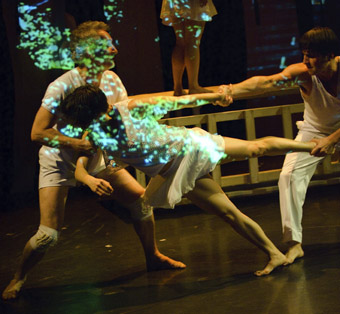
Pomona Road
photo Nick Lane
Pomona Road
MAYBE THEY’RE CALLED NUCLEAR FAMILIES NOT BECAUSE THEY CLUSTER AROUND A STABLE CENTRE BUT BECAUSE THEY COLLIDE AND SCATTER, DESCRIBE ORBITS. BECAUSE OF THEIR PUSH-PULL OF ATTRACTION AND REPULSION. BECAUSE AT THE HEART OF FAMILY IS NOT STABILITY BUT A NEVERENDING CLEAVING TOGETHER AND FLYING APART. ENERGY THAT DISASSEMBLES BUT IS NEVER DESTROYED. KATRINA LAZAROFF’S POMONA ROAD ASKS WHAT HAPPENS WHEN THESE FLUID CONFIGURATIONS COLLIDE WITH THE BLANK WALL OF TRAUMA.
Lazaroff has cast her dancers as an archetypal family: Mum, Dad, the two sisters and a brother, an ‘every family’ that allows an audience to examine the questions that come with each disaster—What would I do? How could we, would we survive?
Trauma here comes as the destruction of the family home by bushfire and its elision of history and identity. The family is cut loose, each member forced to reimagine themselves, and it’s this territory that Pomona Road charts. The dynamic energy of family and eruptive trauma combine as a double helix propelling Pomona Road in a play between dissolution and stability.
The pivotal event of the bushfire is one from Lazaroff’s own history: her family lost a home to fire in 1980 and lived through the 1983 Ash Wednesday bushfires. This intimacy and assuredness with the material pervades the work. The spoken recollections from family and friends of their bushfire experiences provide an overarching narrative structure which drives and frames the action as well as providing historical specificity.
Pomona Road’s strength lies in the quality and integration of its elements. Choreography that keeps the dancers in almost constant motion captures a sense of particles moving. The immersive and evocative projections of Nic Mollison, the fine set design by Kerry Reid and Richard Seidel, Sascha Budimski’s driving and atmospheric score and the dramaturgy of Catherine Fitzgerald all contribute to the work’s tight storytelling.
Time and place are called forth through projections—TV shows, the bush and later flames, sparks, drifting leaves and wallpaper patterns over monumental cut-out tree shapes arranged around the space. There are the sounds of local radio, the susurration of trees and narrators recollecting the beauty and danger of the hills.
Lazaroff deploys her dancers in dissolving and reforming constellations marking out relationships and alliances. Dad and Mum economically describe a duologue of power, the girls pull each other into and out of orbits, father and son raise fences, tumble and grasp. Flying off, regrouping, they graze past each other, tracing out all the lineaments of family.
Like classical tragedy, momentum runs towards and away from the inexorable fact of the fire. Jagged synthesiser motifs and sonorous drones prefigure the fire’s arrival— “It’s gonna get us this time.” Drowning in flames the family frantically cross and recross each other’s trajectories, a dense interwoven panic climaxing with the father screaming silently, consumed by flames, the family at his feet.
As Antigone discovers in Anouilh’s tragedy, it’s not the event that matters but the aftermath where the tragedy unfolds. Against luminous burnt trees and floating home-plans that mark out the characters’ bodies as rooms—‘bedroom,’ ‘bath,’ ‘living’—trauma recurs as sparks and flames overlay and leak into their new, fragile ‘normal.’
A daughter shakes out a joyless little shimmy as the family don cast-off clothes — “Thank the nice lady.” Fat electronica builds anxiety as dreams of a new home dissolve into fire with the family becoming a mesh of hard diagonals on the floor, arms and legs thrown up in the air, verbal ejaculations like involuntary physical tics: “I have to do everything,” “It’s not my turn,” “He started it.”
Balanced against incipient chaos is a neat invocation of the family car, the only fixed point in all this loose energy. Dad drives, Mum as passenger, kids in the back. Pre-fire they bicker to sweet guitar pop, lean into the curves together, working as a unit. In the cold aftermath, eyes shut, isolated, they lean forward, lean back, stop cold in shock.
Moving through this post-bushfire world, in the way we get hooked on songs that speak to certain moments in our lives, we hear Gerry Rafferty’s “Baker Street.” Its nostalgia doubly captured in time, the song becomes an obsessive refrain of loss and longing: “And when you wake up it’s a new morning, the sun is shining it’s a new morning. You’re going, you’re going home.”
Circling around their vanished property, looping through the event, the family endlessly draw themselves to their own centre—“You’re going home.”
Pomona Road, director, choreographer, producer Katrina Lazaroff, performers Carol Wellman, Peter Sheedy, Veronica Shum, Emma Stokes, Zac Jones, lighting, projection, design Nic Mollison, set design Kerry Reid, Richard Seidel, sound design Sascha Budimski, dramaturg Catherine Fitzgerald, voiceovers Nick and Stena Lazaroff, Chris Lazaroff, Margie Hann Syme, Trevor Syme; presented in conjunction with Adelaide Festival Centre’s inSpace program; The Space, Adelaide Festival Centre, April 21-24
RealTime issue #97 June-July 2010 pg. 28
© Jemima Kemp; for permission to reproduce apply to realtime@realtimearts.net
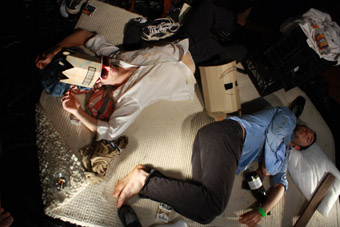
Robbie O’Brien, Tom McCosker, Room 328
photo John Feely
Robbie O’Brien, Tom McCosker, Room 328
room 328: drunk performance
Director and producer duo Daniel Santangeli and Genevieve Trace and an ensemble of physical theatre and circus trained performers “not afraid to touch their audience” premiere Room 328 at Brisbane’s Metro Arts July 6-10. The show is “a response to current social rhetoric around alcohol-fuelled violence and Brisbane’s stringent drinking laws (lockout included)…We wanted to put the audience into the centre of this experience. When you walk into this show, it’s like entering a nightclub. You don’t sit down, you are surrounded by performers and sometimes you can’t even see your hand held out in front of you.” The production’s focus is “on the male experience of the issue…the type of lost men who throw the first punch, wear ties and take pills”, but the artists promise the picture won’t be one-dimensional. (Is young female drunken violence then a different phenomenon, perhaps one deserving its own show?) Choreography will be by Liesel Zinc, music by bass guitarist and keyboard player Mike Willmett from local indie band My Fiction and setting by local interior designer Elise Terranova. Among the seven performers is Skye Gellman of Scattered Tacks (see article) fame. Director Daniel Sanatangeli’s track record includes the immersive DJ While You Sleep (created with Lawrence English and Joel Stern). There’ll be no sleeping in Room 328, unless you pass out. Room 328, The Galleries, Metro Arts, Brisbane, July 6-10, www.metroarts.com.au
under milkwood: virtually real
Dylan Thomas’ radio classic, Under Milkwood (I grew up on the recording featuring Richard Burton as the ‘first voice’ and read the role in a high school stage production), is a headily poetic rendering of the eccentricities, sadnesses and sins (the sexual ones were excised from our school production) of a small Welsh community. In whatever format, on air, filmed (1972 with Burton, Elizabeth Taylor, Peter O’Toole et al) or staged it’s a work ultimately for listening, a reverie devoid of conventional dramatics, taking us deep into the dreams of the inhabitants of Llareggub (‘bugger all’ backwards). As a stage work, Under Milkwood has had a limited career. But perhaps a new version with one performer manifesting all the roles in real and virtual formats might well capture the work’s sense of free-floating interiority. Filmmaker Vanessa Hughes is directing and has created the media world (with some intriguing visual collaging) that performer and co-creator Zoe Norton Lodge will inhabit as some 64 characters (half of whom are substantial). It’s a bold approach with fascinating potential “to begin (again) at the beginning.” Bambina Borracha Productions, Under Milkwood, Sidetrack Theatre, Marrickville, Sydney, July 1-18, bookings 02 9550 3666
increased funding for nsw arts
NSW Arts Minister Virginia Judge has announced, “An extra $3.5 million will support additional performing arts tours, new works and foster further development in the small-to-medium arts sector” (Press Release, Budget 2010-11, June 8). Coming so soon after Judge’s consultative meeting with the small to medium performing arts sector (as reported in “Talking with the Minister“) this was very welcome news.
There’s also $1m (of $4.5 million over four years) “towards the acquisition of Pier 2/3—the last undeveloped wharf in the performing arts precinct of Walsh Bay.” Let’s hope, and lobby, that this vast wharf not be subdivided into conventional theatre and gallery spaces or controlled by neighbouring major performing arts companies but kept flexible for experimental ventures, festivals and biennales.
There’s also $1.5 million in recurrent funding for CarriageWorks at Eveleigh, “cementing its place as the hub of the State’s small-to-medium contemporary creative sector”, but presumably no increase to allow the venue (or its principal resident, Performance Space) to become a serious producer rather than a venue for hire. Without such an investment how will CarriageWorks ever grow?
Other organisations have benefited substantially. There’s “a total investment of $13 million in the $53 million redevelopment of the Museum of Contemporary Art, $2.91 million over three years for the Sydney Film Festival, a total investment of $2 million through to 2014 for the Sydney Writers’ Festival and $1.75 million a year through to 2014 for Sydney Festival First Night.” And Judge announced at the Biennale of Sydney launch a substantial funding hike for that event too.
Whatever questions are raised by the arts budget, including just how the small to medium sector funding will be allocated, it’s encouraging to see Minister Judge continuing to be responsive to the needs of NSW artists.
parramatta: creative city
Funding from the 2010-11 NSW arts budget “to develop creative enterprise hubs within the Parramatta CBD” has boosted this western Sydney centre’s ambition to be “a creative city.” Parramatta City Council Lord Mayor Paul Garrard said the project, “jointly funded by Council and the NSW Government, will profile Parramatta as a leader in the creative industries by transforming disused commercial premises into innovative spaces for artists and other creative practitioners to create, exhibit and sell their work” (Press Release, June 16). This funding will add further low cost artist spaces to the existing Parramatta Artists Studio and Connect Studios.
cairns cultural precinct
As a result of strong campaigning from Cairns Regional Council, the Cairns Arts and Cultural Sector (including Arts Nexus), and the wider Cairns community, the Queensland government has announced an initial investment of $42.5m for a cultural precinct for this far north Queensland city. The facility will include a performing arts centre (with a main auditorium of 1,000 tiered seats, a flat floor, flexible performance space with 300 to 350 retractable seats and a rehearsal facility that can accommodate up to 100 seats), a museum and a public plaza for open-air performances large scale and intimate. The centre’s performance space design “is influenced by western and Indigenous culture, combining the concepts of the amphitheatre and the Bora Ring. These concepts are evident in the unique functionality of the Centre, including fully retractable walls, which take advantage of the outlook across Trinity Inlet and allows for an open air performance experience” (Press Release, June 8). The museum “will be dedicated to the presentation and exploration of the vibrant and diverse culture and history of Far North Queensland with a focus on Aboriginal and Torres Strait Islander culture and history.” In a city with limited performing arts facilities the new centre will doubtless be a great asset for local and visiting innovators.
www.cairns.qld.gov.au/content/CulturalPrecinct/index.html
emptyspaces nsw
Inspired by Marcus Westbury’s Renew Newcastle initiative, on June 7 the NSW government, as an integral part of their emptyspaces program, launched a new website service designed to promote ‘pop-up’, short-term re-uses of empty shops and other spaces for creative and community uses around the state. “The website is part of Arts NSW’s work on Creative Enterprise Hubs [that] operate in temporary low cost or free premises provided by commercial property owners, local governments and communities to artists and arts groups looking for space to produce, deliver and consume arts products and experiences.”
Emptyspaces is hosted by UTS Shopfront as part of the Cultural Asset Mapping in Regional Australia (CAMRA) project. The site “includes a Toolkit of information sheets and resources developed with the Arts Law Centre of Australia and the NSW Department of Planning, case studies of empty space initiatives in NSW, nationally and internationally, a community space for sharing information, maps of projects and spaces and the capacity for empty spaces to be logged.” According to Kim Spinks, Manager, Capacity and Development, Arts NSW has held briefings on Creative Enterprise Hubs in Lismore, Parramatta, Lithgow, Port Kembla and Gosford with further briefings to be held in Wagga Wagga on July 19 and in Leichhardt and Wollongong. The Emptyspaces Project Manager is Lisa Andersen, Community Engagement Coordinator,?UTS Shopfront Community Program,?02 9514 2902, lisa.andersen@uts.edu.au; http://emptyspaces.culturemap.org.au/
RealTime issue #97 June-July 2010 pg.
© RealTime ; for permission to reproduce apply to realtime@realtimearts.net






















































































